The History of Art
GA 292
II. Leonardo, Michelangelo and Raphael
1 November 1916, Dornach
In our last lecture we showed the period of Art which finally merged into that of the great masters of the Renaissance. We ended by revealing the connecting threads in the artistic world of feeling, which finally led up to what was so wondrously united in Leonardo, in Michangelo and in Raphael. Yet at the same time, in these three masters we must also see the starting point of the new age, in an artistic sense. It is the dawn of the 5th post-Atlantean age, which is heralded in the realm of Art. All three were living, at the beginning of the 5th post-Atlantean age. Leonardo was born in 1452, Michelangelo in 1475 and Raphael in 1483; Leonardo dies in 1519, Raphael in 1520, and Michelangelo in 1564. Here we find ourselves at the starting point of the new age. At the same time, something is contained in these artists which we must undoubtedly regard as a culmination of the spiritual stream of preceding ages, inasmuch as they poured their impulses into the realm of Art. It is true, my dear friends, that in our time people have little understanding for what is important in this respect, for in our time—I do not say this as mere criticism—art has been far too much expelled from the spiritual life as a whole. It is even considered a failing of the historian or critic, if he seeks once more to give Art its place in the spiritual life as a whole. People say that our attention is thus diverted unduly from the artistic or aesthetic impulses as such, attaching an excessive value to the content, to the subject-matter, and yet, this need not be the case at all. Indeed, it is only in our own time that this distinction has acquired so much importance. It had no such direct significance in former epochs—epochs when the artistic understanding was more developed in the ordinary common sense of the people. We must not forget how much has been done to extirpate a true artistic understanding by all the atrocities which have been placed before the human mind of men in recent times, by way of pictorial representation and the like. True understanding for the manner of representation has been lost. European humanity, in a certain sense, no longer cares how a given subject-matter is presented to it. In wide circles, artistic understanding has to a large extent been lost.
Speaking of former epochs, and especially of the epoch to which we are now referring, we may truly say artists such as Raphael, Michelango and Leonardo were by no means one-sidedly artistic, but carried in their souls the whole of the spiritual life of their time and created out of this. In saying this, I do not mean that they borrowed their subject-matter from the spiritual life of their time. I mean far more than this. Into the specifically artistic quality of their creation, in form and colouring, there flowed the specific quality of the world-conception of that time. In our time, a world-conception is a collection of ideas which can, of course, be represented in sculpture or in painting and it is frequently embodied, needless to say, in forms and colours and the like which to the true artistic sense will nevertheless be an atrocity. In this respect, unfortunately, we must repeatedly utter warnings, even within our anthroposophical stream of evolution. The feeling for what is truly artistic is not always prevalent among us. I still remember with a shudder how at the beginning of the theosophical movement in Germany a man once came to me in Berlin, bringing with him reproductions of a picture he had painted. The subject was: Buddha under the Bodhi Tree. It is true there sat a huddled figure under a tree, but the man—if you will pardon me the apt expression—understood as little of Art as an ox, having eaten grass throughout the week, understands of Sunday. He simply thought, here is the subject; let us paint it, and it will represent a work of Art. Of course, it represented something. Namely, he who imagined the scene to himself—“Buddha under the Bodhi Tree”—could see it so, no doubt. But there was absolutely no reason why such a thing should ever have been painted.
It is a very different thing when we say of Leonardo, Michelangelo and Raphael, that they bore within them the whole way of feeling which permeated the Italian civilisation of their time. For this civilisation entered livingly into the artistic quality of their work, into their whole manner of presentation; nor can we fully understand these artists if we have no feeling for the civilisation in the midst of which they lived. Today, indeed, people believe the most extraordinary things. They will believe, for instance, that a man can build a Gothic church even if he has not the remotest notion of High Mass. Of course, he cannot do so in reality. Or they believe that one can paint the Trinity even if one has no feeling for what is intended to be living in it. In this way, Art is expelled from its living connection with the spiritual life as a whole. At the same time, on the other hand, people fail to understand the artistic element as such, imagining that with aesthetic views and feelings which happen to be prevalent today they can set to work and ciriticise Raphael or Michelangelo or Leonardo, whose whole way of feeling was quite different. It was only natural (though I should need many hours to say in full what should be said on this point), it was only natural for them to be living in the whole way of feeling of their time. We cannot understand their creative work unless we understand the character which Christianity had assumed at the time when these artists blossomed forth. You need only remember that at the end of the 15th and beginning of the 16th century Italian Christianity witnessed the rise even among the Popes, of men who truly cannot be said to have satisfied even the most rudimentary demands of morality, nor need one be in any way a pietist to say so. And, of course, the whole army of priests were of like character. The idea that a specific moral impulse must be living in what goes by the name of “Christian” had been lost sight of, comparatively speaking. And when in later times it emerged again—in pietist and moralising forms, by no means identical with what I described the other day when speaking of St. Francis,—it was imbued with quite a different feeling of Christianity than inspired those who lived, for instance, under an Alexander VI, a Julius II or a Leo X. If, on the other hand, we consider the Christian traditions, the concepts and ideas (and when I say ideas I include “Imaginations”) connected with the Mystery of Golgotha, we find them still living in the souls with an intensity of which the man of today has little notion. Human souls lived in the ideas connected with the Mystery of Golgotha, as in a world that was their very own, and they saw Nature herself in the midst of this same world. We need but call to mind: In that time, even for the most educated, this Earth, of which the Western half was still unknown (or was only just begining to be known and was not fully really reckoned with),—this Earth was the centre of the whole Universe. Going down beneath the surface of the Earth, one found a subterranean kingdom; going but a little way above, a super-earthly. We might almost say, it was as though a man only need lift his arm, to grasp with his hand the feet of the heavenly beings. Heaven still penetrated down into the earthly element. Such was the conception—a harmony, an interplay of the spiritual above and the Earth beneath it, with the world of the senses which contained mankind. Even their view of Nature was in this spirit.
Those, however, among whom we find the three great masters of the Renaissance were striving forth from yonder age. And the one who harbours within him, as in a seed, all that came forth since then—nay, much that is still destined to come forth,—that one is Leonardo. The soul of Leonardo was equally inclined to the feelings of the former time and of the latter. His soul had most decidedly a Janus head. By his education, by the habits of his life, by all that he had seen, he lived with his feelings still in the olden time. Yet he had a mighty impulse to that conception of the world which only came forth in the succeeding centuries. He had an impulse, not so much towards its width as to its depth. From various indications in my other lectures, you know that the Greeks—and even the men of later times during the 4th Post-Atlantean age—knew life quite differently than we do,—that is to say, out of a different source of knowledge. The sculptor, for example, knew the human figure from within—from a perception of the forces that were at work within himself, the forces which we today describe in Anthroposophy as the etheric. Out of this inner feeling of the human figure the Greek artist created. In course of time this faculty was lost. Another faculty now had to appear: the power to take hold of things with outward vision. Man felt impelled to feel and understand external Nature. I showed you last time, how Francis of Assisi was among the first who sought to perceive Nature through a deep life of feeling. Now Leonardo was the first who endeavoured in a wider sense to add to this feeling of Nature, a conscious understanding of Nature. Because it was no longer given to him, as to the men of former ages, to trace from within outward the forces that are at work in man, he tried to know these things by contemplation from without. He tried to know by outward vision what could no longer be made known by inward feeling. An understanding of Nature as against a feeling for Nature: this is what distinguishes Leonardo da Vinci from Francis of Assisi, and this determines the whole constitution of his spirit. He was all out to understand. And though we need not take it word for word—for the sources, as a rule, relate only the current legends—nevertheless, the legends themselves were founded upon fact, and there is truth in it when we are told how Leonardo took especial pains to study characteristic faces, so that by dint of outward contemplation the working of the formative forces of the human organism might become his own inner experience. Often he would follow a character about for days and days, so that the human being might become as if transparent to him, revealing how the inner being works into the outer form. Yes, there is truth in this,—and that he invited peasants to his house and set before them tasty dishes or told them stories, so that their faces assumed every possible expression of laughter and contortion and he could study them. All this is founded upon fact. And when he had to paint a Medusa he brought all manner of toads and reptiles into his studio, to study the characteristic animal faces. These are legendary anecdotes; and yet they truly indicate how Leonardo had to seek, to discover the mysterious creation of Nature's forces. For Leonardo was truly a man who sought to understand Nature. He tried in an even wider sense to understand the forces of Nature as they play their part in human life. He was no mere artist in the narrower sense of the word; the artist in him grew out of the whole man, standing in the very midst of the turning-point of time. The church of San Giovanni in Florence had sunk a little, owing to a subsidence of the soil. He wished to raise it again—a task that could easily be carried out today; but in that time such a thing was considered absolutely hopeless. He wanted to have it raised bodily, as it stood. Nowadays, as has justly been observed, it would only be a question of the cost; in his time it was an idea of genius, for no one beside Leonardo thought such a thing was possible. He also thought of constructing machines whereby men would be able to fly through the air; and of irrigating great areas of swamp. He was an engineer, a mechanic, a musician, a cultured man in social intercourse, a scientist according to his time. He constructed apparatus so unheard-of in that age that no one else could make anything of them. What poured into his artist's hand was working, therefore, from a many-sided understanding of the world. Of Leonardo we can truly say, he bore his whole Age within him, even as it came to expression in the profound external changes which were then enacted in Italy. Leonardo's whole life—his artistic life included—bears the stamp of this his fundamental character. In spite of the fact that he grew out of the Italian environment, he was not altogether at home there. True, he was a Florentine, but he spent only his youth in Florence, and then went on to Milan, having been summoned thither by the Duke Ludovico Sforza—sommoned by no means (as we might naively imagine) as the great artist whom we recognise in him today, but as a kind of court entertainer. From the skull of a horse, Leonardo constructed an instrument of music, from which he enticed various notes, and was thus able with great humour to entertain the ducal house. We need not say that he was intended as a kind of “fool,” but as an entertainer to amuse the Court, most certainly. The works of Art which he produced in Milan, to which we shall presently refer, were certainly created out of the very deepest impulse of his own being. But he had not been summoned to the Court of the Sforza's for this purpose; and though he entered well into all the life at Milan, we find him afterwards, on his return to Florence, working at a battle-picture, intended to glorify a victory over Milan. Then we see him end his life at the French Court.
The one dominating impulse in Leonardo is to see and feel what interests the human being of his time; the political events, complicated as they were, more or less swept past him. He only skimmed off them, as it were, the uppermost and human layer. Indeed, in many respects he rather gives us the impression of an adventurer, albeit one endowed with colossal genius. He bears his whole Age within him; and out of this feeling of his Age as a whole, his creations arise. We shall present them not in chronological but in a freely chosen order, for in Leonardo the main point is to see how he creates out of a single impulse, and for this reason the chronological sequence is less important.
An altogether different nature, though possessing the characteristics of the Renaissance in common with him, was Michelangelo. If we can say of Leonardo that he bore the whole forces of his time within him (and for this very reason often came into disharmony with it and remained misunderstood, just because he understood it in its depths, in the forces that only found their way to the surface during later centuries), of Michelangelo, on the other hand, we may say: he bore within him, above all, the Florence of his time. What was the Florence of his time? It was, in a sense, a true concentration of the existing order of the world. This Florence he bore within him. Unlike Leonardo, he did not stand remote from political affairs. The complicated political events around him—and the whole world-order of that time played into these politics—entered again and again into the soul of Michelangelo. And when again and again he went to Rome, he bore his Florence with him, and painting and sculpting a Florentine element into the Roman setting. Leonardo bore a universal feeling into the works he created; Michelangelo carried a Florentine feeling into Rome. As an artist he achieved a kind of spiritual conquest over Rome, making Florence arise again in Rome.
Thus Michelangelo entered intensely into all that was taking place through the political conditions in Florence during his long life. We see this in the succession of his life-periods. As a young man, when his career was only just beginning, he witnessed the reign of the great Medici, whose favourite he was, and by whose favour he was enabled to partake in all that the Florence of that time could offer to a man's spiritual life. Whatever of ancient Art and artistry was then available, Michelangelo studied it under the protectorate of the Medici; and it was here that he produced his earliest work. Indeed, he loved his protector, and grew together in his own soul with the soul-nature of the Medici. But presently he had to realise that the sons of his patron were of quite a different kind. He who had done so much for Florence—out of an ambitious disposition, it is true, yet cultivating largesse and freedom—died in 1492; and his sons proved themselves more or less common tyrants. Michelangelo had to experience this change in comparatively early youth. Whereas at the beginning of his career the mercantile spirit of the Medici had allowed free play to Art, he must now witness this mercantile spirit itself masquerading as a political spirit, and striving towards tyranny. Yes, he witnessed on a small scale the rise in Florence of what was afterwards to take hold of all the world. It was a terrible experience for him, and yet not unconnected with the whole surrounding world of the new Age. It was now that he first went to Rome, and we may say: In Rome he mourns the loss of what he has experienced as the true greatness of Florence. We can even recognise how the plastic quality of his work is connected with this great change in his feelings: Into the very line we notice what the political changes in Florence had brought about in his soul. Any one who has a deeper feeling for such things will see in the Pieta in the Vatican a work which in the last resort is born out of the mourning soul of Michelangelo—Michelangelo mourning for the city of his fathers.
Then, when better times returned and he went back to Florence, he stood once more under a new impression. He felt uplifted in his soul,—Freedom had entered into Florence once again. He poured out this new feeling into the indescribably great figure of his David. It is not the traditional David of the Bible. It is the protest of free Florence against the encroaching principle of “great powers,” of mighty States. Its colossal character is connected with this very feeling.
Again, when he was summoned by Pope Julius to decorate the Sistine Chapel, now in a far fuller sense than before, he bore his Florence with him into Rome. What was it that he bore with him? It was a whole world-conception, of which we can say that it shows the rise of the new age, just as truly as we can say, on the other hand, that in the works of Michelangelo in the Sistine Chapel, representing the creation of the World and the great process of Biblical history, we have the twilight of an ancient world-conception. Thus Michelangelo carries with him a whole world to Rome,—carries with him something that could never have arisen at that time in Rome itself, but that could only arise in Florence: the idea of one mighty cosmic process with all the Prophetic gifts and Sibylline faculties of man. You will find further explanations on these things in earlier lectures. These inner connections could only be felt and realised in Florence. What Michelangelo experienced through all the spiritual life that had reached its height in the Florence of that time, cannot, in truth, be felt today, unless we transplant ourselves through Spiritual Science into former epochs. Hence the usual histories of Art contain so many absurdities at this point. A man can only create as Michelangelo created if he believes in these things and lives in their midst. It is easy for a man to say that he will paint the world's creation. Many a modern artist would credit himself, no doubt, with this ability,—but one who has true feeling will not be able to assent. No one can paint the evolution of the world who does not live in it, like Michelangelo, with all his being.
But when he returned once more to Florence, he was already driven, after all, by the new stream, which—to put it bluntly—replaces the sacramental by the commercial character. True, he was destined still to create the most wonderful works, in the Medici Chapel. But in the background of this undertaking was an element which could not but inspire him with melancholy feelings. The purpose was the glorification of the Medici. It was they who mattered,—who in the meantime had become powerful, albeit less in Florence than in the rest of Italy. Then once more the political changes drove him back. The betrayal of the Malatestas, their penetration into Florence, drove him back again to Rome. And now he painted, as it were, into the Last Judgment, the protest of a Florentine, the great protest of humanity, of the human individual against all that would oppose it. Hence the real human greatness of his Last Judgment, the greatness which it undoubtedly breathed forth, as it proceeded from his hand. For now, also, parts of it have been completely spoiled.
But he still had to undergo experiences which entered very, very deep into all the impulses of feeling in his soul. How many events had he not experienced, how much did they not signify for the development of his picture of the world: For the things I have indicated were of great importance to him. They may be taken abstractly today, but in the soul of Michelangelo they worked without a doubt as very deep soul-impulses. But we must add that I have mentioned the fact that he witnessed, too, the great change which came over Florence through the appearance of Savonarola. This was a protest within the life of the Church against what was characteristic of that time in Christianity. So free an Art as was developed in Leonardo and in many others like him could only unfold in this way inasmuch as the ideas of Christianity were lifted out of their context and taken by themselves. I mean the ideas connected with the Mystery of Golgotha—the conception of the Trinity, of the Last Supper, of the connection between the earthly and the spiritual realms, and so forth. All these conceptions, lifted right out of the moral element, assumed a free imaginative character which the artist dealt with at his pleasure, treating it like any worldly subject, with the only difference that it contained, of course, the sacred figures. These things had been objectified, loosed from the moral element; and thus the Christian thought, loosed from the moral element, slid over by and by into a purely artistic sphere. All this took place quite as a matter of course, and the gradual elimination of the moral element was a natural concomitant of the whole process. Savonarola represents the great protest against this elimination of the moral element. Savonarola appears; it is the protest of the moral life against an Art that was free of morals,—I do not say, void of morals, but free. Indeed, we must study Savonarola's will if we would understand in Michelangelo himself what was due to Savonarola's influence.
But this was not all. You must imagine Michelangelo as a man who in his inmost heart and mind could never think in any other than a Christian way. He not only felt as a Christian; he conceived the order of the World in mighty pictures, in the Christian sense. Imagine him placed in the midst of that time, when the Christian conceptions had, as it were, become objectified and could thus slide so easily into the realms of Art. Such was the world in which he lived. But he experienced withal the Northern protest of the Reformation, which spread with comparative speed, even to Italy; and he also witnessed the great and revolutionary change which was accomplished from the Catholic side as a counter-Reformation, against the Reformation. He experienced the Rome of his time,—a time whose moral level may not have been high, but in which there were free and independent spirits, none the less, who were decidedly agreed to give a new form to Catholicism. They did not want to go so far as Savonarola, nor did they want it to assume the form which afterwards came forth in the Reformation. They wanted to change and recreate Catholicism by continuous progress and development. Then the Reformation burst in like another edition, so to speak, of the Savonarola protest. Rome was seized with anxiety and fear, and they parted from what had pulsated through their former life. Michelangelo among others had built his hopes on such ideas as were concentrated, for example, in Vittoria Colonna, hoping to permeate with high ethical principles what had reached so great a height in Art. With a Catholicism morally recreated and renewed, they hoped to permeate the world once more. Now, however, there arose the great Roman powers, the strong Catholic ideas, the Jesuitical principle, and Paul IV became the Pope. What Michelangelo was now to witness must have been terrible for him, for he saw the seeds of an absolute break with what had still been known to him as Christianity. It was the beginning of Jesuitical Christianity. And so he entered on the twilight of his life.
Michelangelo, as I said, had carried Florence into Rome. With Raphael once again it was different. Of Raphael we may say, he carried Urbino—East-Central Italy to Rome. Here we come to that strange magic atmosphere whose presence we feel when we contemplate the minor artists of that region whence Raphael grew forth. Consider the creations of these artists—the sweet and tender faces, the characteristic postures of the feet, the attitude of the figures. We might describe it thus: Here there arose artistically somewhat later what had arisen earlier in a moralising and ascetic sphere in Francis of Assisi. It enters here into artistic feeling and creation, and leaves a strangely magic atmosphere—this tenderness in contemplating man and Nature. In Raphael it is a native quality, and he continues to express it through his life. This is the feeling which he carries into Rome; it flows from his creations into our hearts and minds if we transplant ourselves into the character they once possessed, for as pictures they have to a great extent been spoilt.
What Raphael thus bears within his soul, having evolved in the lonely country of Urbino, stnads, as it were, alone within the time; and yet taking its start from Raphael, it spread far and wide into the civilisation of mankind. It is as though Raphael with this element were carried everywhere upon the waves of time, and wheresoever he goes he makes it felt—this truly artistic expression of the Christian feeling. This element is everywhere poured out over the influence of Raphael.
Summing up, therefore, we may say: Leonardo lives in the midst of a large and universal understanding. He strikes us, stings us, as it were, into awakeness with his keen World-understanding. Michelangelo lives in the policical understanding of his time; this becomes the dominant impulse of his feeling. Raphael, on the other hand, remaining more or less untouched by all these things, is borne, as it were, upon the waves of time, and bears into the evolution of the ages a well-nigh inexpressible quality of Christian Art. This, then, distinguishes and at once unites the three great masters of the Renaissance; they represent three elements of the Renaissance feeling, as it appears to us historically.
Let us now give ourselves up to the impressions of Leonardo's works. We will first show some of his drawings, which reveal how he creates his forms out of that keen understanding of Nature which I sought to characterise just now. Thereafter, not quite in the historic order, we shall show those of his pictures which have the character of portraits. Only then will we go on to his chief creation, the “Last Supper,” Finally, we shall return and show him once more at his real starting-point. The first picture is a well-known Self-portrait.
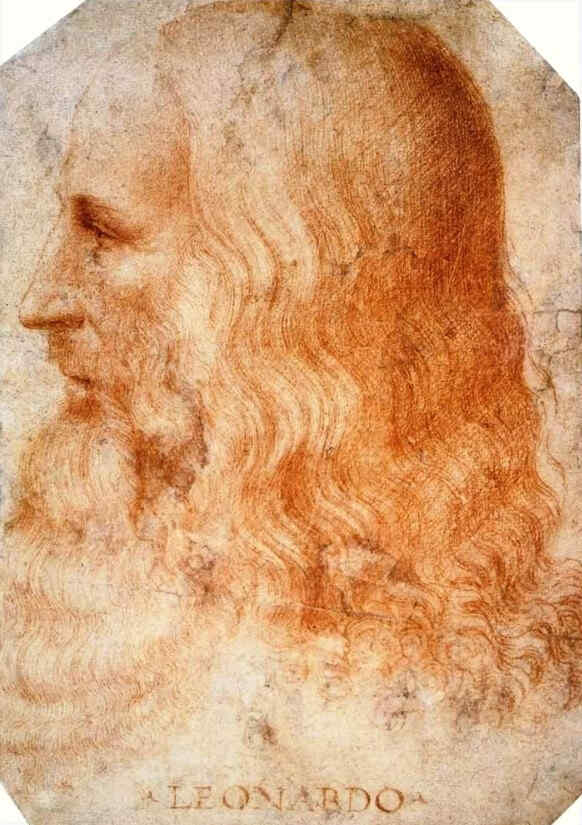
This, then, is one of Leonardo's portraits. There follows the other one, still better known.
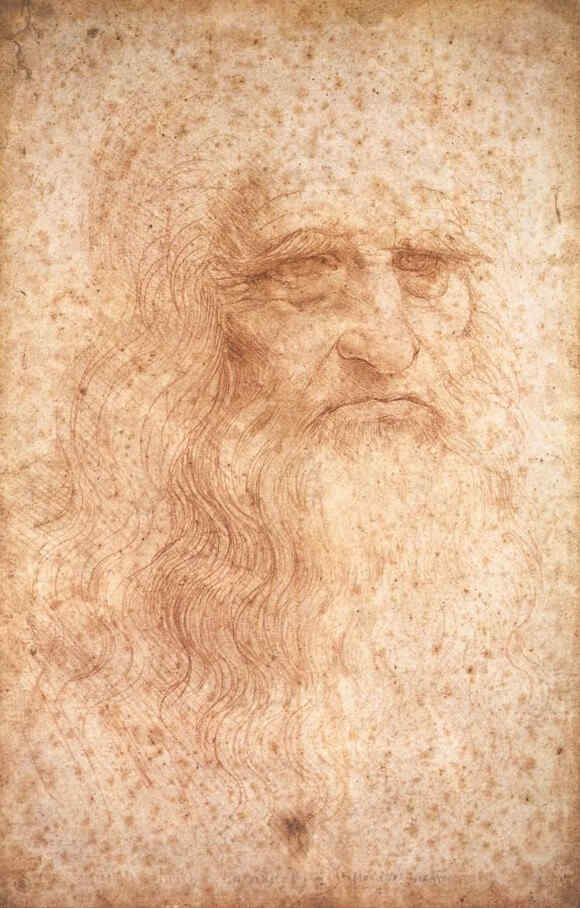
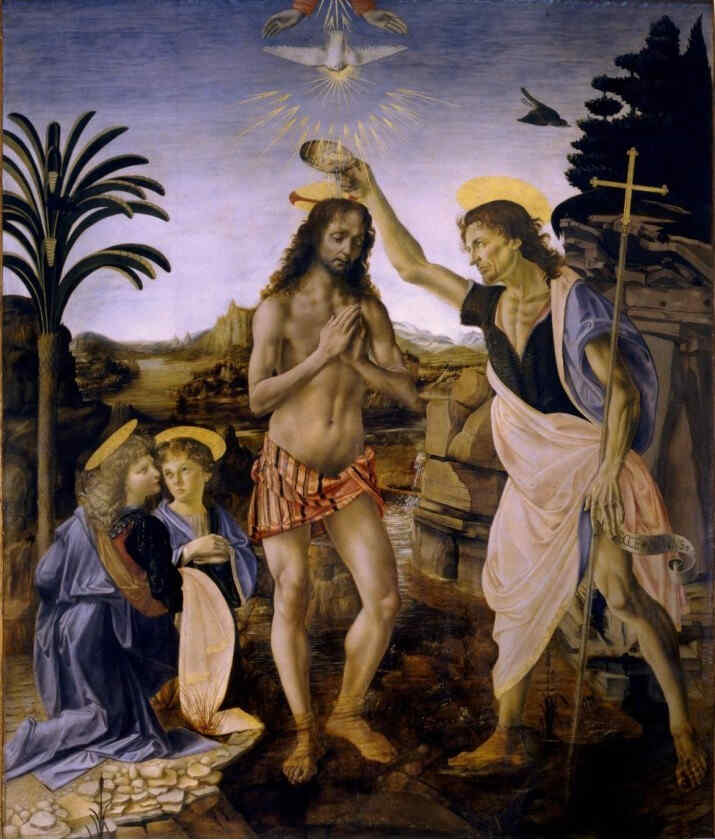
Here we have a picture from an early period of his development, showing how Leonardo grew out of the School of Verrocchio. Tradition has it that the finely elaborated landscape round this figure here was painted by Leonardo in the School of Verrocchio, and that Verrocchio, seeing what Leonardo could achieve, laid down his brush and would paint no more.
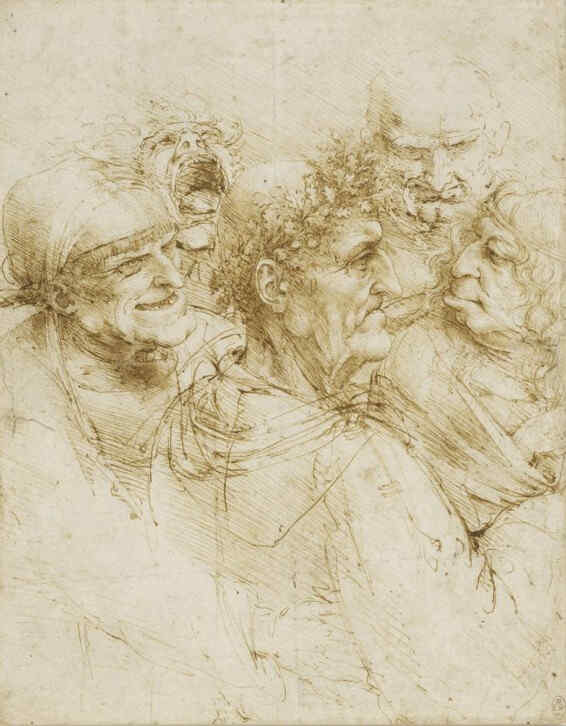
Here, again, you see how Leonardo drew—how he tried, even to the point of caricature, to extract the characteristic features by dint of studious contemplation, as I described just now.
We need not imagine that he stood alone in things like this; they had, indeed, been done by others in his time. Leonardo only stands out through his extraordinary genius, but it was altogether a quest of the time—this search for the strong characteristic features, as against what had come forth in earlier times from higher vision and had grown a mere tradition. It was characteristic of that time to seek for what appears directly to external vision, and thus bring out with emphasis whatever in the outward features of a being is most significant of individual character.
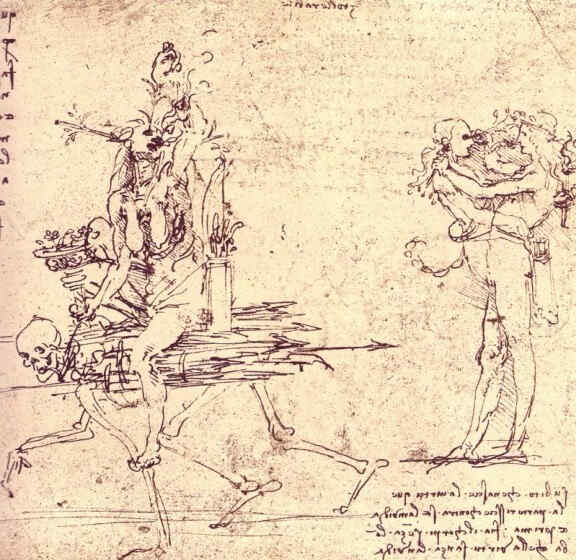
Far more important than the subject-matter, the point was to study and portray with precision the positions of the bones and so forth.
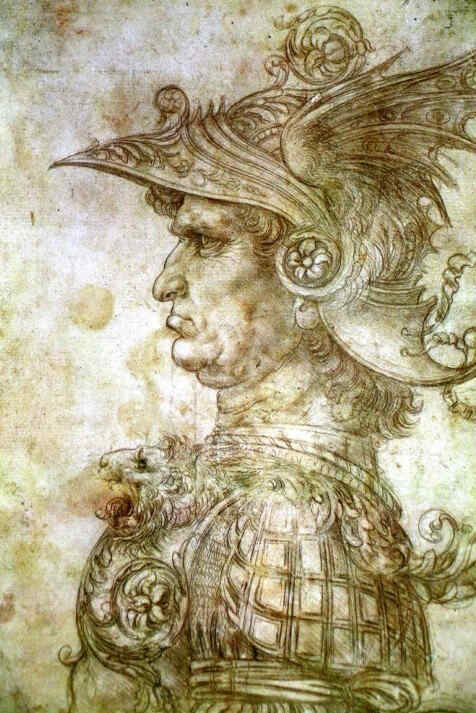
This is the portrayal of a thunderstorm.
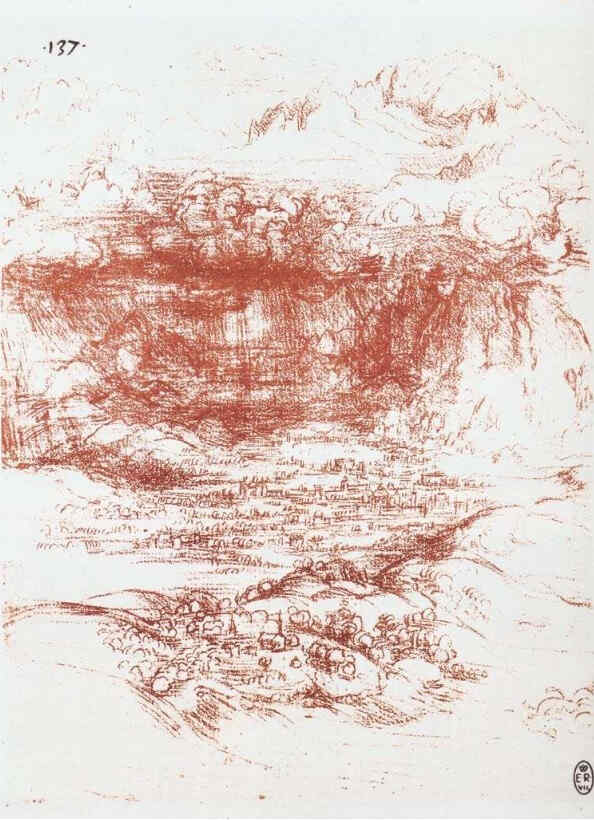
The two pictures we now show are not attributed to him with certainty, nor are some others which we shall see presently, but they bear the character of Leonardo and are therefore not without connection.
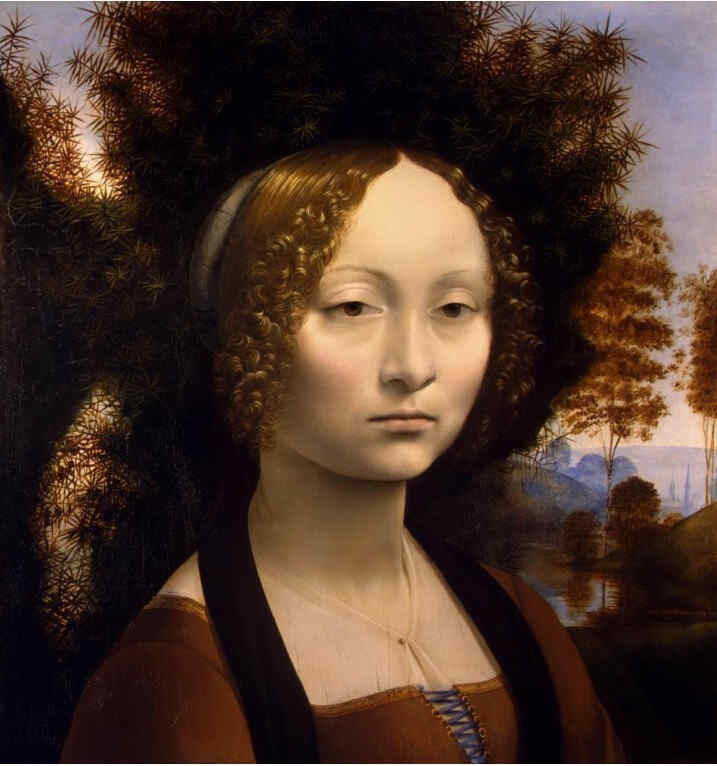
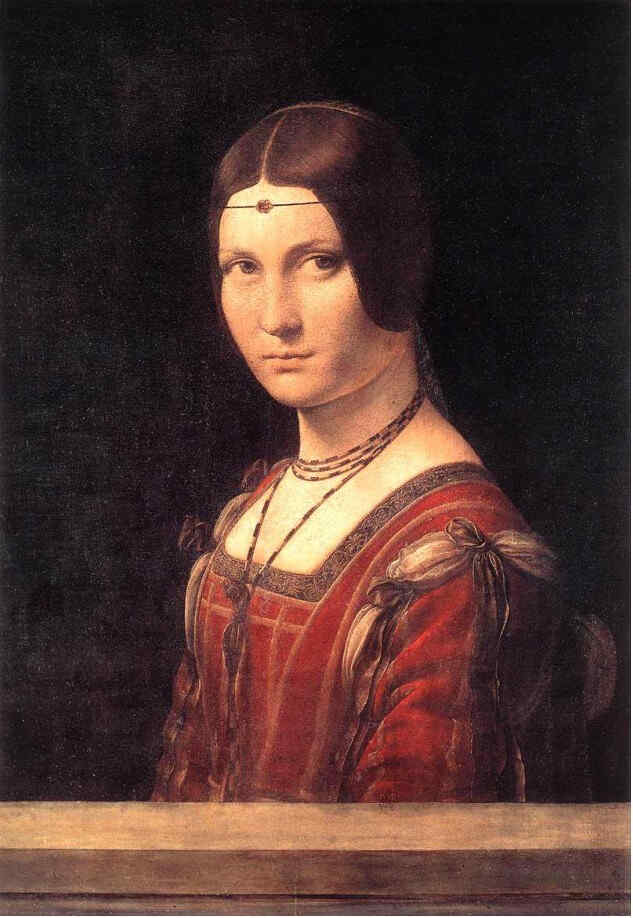
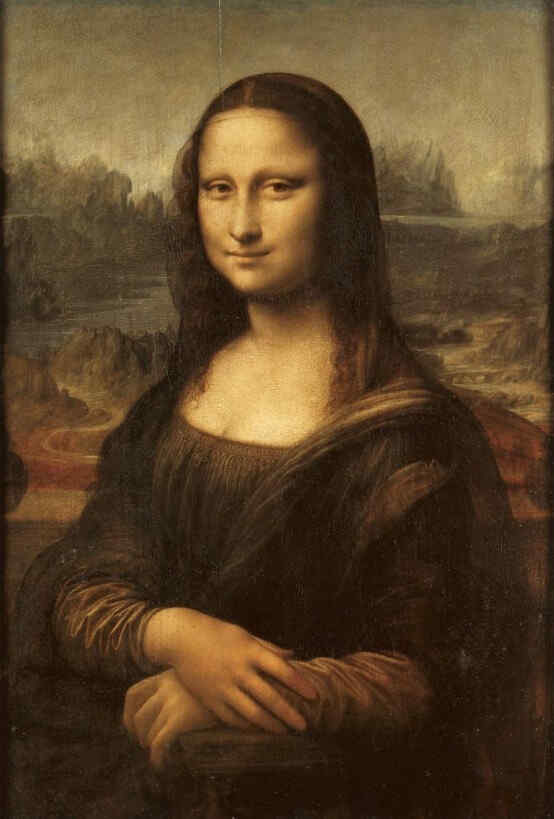
In this famous picture we see the other aspect of Leonardo, where we might say he seeks to attain the very opposite pole from what was illustrated in the former sketches. There he tried to discover and bring out with emphasis the individual and characteristic in all details. People will often not believe that an artist who can create such a work as the Mona Lisa has any need of going in the other direction to the point of caricature. I have, however, often drawn attention to this fact. Think of the inherently natural impulse whereby our friend the Poet, Christian Morgenstern, went from his sublime, serene creations to the humorous poems with which we are familiar, where he seeks the very extremes of caricature. There is this inner connection in the artist's soul. If he desires to create a work so inwardly complete, harmonious, serene as this, he often has to seek the faculties he needs for such creation by emphasising characteristic individual features even to the point of caricature.
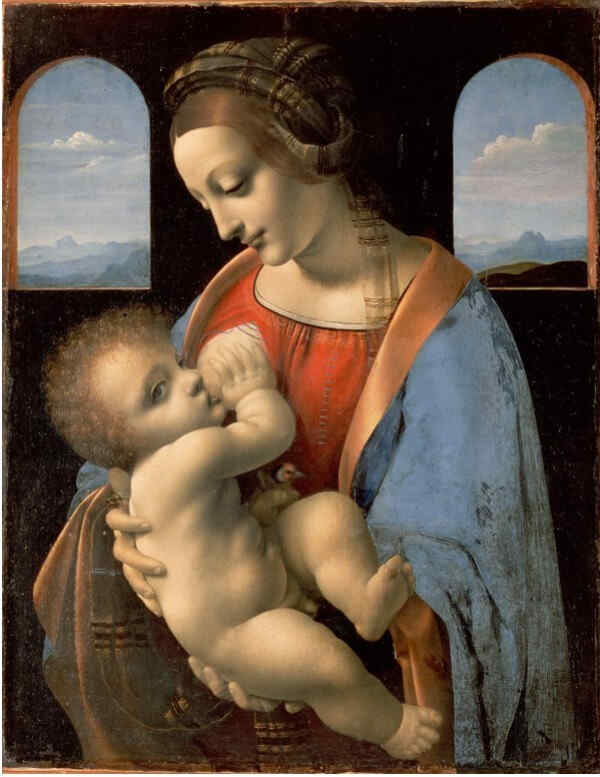
These pictures, which, as I said, are not in historic order, represent Leonardo in the quality of an artist seeking for inner clarity, completeness and perfection.
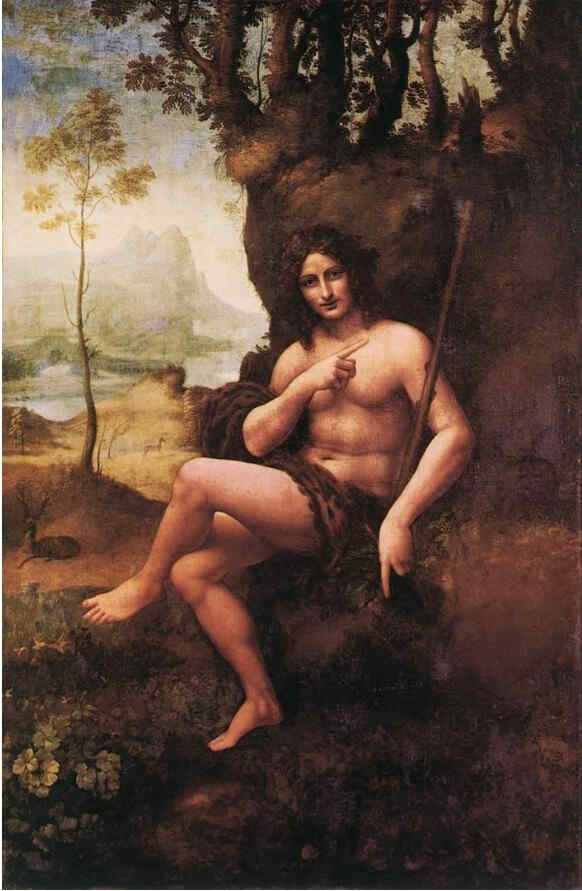
Here is the Dionysos figure, the God Dionysos. You will find indications on these matters in various other lectures. The painting is based on proven designs and sketches of Leonardo da Vinci. However, it is believed that it was carried out by an unknown student from the workshop of Leonardo and between 1683 and 1693 it was modified and painted to represent Bacchus.
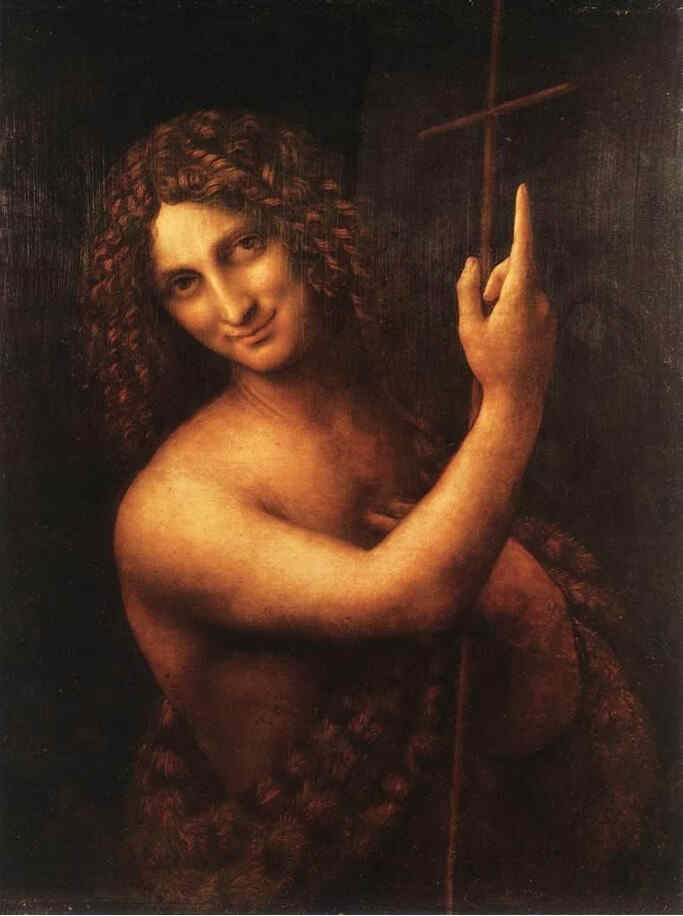
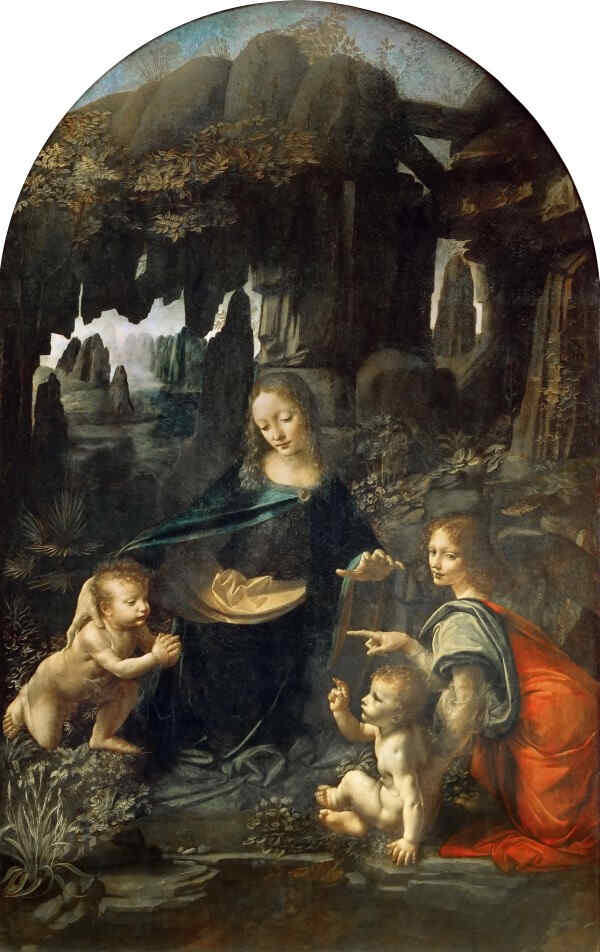
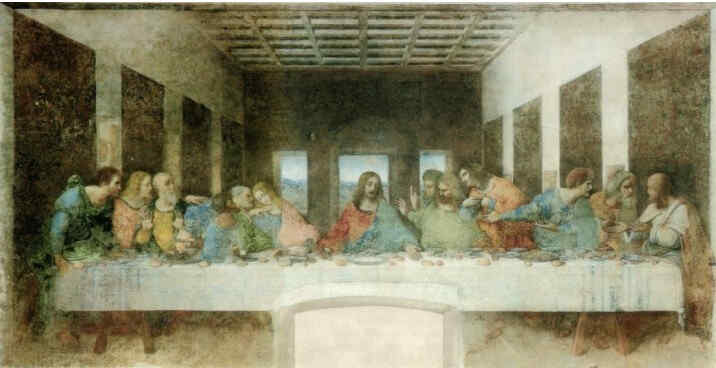
We now come to the Last Supper—which he created, it is true, at an earlier time, and worked upon during a long period. We have often spoken of it. We know what an essential progress in the artistic power of expression is visible in this picture as against the earlier pictures of the Last Supper by Ghirlandajo and others. Observe the life in this picture; see how strongly the individual characters come out in spite of the powerful unity of composition. This is the new thing in Leonardo. The adaptation of the strong individual characters to the composition as a whole is truly wonderful. At the same time each of the four groups of disciples becomes a triad complete and self-contained; and, again, each of these triads is marvellously placed into the whole. The colour and lighting are inexpressibly beautiful. I spoke once before of the part of the colouring in this composition. Here we look deep into the mysterious creative powers of Leonardo. If we try to feel the colours of the picture as a whole, we feel they are distributed in such a way as to supplement one another,—not actually as complementary colours, but in a similar way,—so much so that when we look at the whole picture at once, we have pure light—the colours together are pure light. Such is the colouring in this picture.
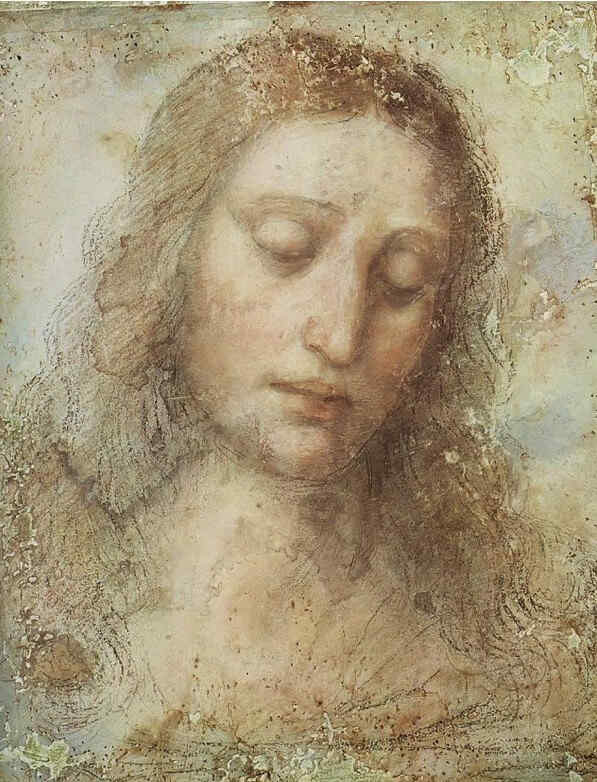
We now come to the details of the picture. This is generally considered to be an earlier attempt at the Head of Christ. These reproductions are familiar.
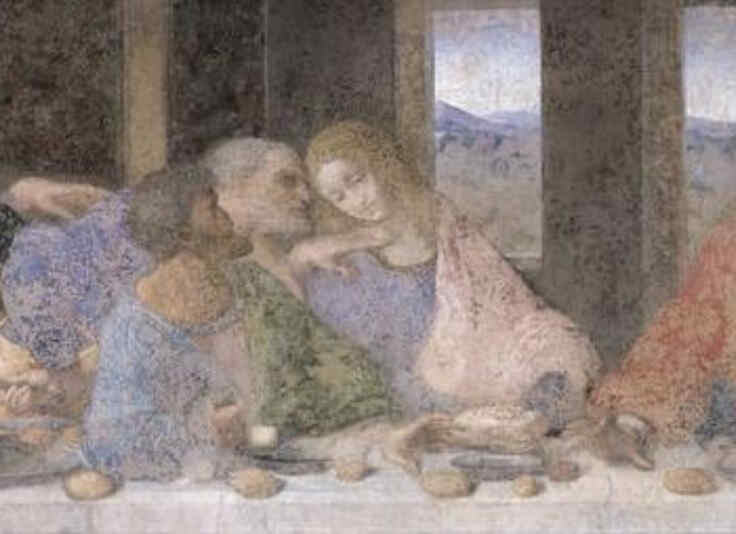
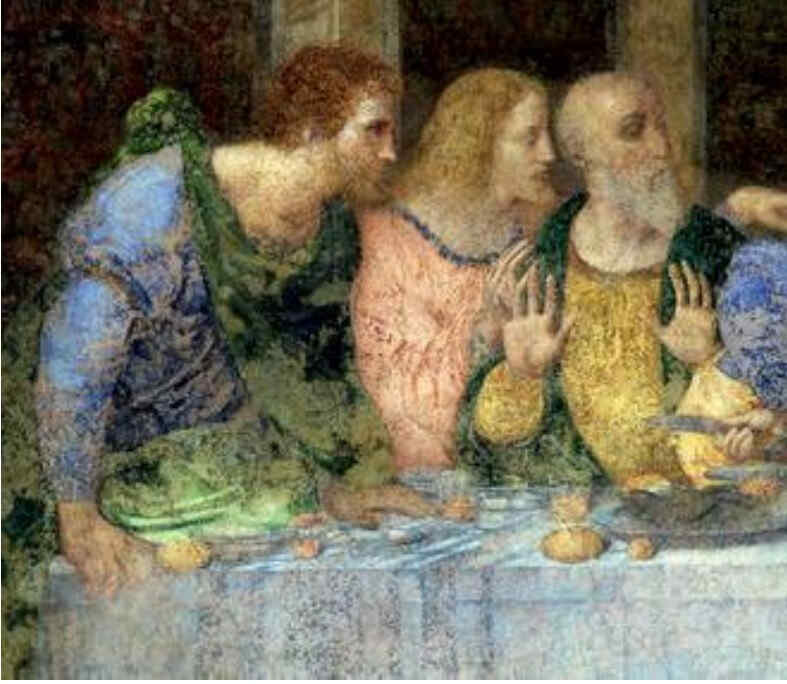
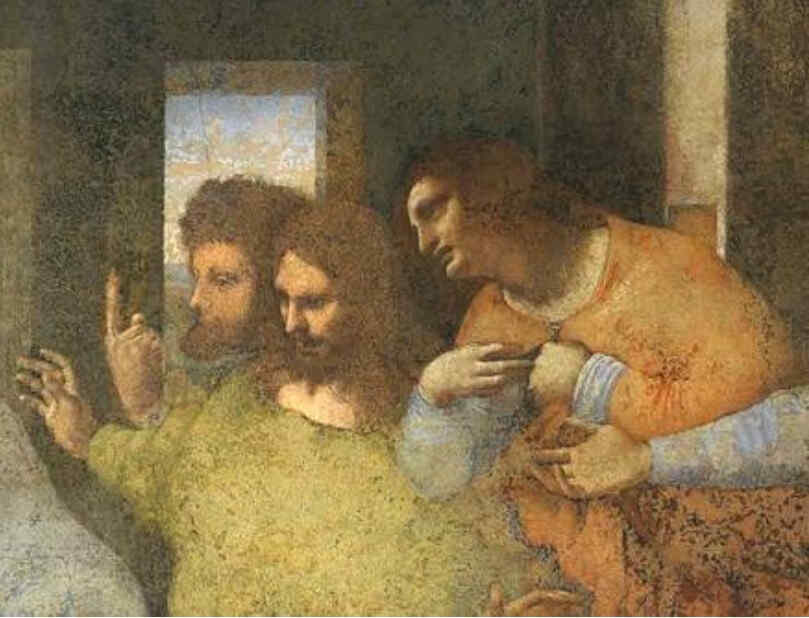
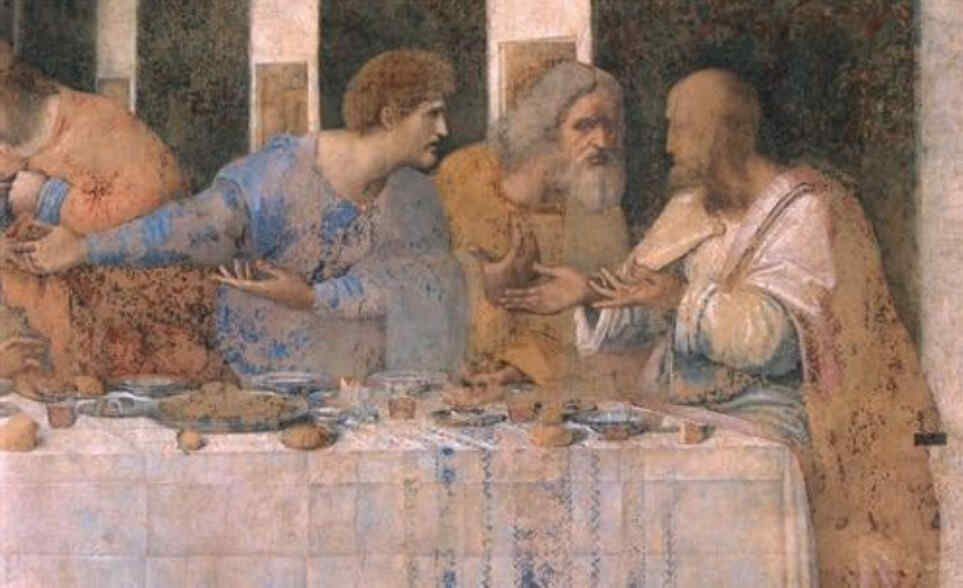
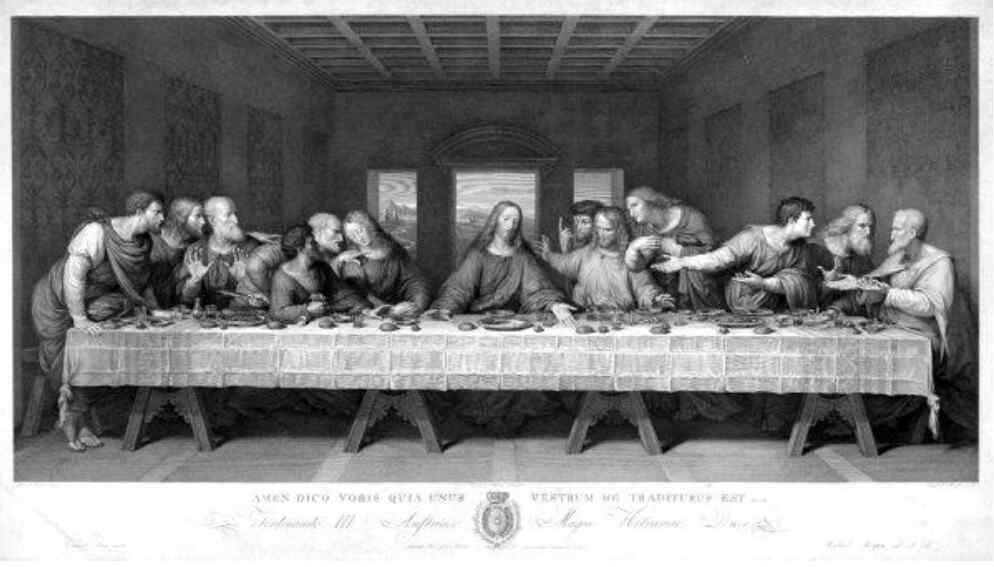
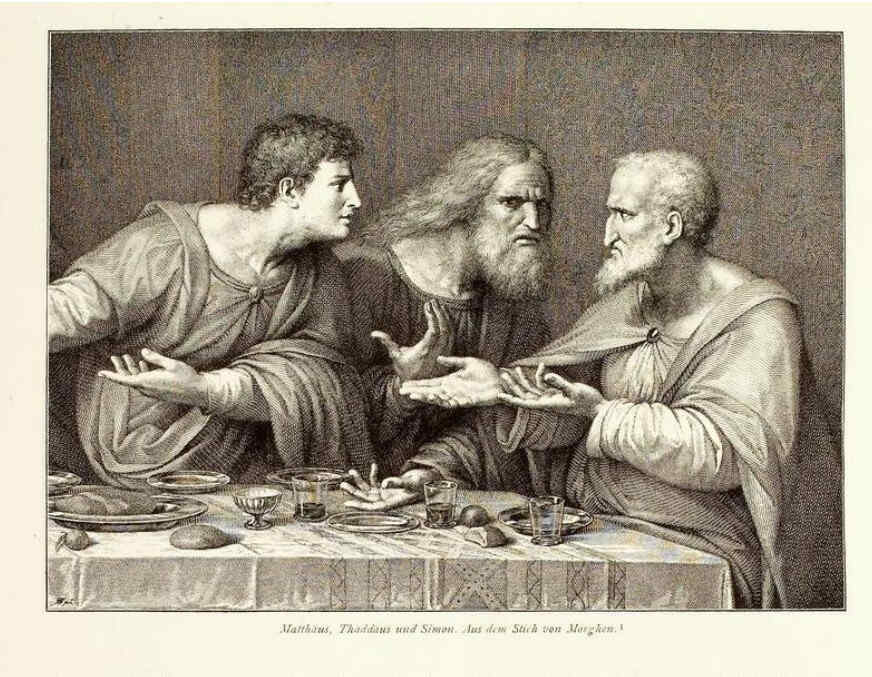
This is Morghan's engraving, from which we gain a more accurate conception of the composition than from the present picture at Milan, which is so largely ruined. You are, of course, familiar with the fate of this picture, of which we have so often spoken.
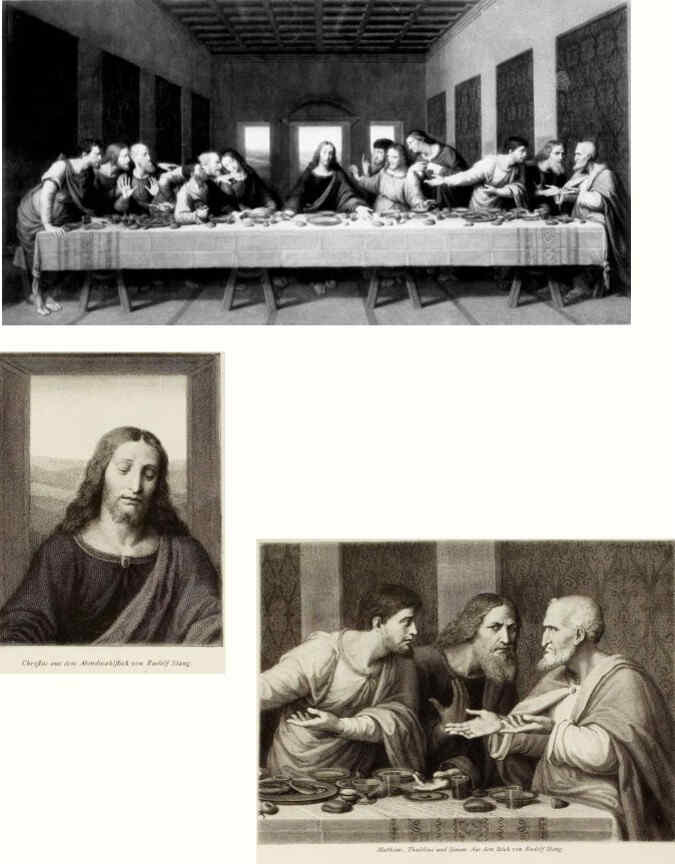
This is a very recent engraving,—a reproduction which reveals the most minute study. It is frequently admired and yet, perhaps, for one who loves the original as a work of art, it leads too far afield into a sphere of minute and detailed drawing. Still we may recognise in this an independent artistic achievement of considerable beauty.
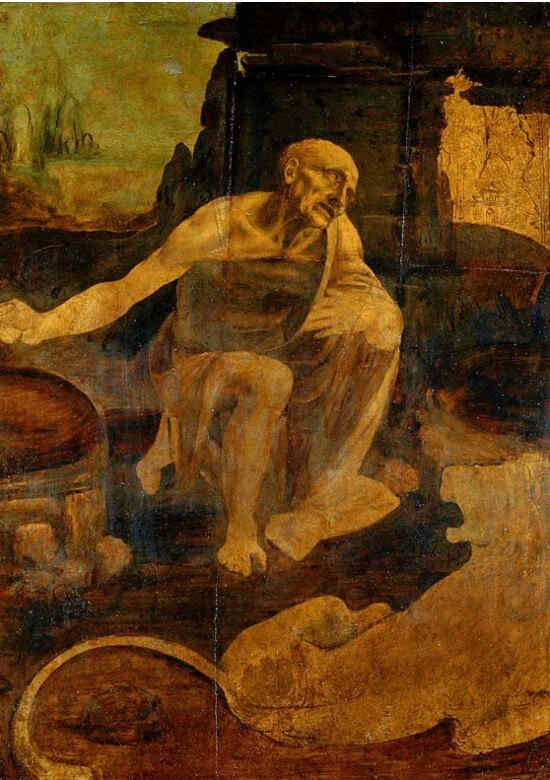
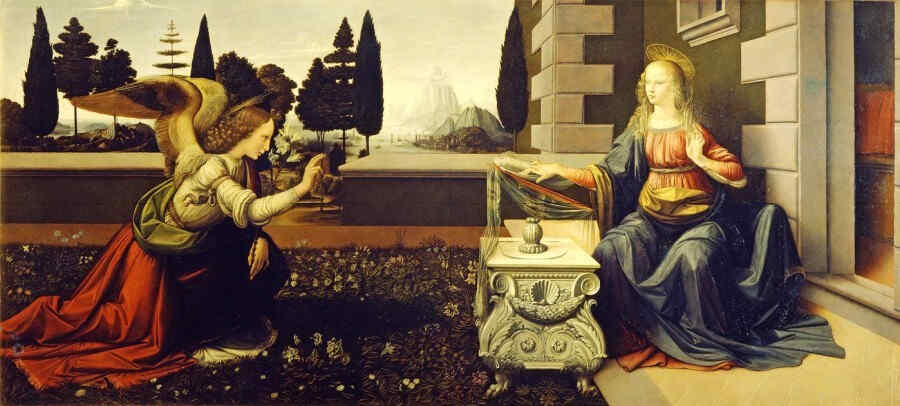
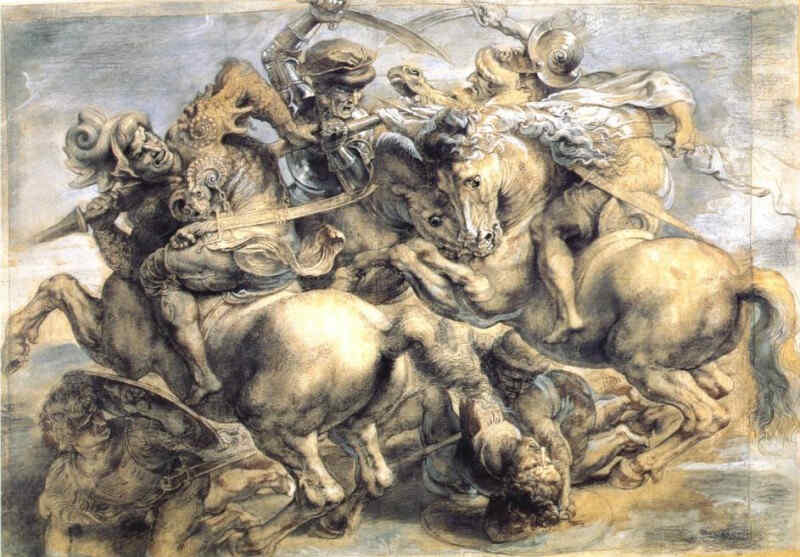
Here we have a fragment of the battle picture projected by Leonardo, which I mentioned a short while ago.
We will now go on to Michelangelo. Considering Leonardo once again, you will see there is something in him which comes out especially when, instead of taking the chronological order, which is in any case a little uncertain, we take his work in groups, as we have done just now. Then we see clearly what different streams are living in him. The one, which comes out especially in his Last Supper, aims at a peculiar quality of composition combined with an intense delineation of character. It stands apart and alongside of that other tendency in which he does not seek this kind of composition. This other _stream we find expressed in the pictures in the Louvre, and at St, Petersburg and London, which we showed before the Last Supper. It might have come forth at any time; one feels it is almost by chance that the pictures of this kind do not exist from every period in his life. That which comes to expression in these pictures is in no way reminiscent of the peculiar composition in the Last Supper, but aims at a serene composition while seeking to express individual character to a moderate extent.
We now come to Michelangelo. To begin with, his portrait of himself.
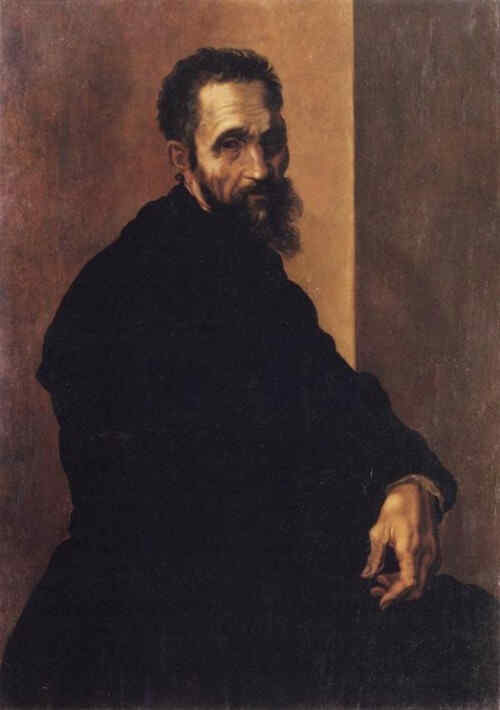
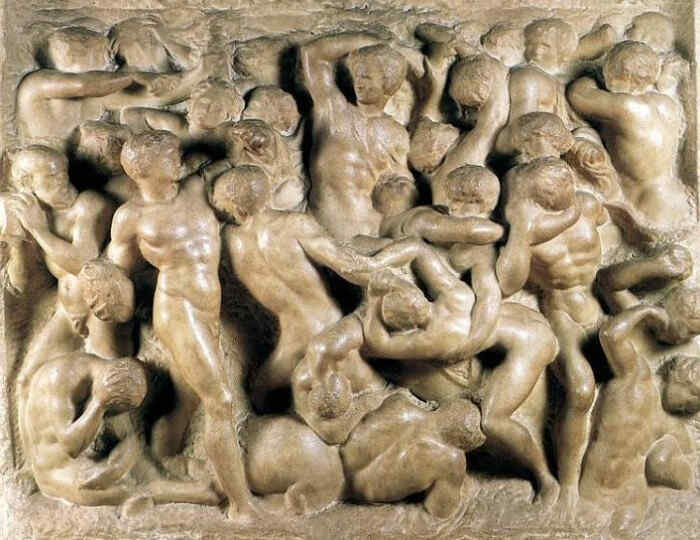
Here we have Michelangelo before he reached his independence, working in Florence, perhaps under the influence of Signorelli and others, still, in fact, a pupil.
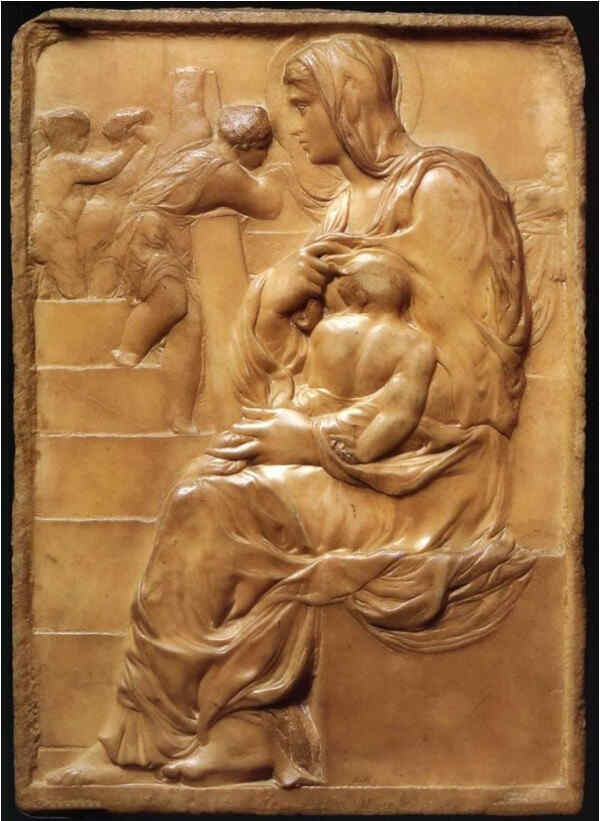
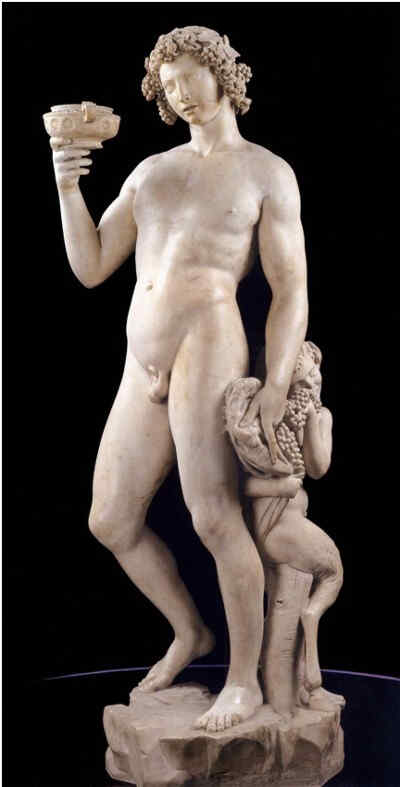
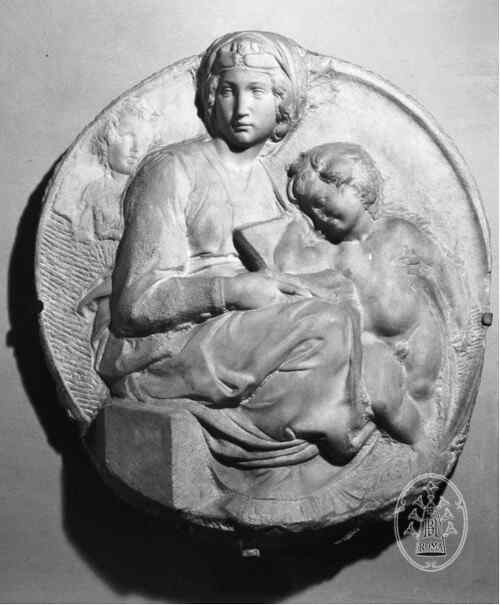
And now we think of Michelangelo moving to Rome for the first time, under all the influences which I described just now.
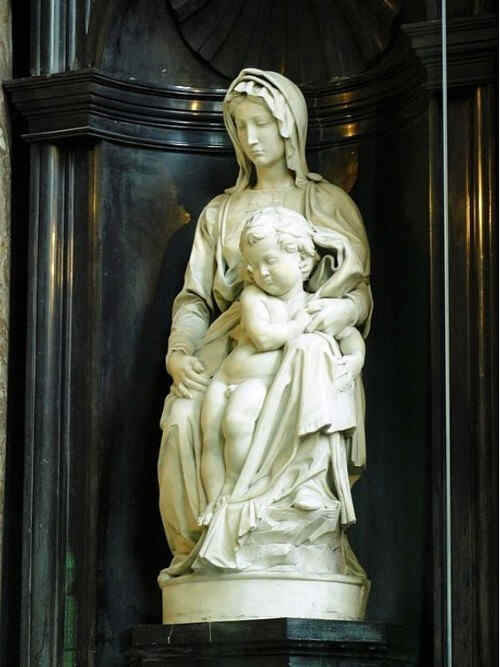
Look at this picture and then at the following one; compare the feeling in the two.
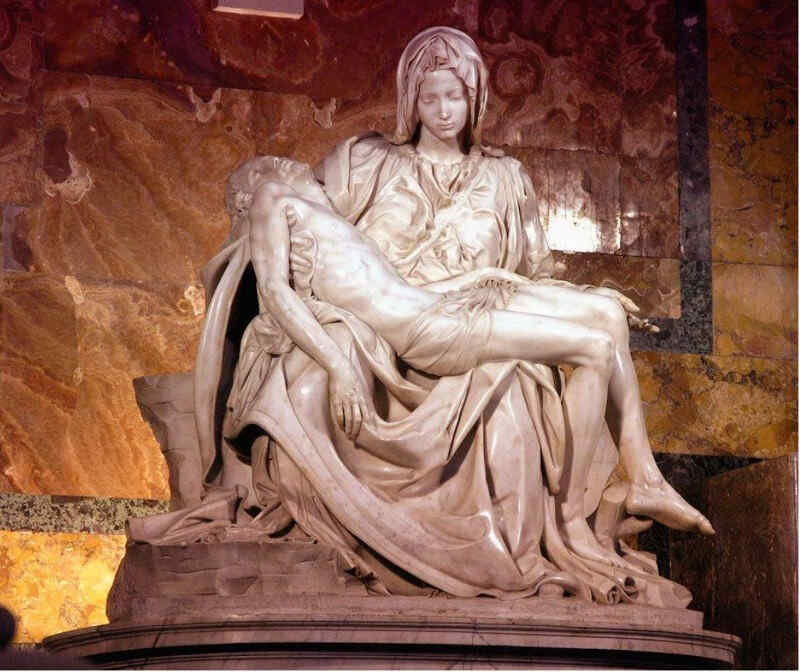
Look at this work. Undoubtedly it is created under the feeling of his coming to Rome. A more or less tragic element, a certain sublime pessimism pervades it. Let us return once more to the former one, and you will see the two creations are very similar in their artistic character. They express the same shade of feeling in Michelangelo. We now return once more to the Pieta.
People who feel the story more than the artistic quality as such have often said that the Madonna, for the situation in which she is here portrayed, is far too young. This arose out of a belief which was still absolutely natural in that time and lived in the soul of Michelangelo himself:—the belief that owing to her virgin nature the Madonna never assumed the features of old age.
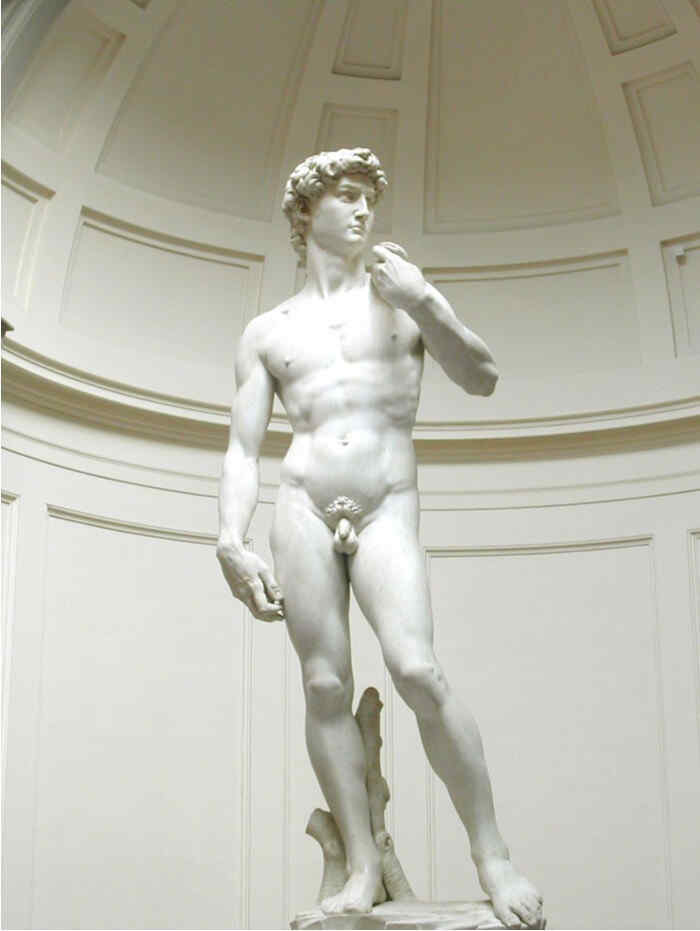
Here you have the work of which we spoke before. The figure strikes us most of all by its colossal quality, not in the external sense, but a quality mysteriously hidden in its whole artistic treatment.
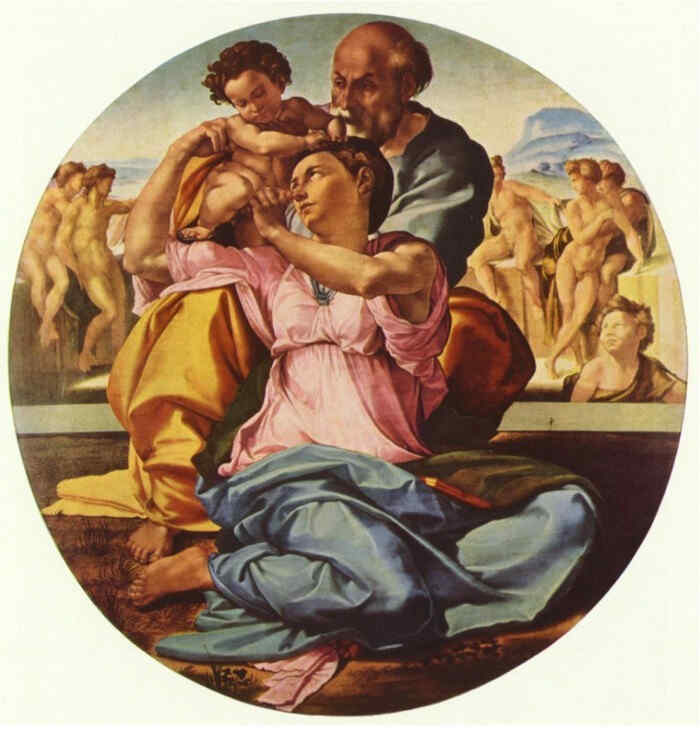
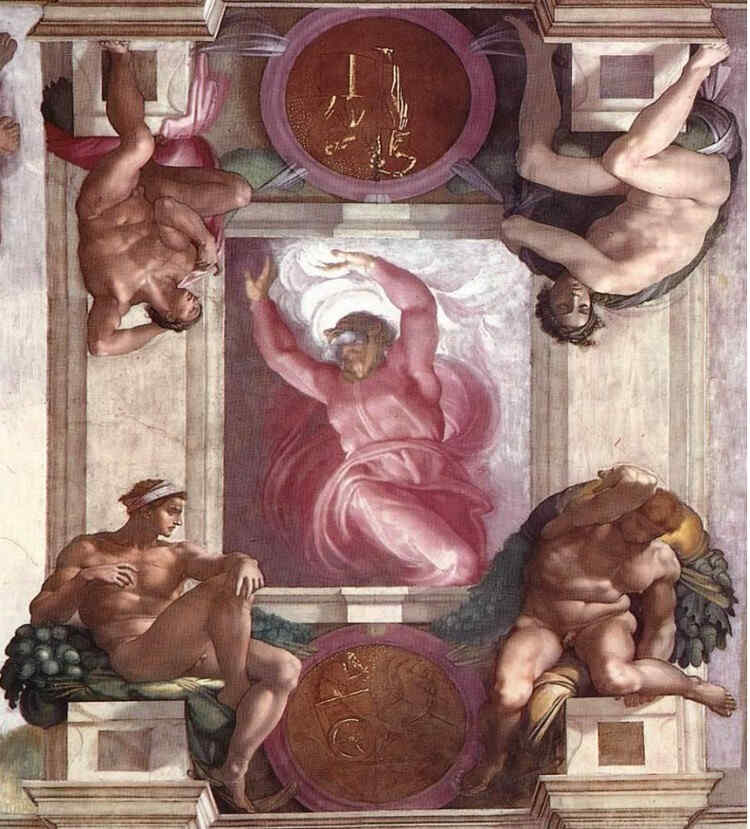
We now come to the Sistine Chapel. To begin with, we have the Creation of the World,—the first stage, which we might describe as the creation of Light out of the darkness of night.
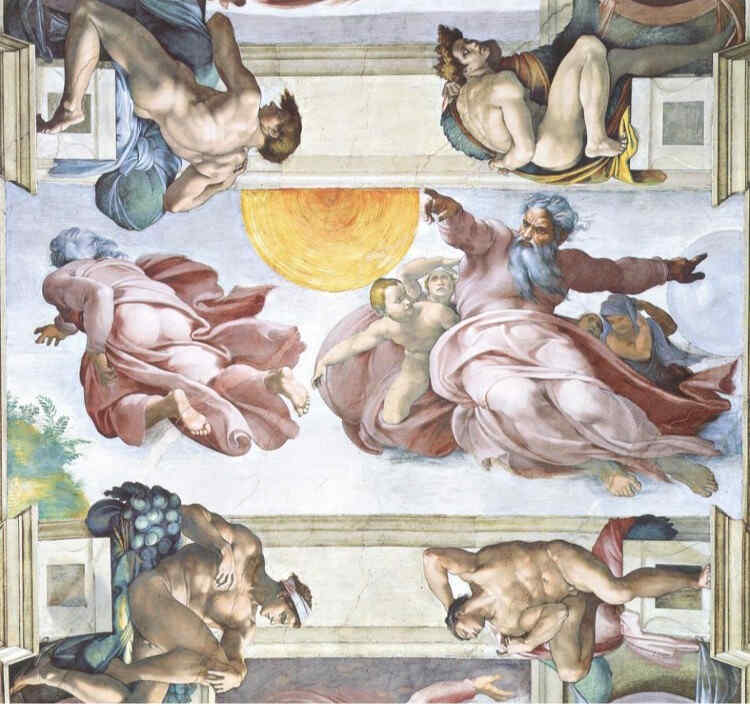
This picture bears witness to a tradition still living at that time as regards the creation of the World. It was that Jehovah created, in a sense, as the successor of an earlier Creator, whom He overcame, or transcended, and who now departed. The harmony of the net World-creation with the old which it transcended is clearly shown in this picture. Truly, we may say, such ideas as are expressed in this picture have vanished absolutely; they are no longer present.
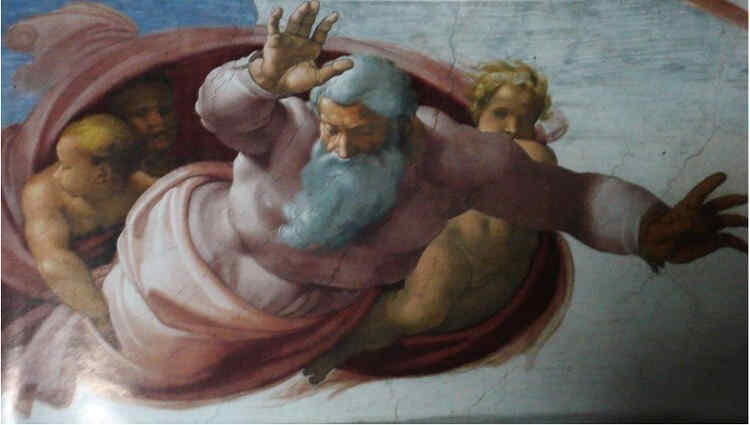
This, then, is the creation of that which went before mankind.
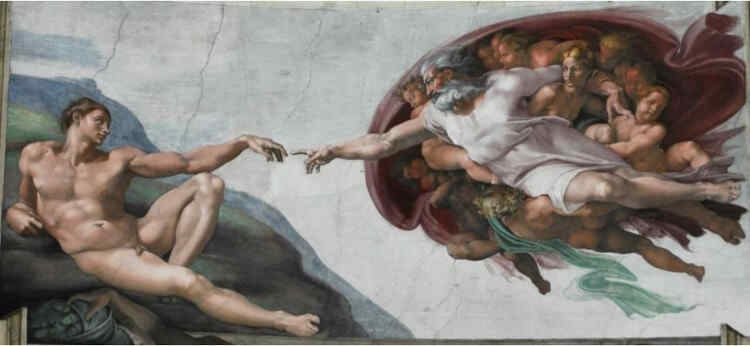
Here we find the creation of man. There follows the creation of Eve.
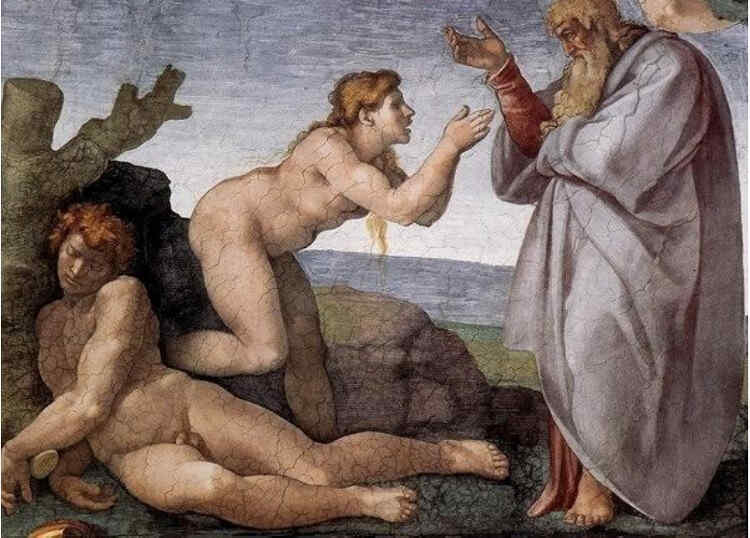
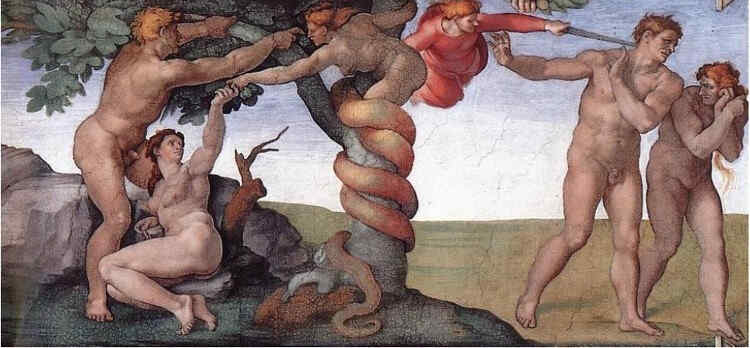
We now move more and more away from the theme of World-creation into the theme of History—the further evolution of the human race. This is the fall into sin.
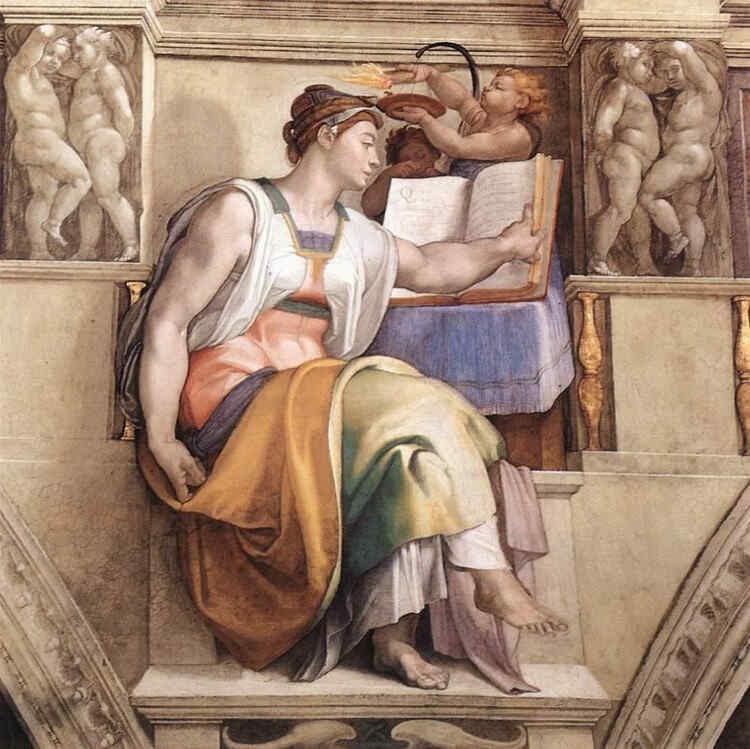
We come to the Sibyls, of whom I have spoken in a former lecture. They represent the one supersensible element in the evolution of man, which is contrasted with the other, the prophetic quality. We shall see the latter presently in the series of the Prophets. Here we have the Sibylline element. In my cycle of lectures given at Leipzig, on “Christ and the Spiritual World,” you will find the fuller description of its relation to the prophetic. That Michelangelo included these things at all, in his series of pictures, proves how closely he connected the earthly life with the supersensible—the spiritual. See now the succession of the Sibyls; observe how a real individual life is poured out into each one: in every detail, each one brings to expression a quite specific visionary character of her own.
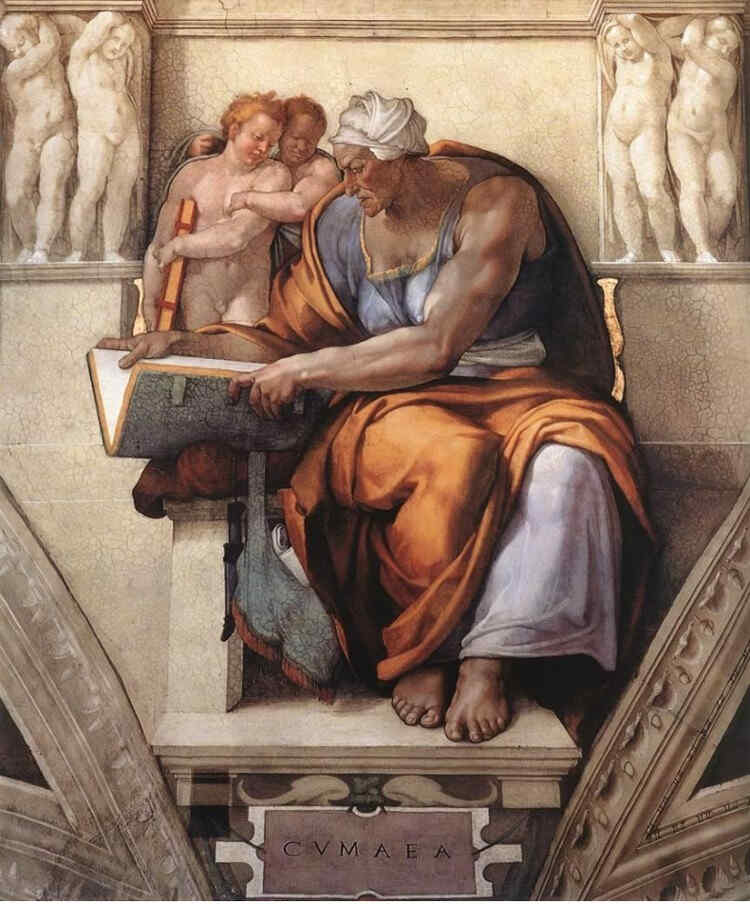
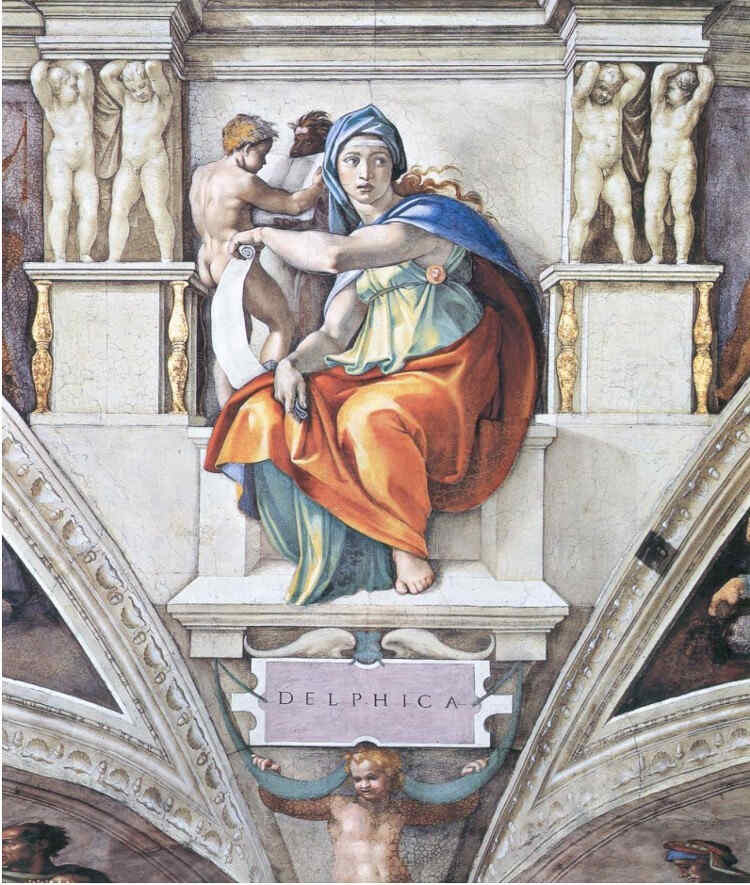
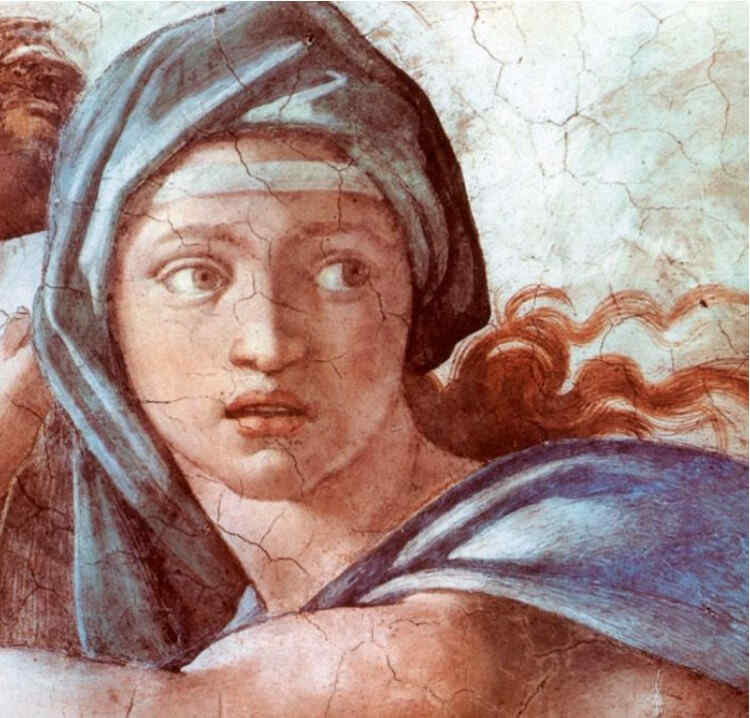
Observe the position of the hand. It is no mere chance. Observe the look in her eyes, coming forth out of an elemental life; you will divine many things which we cannot express in words, for that would make the thing too abstract,—but they lie hidden in the artistic treatment.
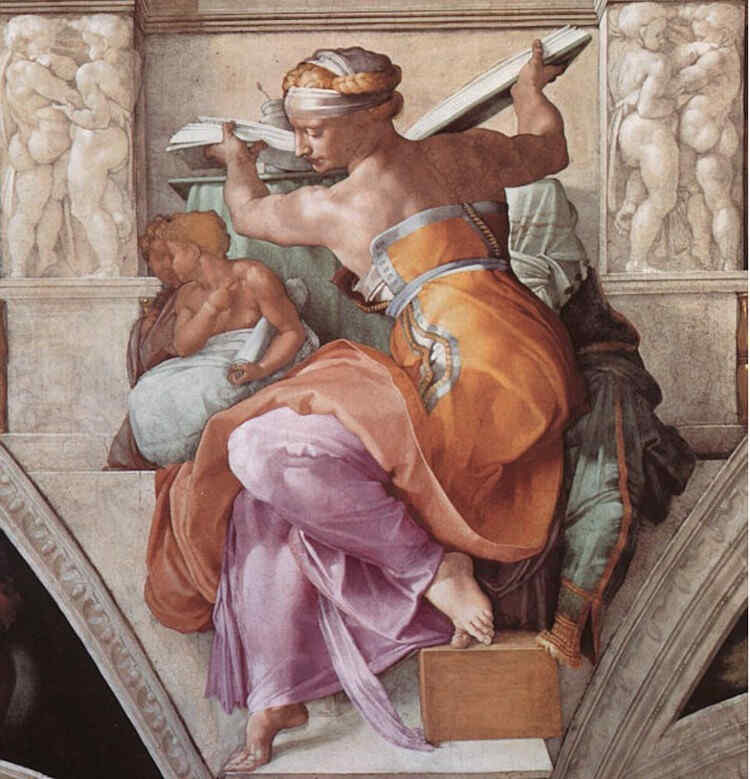
And now we come to the Prophets.
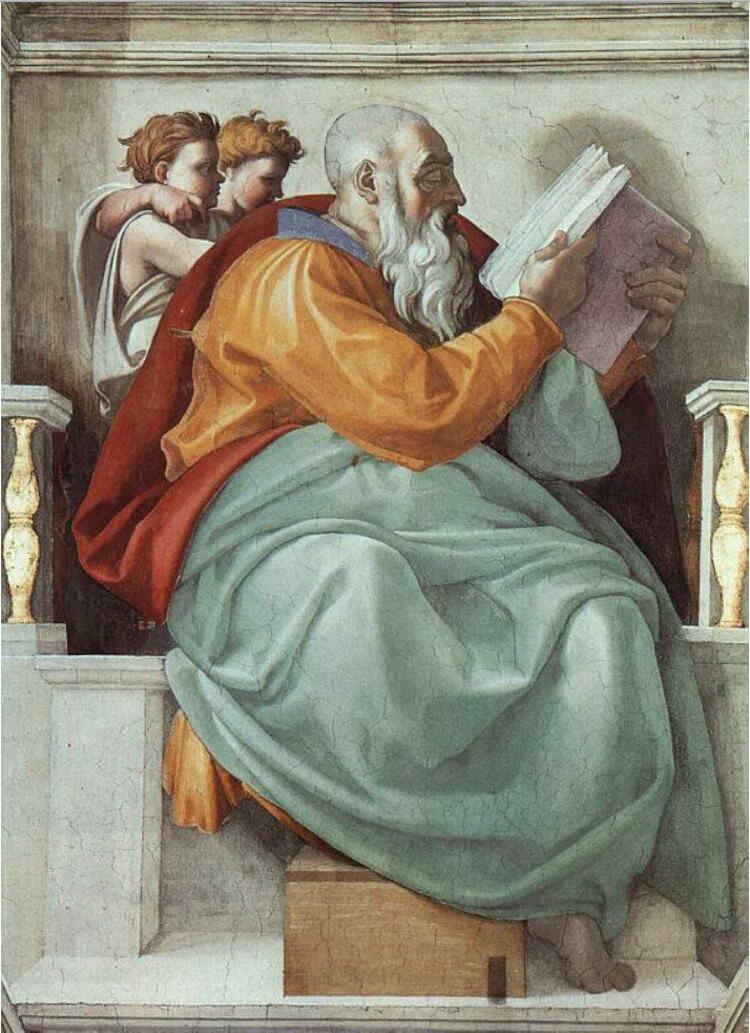
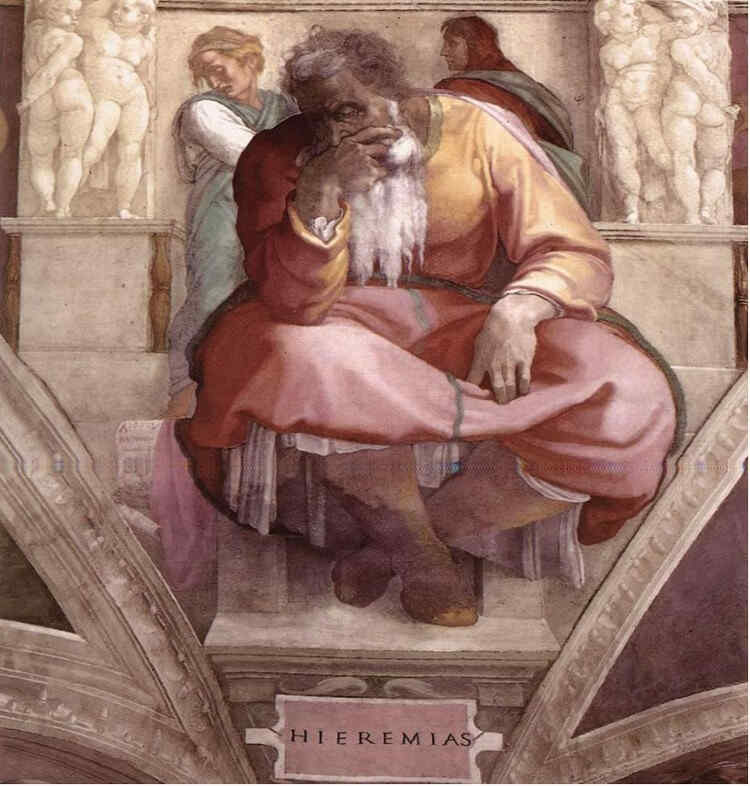
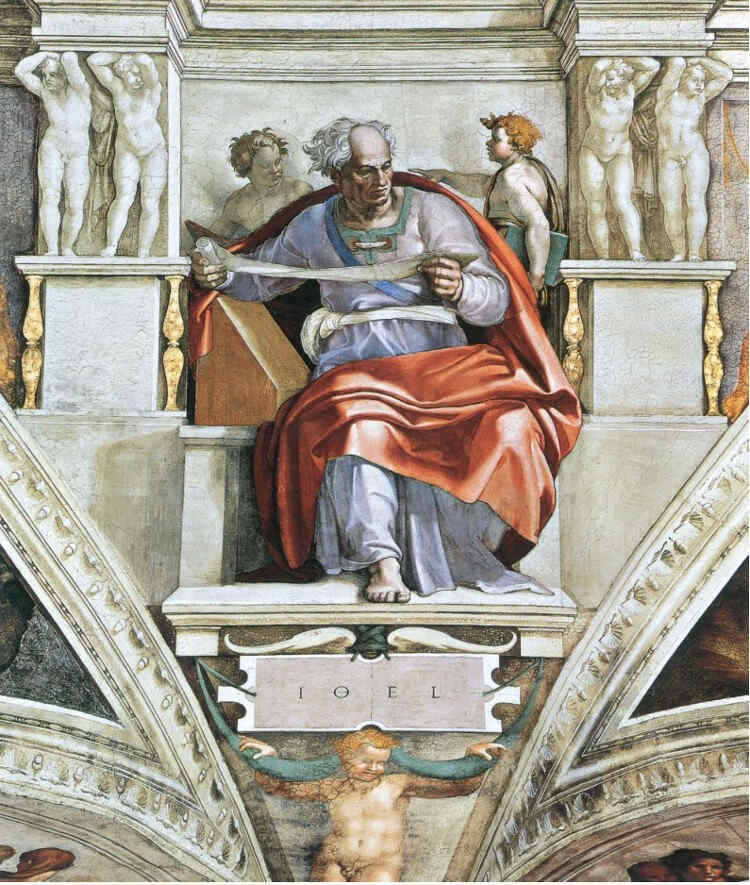
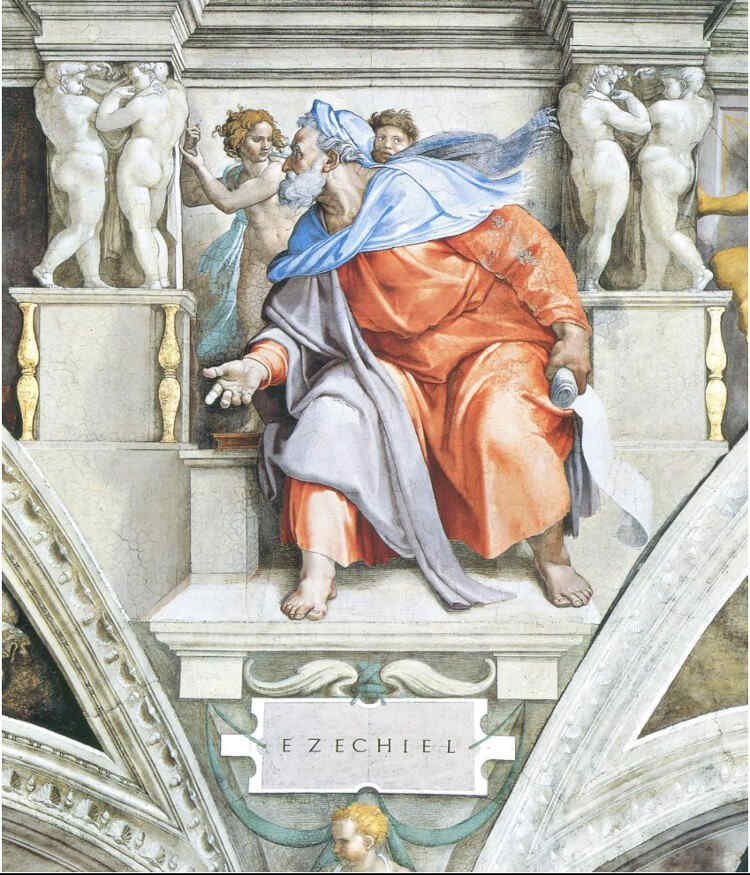
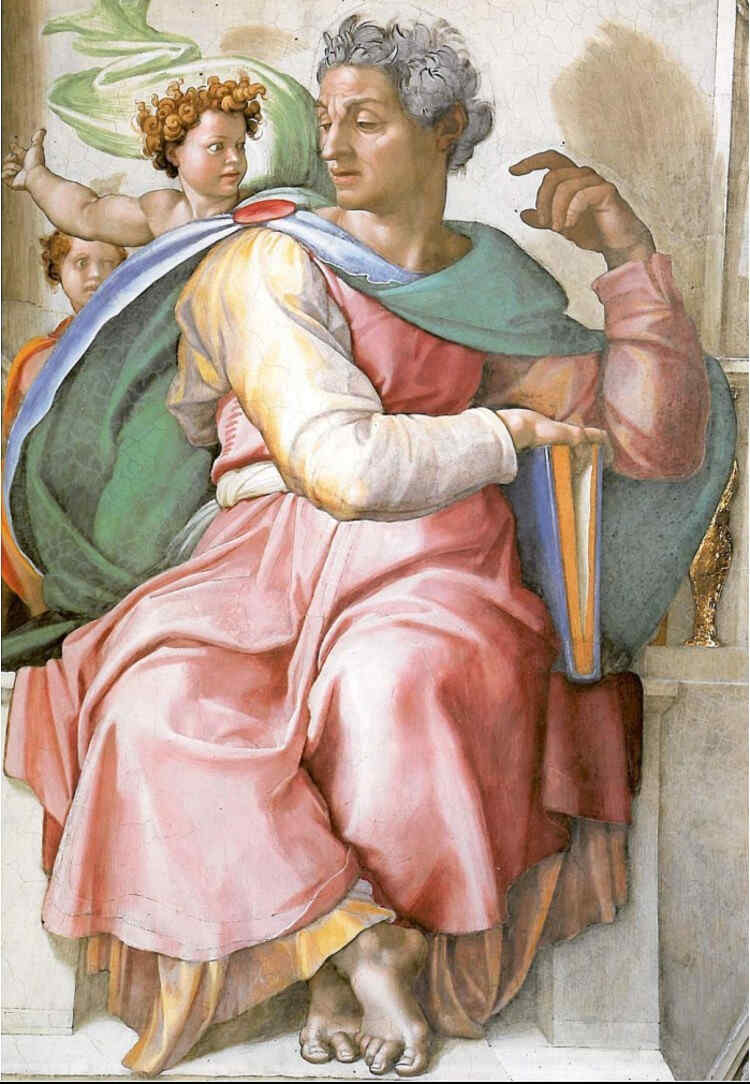
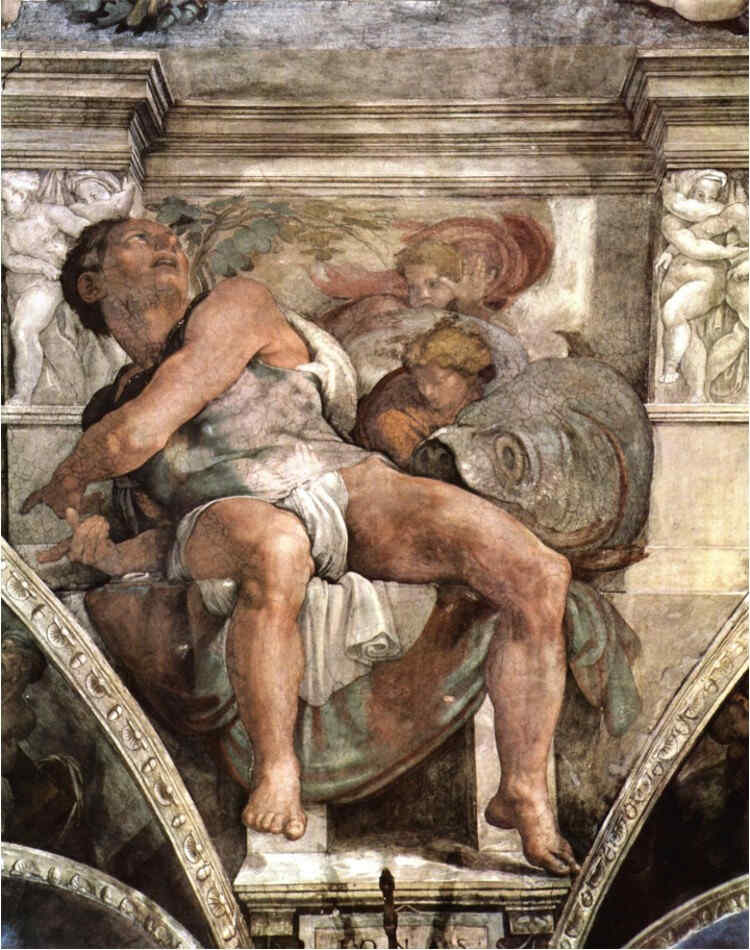
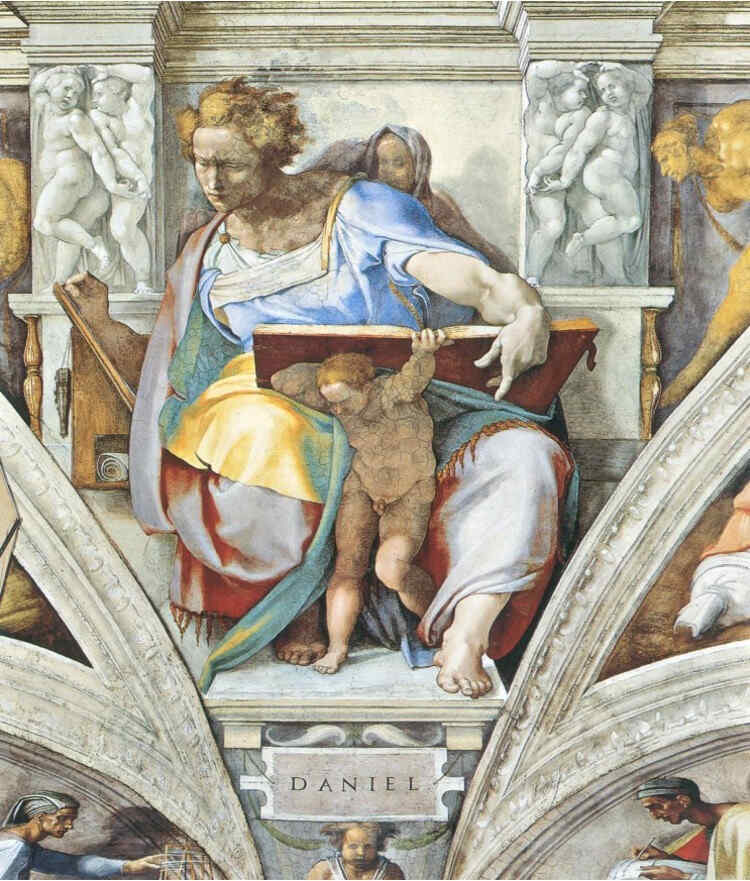
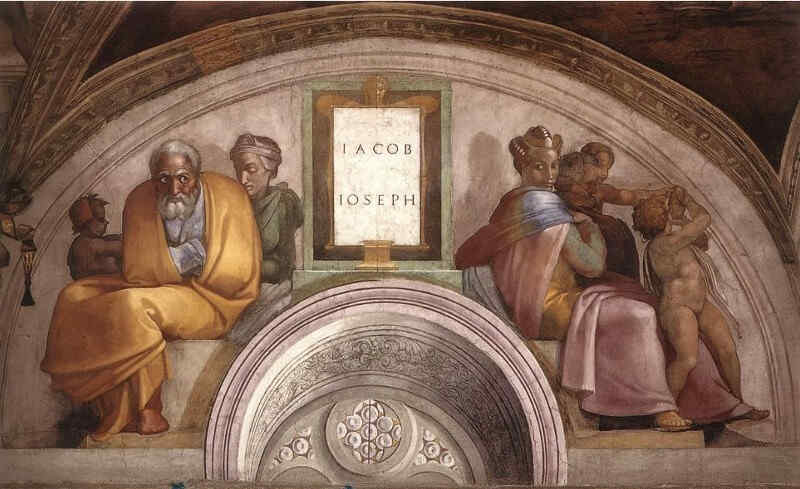
These are examples of his scenes from the Old Testament.
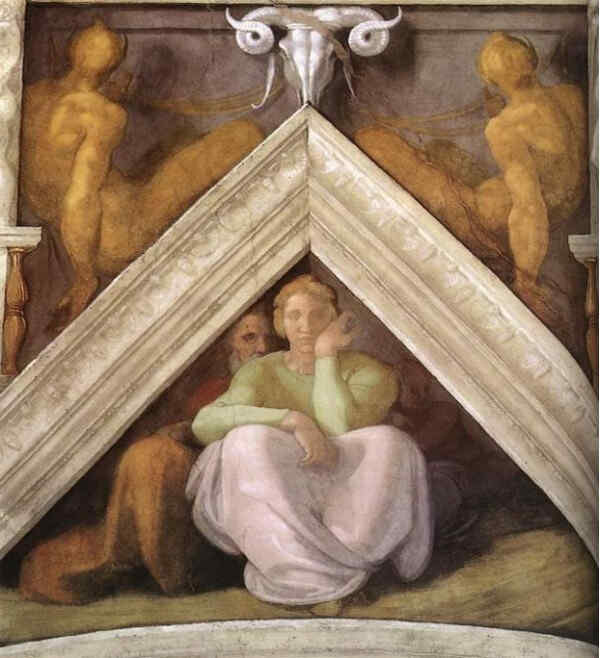
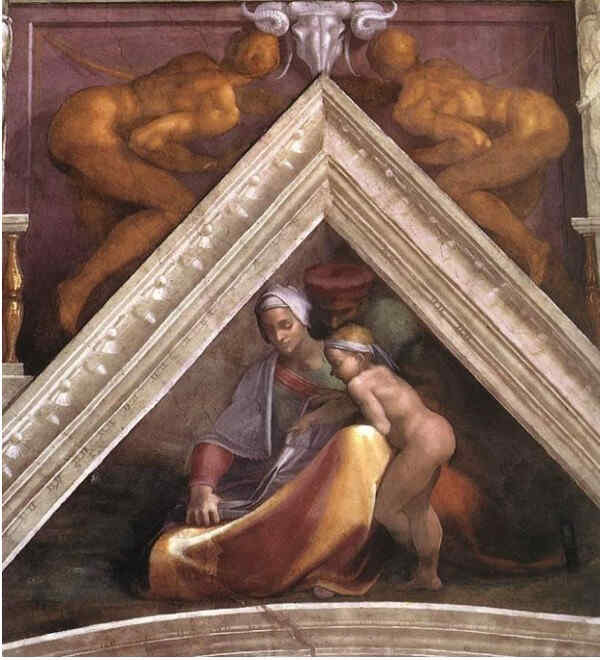
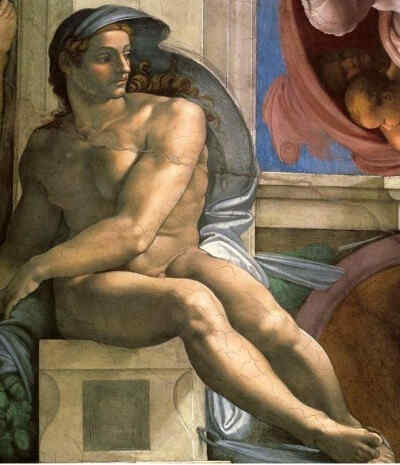
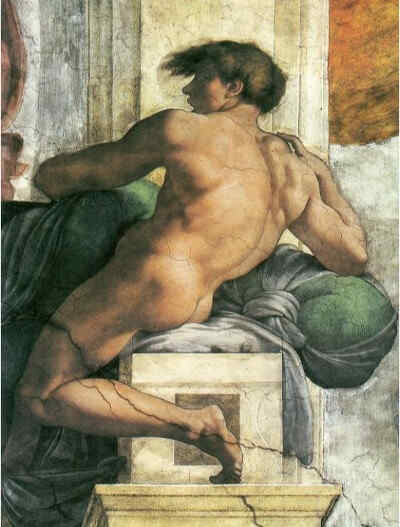
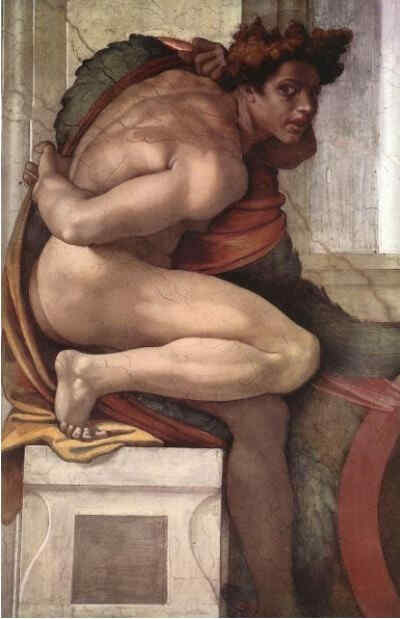
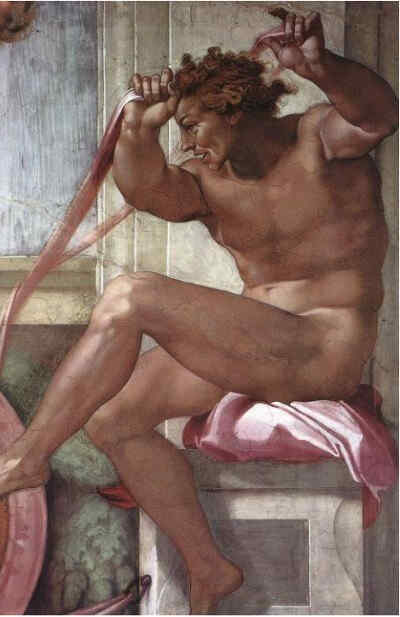
Here we come to his later period in Florence: to the Medicis and the Chapel at which he had to work for the Medicis under conditions that I described before. I have spoken of these tombs of Juliano and Lorenzo in a lecture which I believe has also been printed.
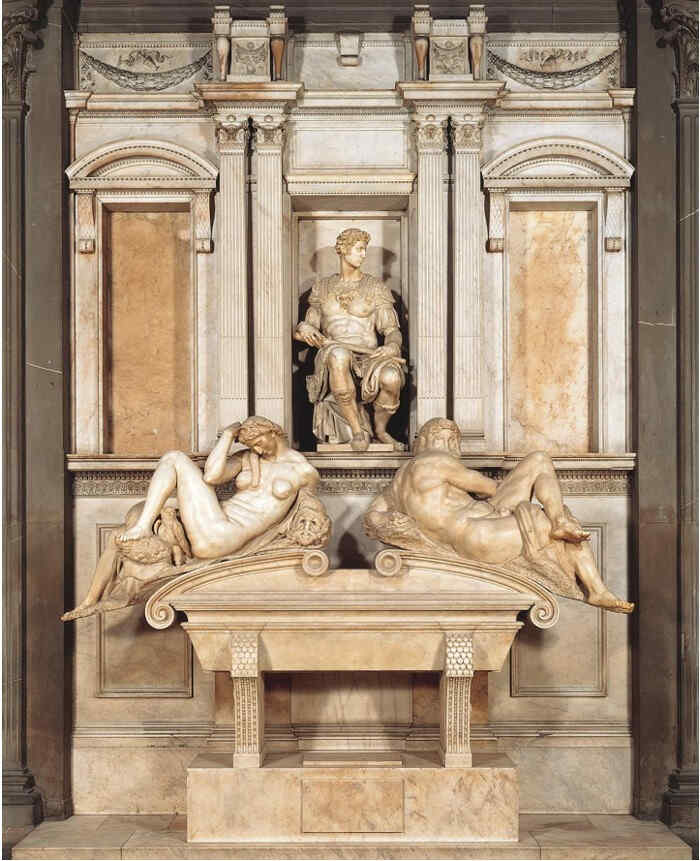
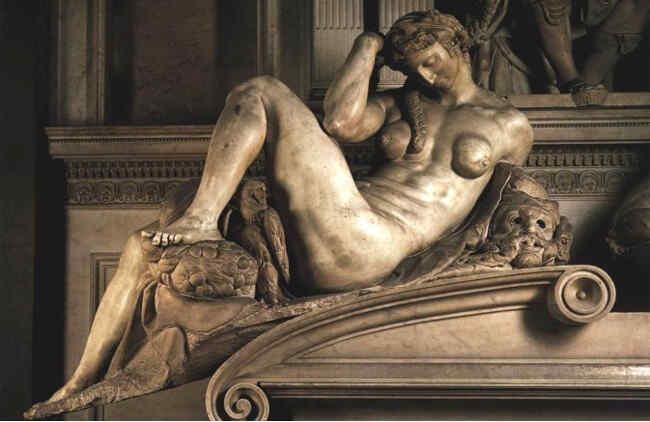
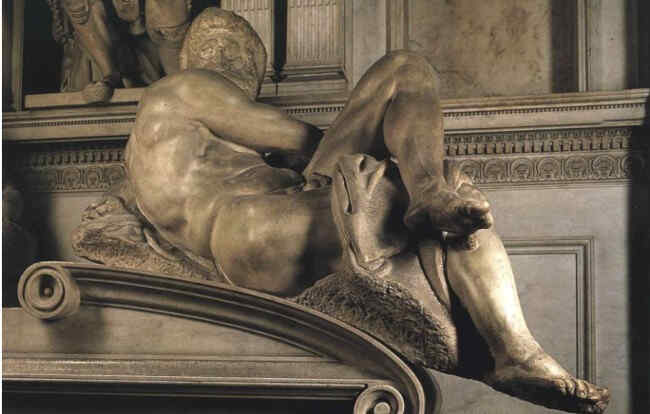
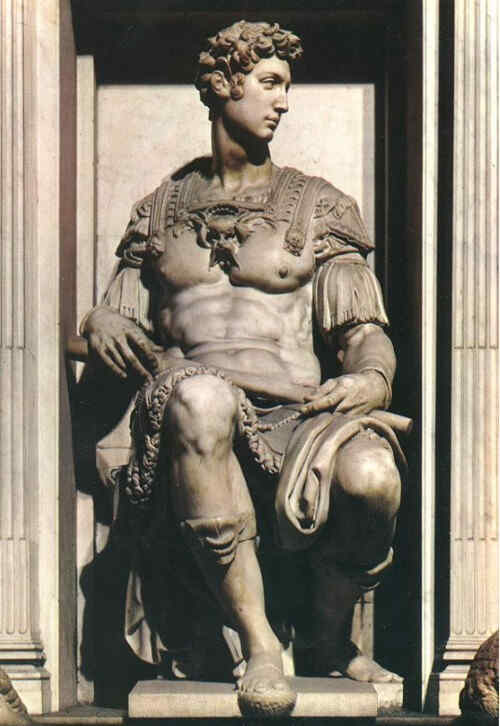
This is the second tomb, with the figures of Morning and Evening.
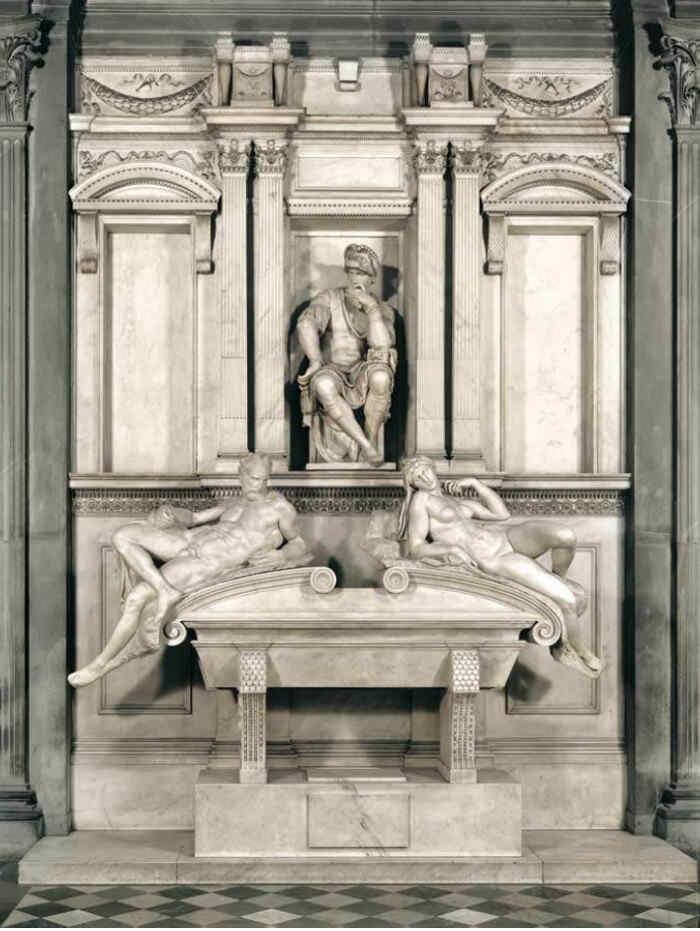
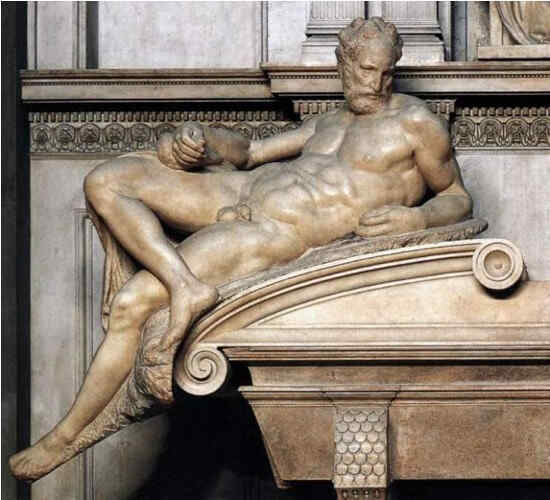
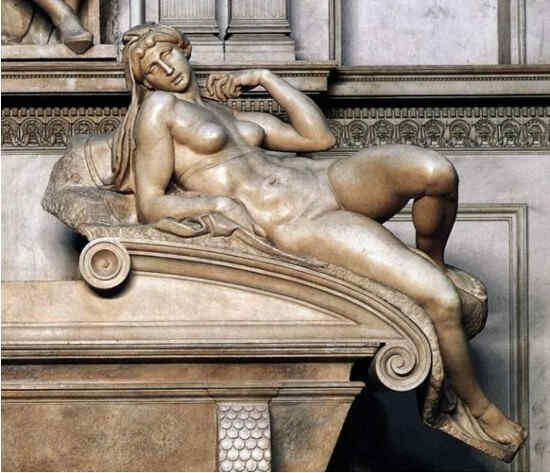
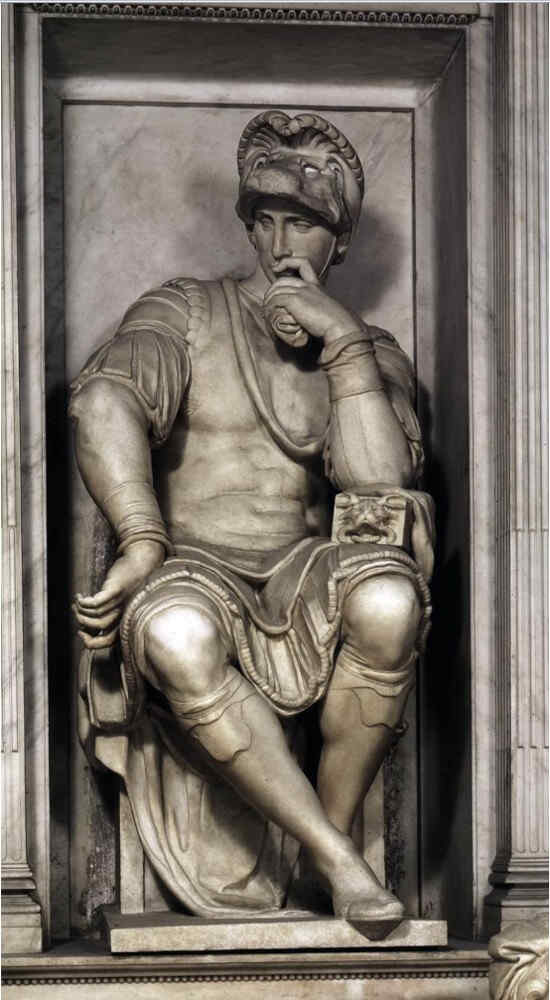
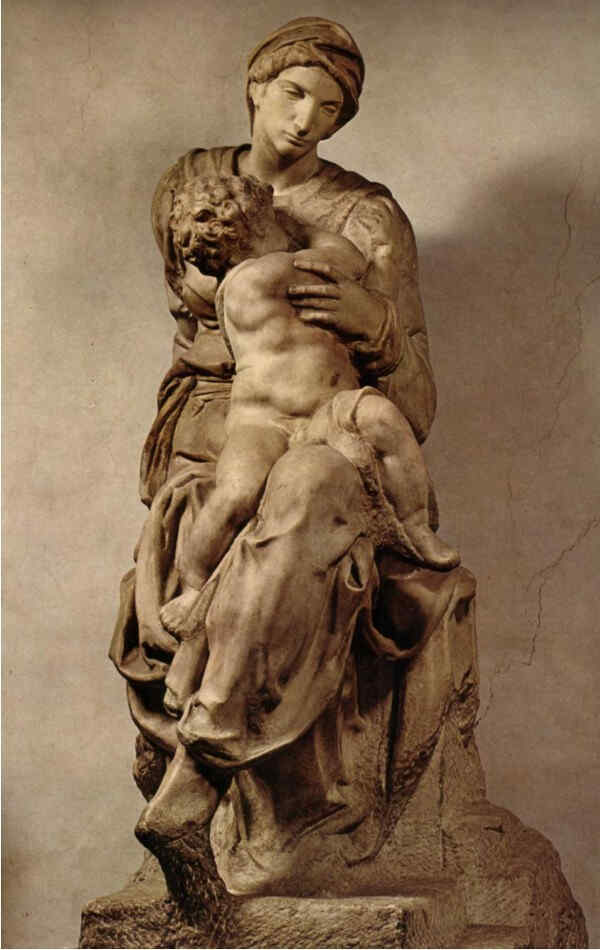
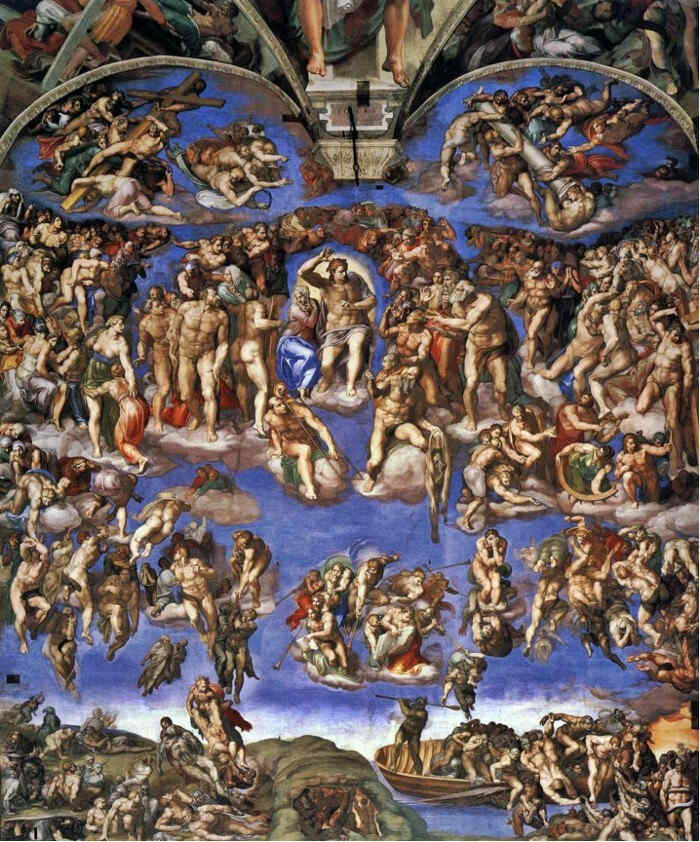
Once again we accompany Michelangelo to Rome, where he creates, once more by comman of the Pope, the Last Judgment—the altar-piece for the Sistine Chapel. The greatness of this piece lies in the characterisation, the universal significance of the characters. Consider in this picture all that is destined, as it were, for Heaven, all that is destined for Hell, and Christ in the centre, as the cosmic Judge. You will see how Michelangelo sought to harmonise this cosmic scene. Majestically as it was conceived, with an individual and human feeling. Hermann Grimm drew the head of Christ from the immediate vicinity, and it proved to be very similar to the head of the Apollo of Belvedere. We will now show some of the details.
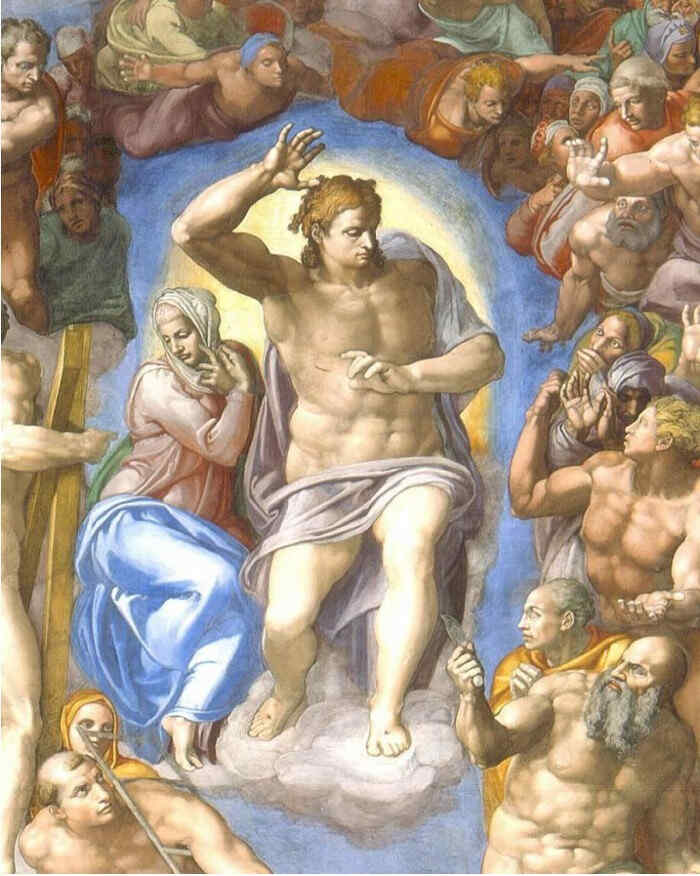
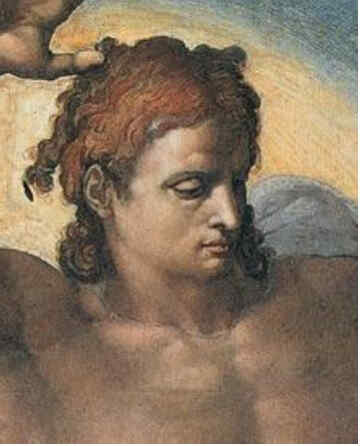
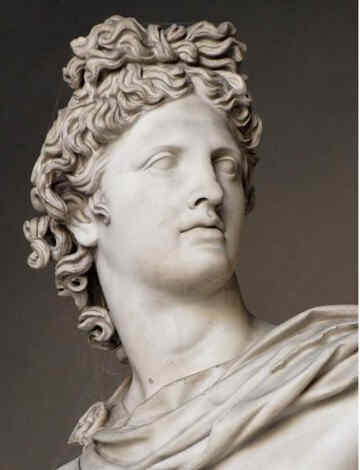
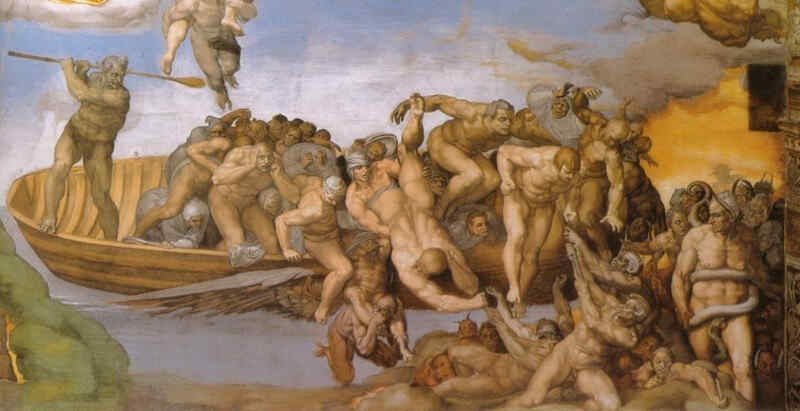
and another detail, the group above the boat:
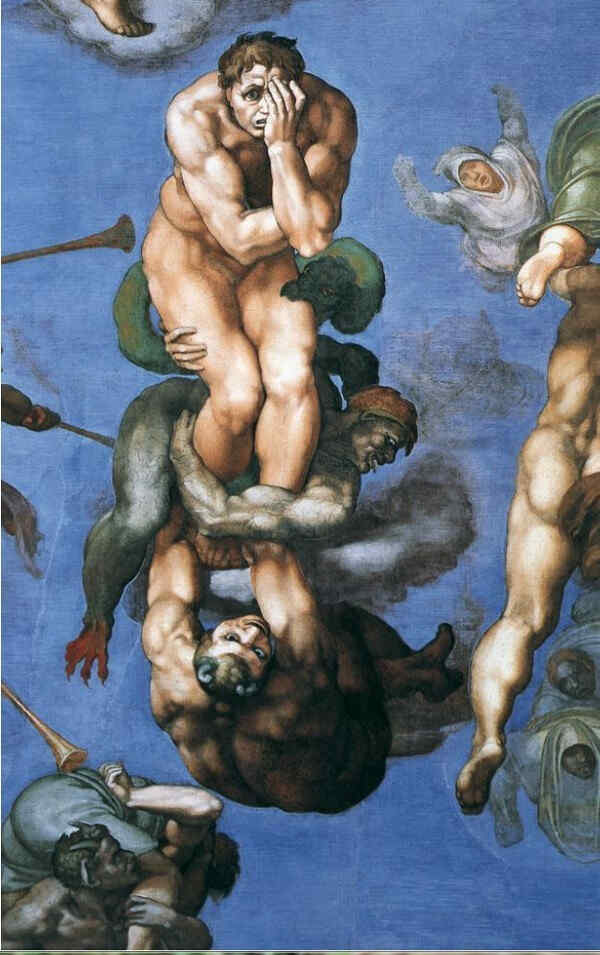
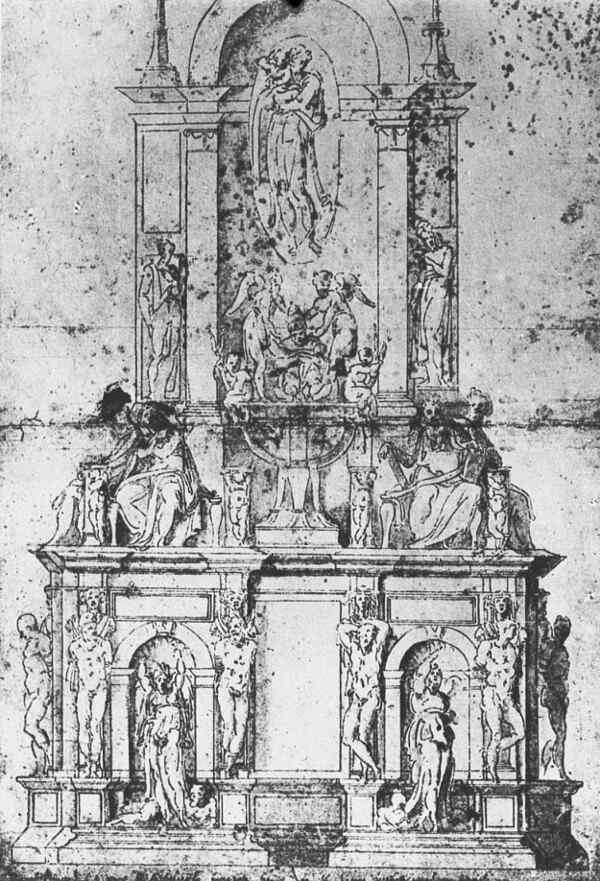
And now, though in time it belongs to a somewhat earlier period, we give what Michelangelo created for the monument of Pope Julius; for, in fact, this was never finished, and Michelangelo was working at it in the very latest period of his life and finished portions of it.
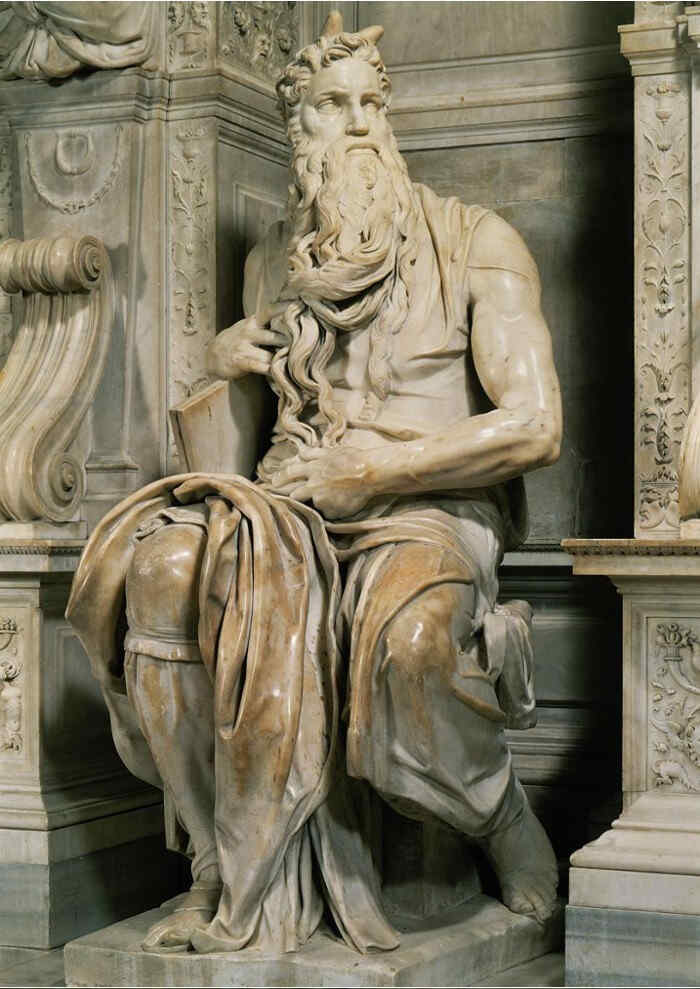
It is significant that Pope Julius II, whose character undoubtedly contained a certain greatness, called for this monument to be erected to his efforts. It was to have included a whole series of figures, perhaps thirty in number. It was never completed, but there remained this, the greatest figure in connection with it—Michelangelo's famous figure of Moses, of which we have often spoken,—and the two figures now following:
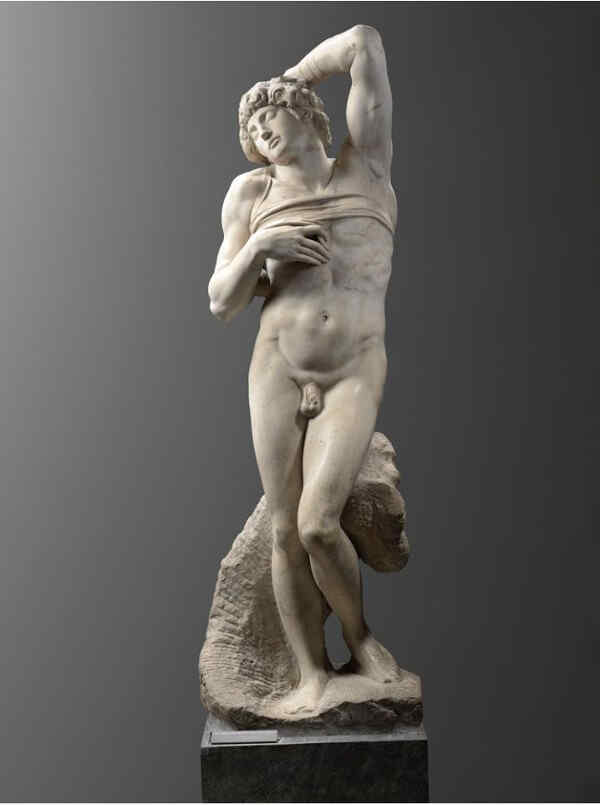
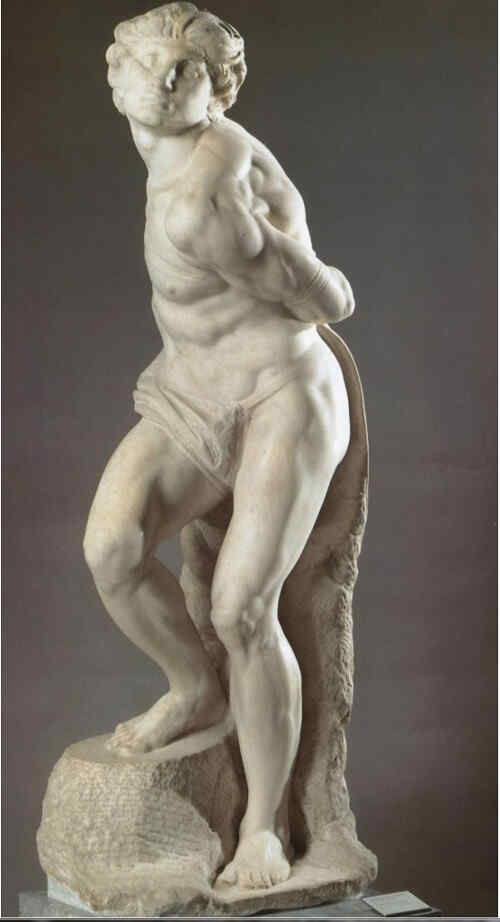
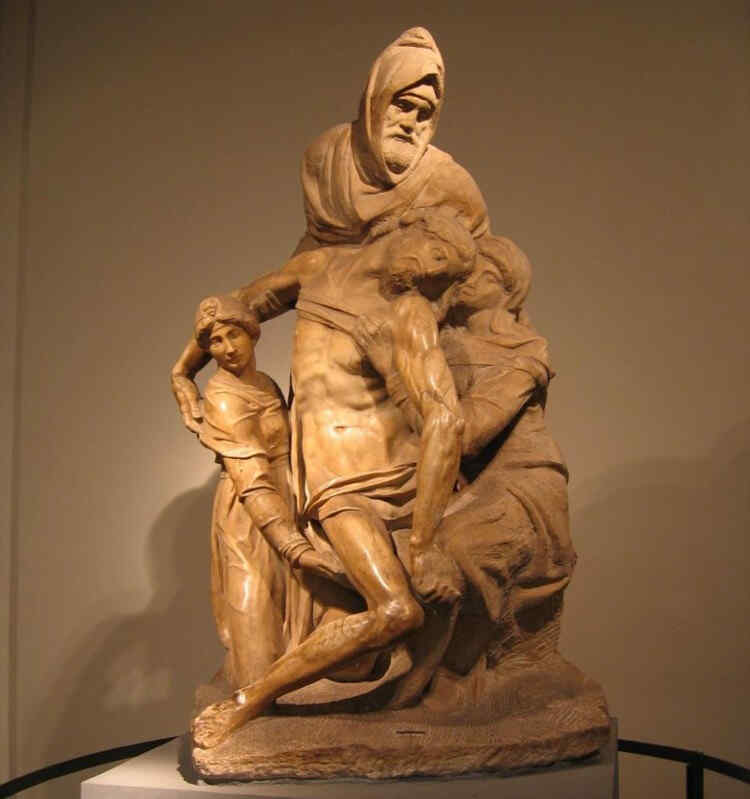
This was completed in the very latest period of his life. It is hard to say exhaustively how it arose. One thing is certain: the group expresses an idea which Michelangelo carried with him throughout his life. Whether there was another group which has somehow been lost, in which he treated this scene at a very early stage in his career, or whether it was the same block at which he worked again, remodelling it at the end of his life, it is hard to say. But we see it here as his last work. Not only is it the one which he completed when he was a very old man; it corresponds to an artistic idea which he carried throughout his long life, and is connected far more deeply than one imagines with the fundamental feeling of his soul. True, he could not have created it thus at every phase of his life. It would always have turned out a little differently; it would always have reproduced the basic mood of his soul in a somewhat different way. But the deep and pure Christian feeling that lives in Michelangelo comes to expression especially in this particular relationship of Christ to the Mother, in this scene of the entombment. Again and again the idea of the Mystery of Golgotha arises in the soul of Michelangelo in this way:—He feels that with the Mystery of Golgotha a deed of Heavenly Love took place, of an intensity that will hover for ever before the eyes of man as a sublime ideal, but that can never be attained by man even in the remotest degree, and must therefore inspire with a tragic mood him who beholds these World-events.
And now imagine, with this idea living in his soul, Michelangelo saw Rome becoming Jesuitical. With this idea in his soul, he underwent all the feelings of which I spoke; and whatever he saw in the world, he measured in relation to this standard. Truly, he underwent much in his long life. While he was creating his earliest artistic works in Florence, the Pope in Rome was Alexander VI, the Borgia. Then he was summoned to Rome, and painted the Creation of the World for Pope Julius. We see the dominion of the Gorgias in Rome replaced by Pope Julius, and then by the Medici, Leo X. In this connection we must realise that Pope Julius II, although he worked with poison, murder, slander, etc., was none the less in earnest about Christian Art. Pope Julius, who replaced the political Borgia princes, strove for the Papal See in order to make it great through spiritual life. Although he was a man of war, nevertheless, in his inmost soul, even as a fighter, he only thought of himself as in the service of spiritual Rome. Of Julius II we must not fail to realise that he was a man of spiritual aims, thoroughly in earnest with all that lay in his impulse to re-erect the Church of St. Peter, and, indeed, with all that he achieved for Art. He was selflessly in earnest about these things. It may sot strange to say this of a man who in carrying out his plans made use of poison, murder and the like. Yet such was the custom of the time in the circles with whose help he realised his plans. His highest ideal, none the less, was that which he desired to bring into the world through the great artists. For a spirit like Michelangelo it is, indeed, profoundly tragical to feel how a perfect good can never find its realisation in the world, but must always be realised one-sidedly. Yet, this was not all, for he lived to witness the transition to the commercial Popes, if we may call them so—those of the house of Medici, who were, in truth, far more concerned with their own ambitions, and were fundamentally different in spirit from Julius II and even from the Borgias. Certainly, these were no better men. We must, however, judge all these things in relation to the time itself. It is easy nowadays to feel Pope Alexander VI, or his son Caesar Borgia, or Julius II, as human atrocities; for today it is permitted to write of them quite independently and freely, whereas many a later phenomenon cannot yet be characterised with equal freedom: But we must also realise:—The sublime works achieved at that time are not without causal relationship with the characters of all these Popes,—indeed, many things would certainly not have come to pass if Savonarola or Luther had occupied the Papal See. And now we come to Raphael.
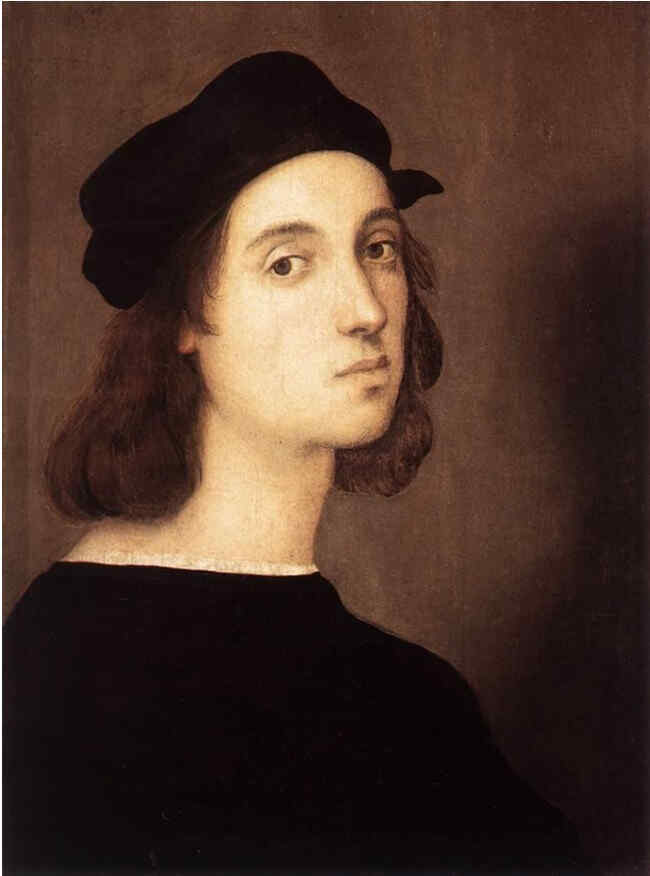
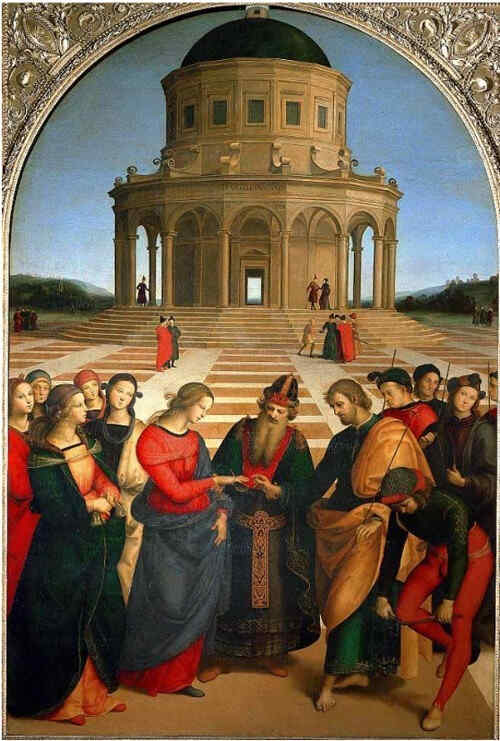
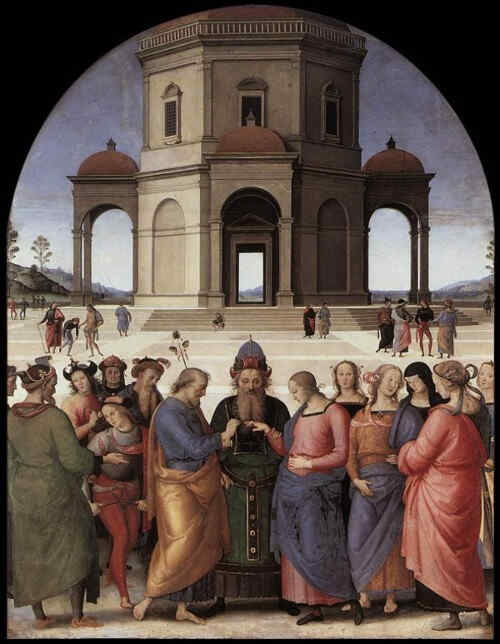
Here is the picture of which I spoke last time. We will bring it before our souls once more. On the left we have the same subject treated by Perugino, and on the right by Raphael. It is the Sposalizio or Marriage of the Virgin. Here you can see how Raphael grew out of the School of his teacher, Perugino, and you can recognise the great advance. At the same time, we see in the picture on the left all that is characteristic of this School on the level from which Raphael began. See the characteristic faces, their healthily—as we today call it—sentimental expression. See the peculiar postures of the feet. A certain characterisation is attempted; yet it is all enclosed in a certain aura of which I spoke before,—which appears again in Raphael, transfigured, as it were, raised into a new form and power of composition. You recognise here the growth of this power of composition, too. But if you compare the details, you will find that in Raphael it is grasped more clearly and yet at the same time it is more gentle, it is not so hard.
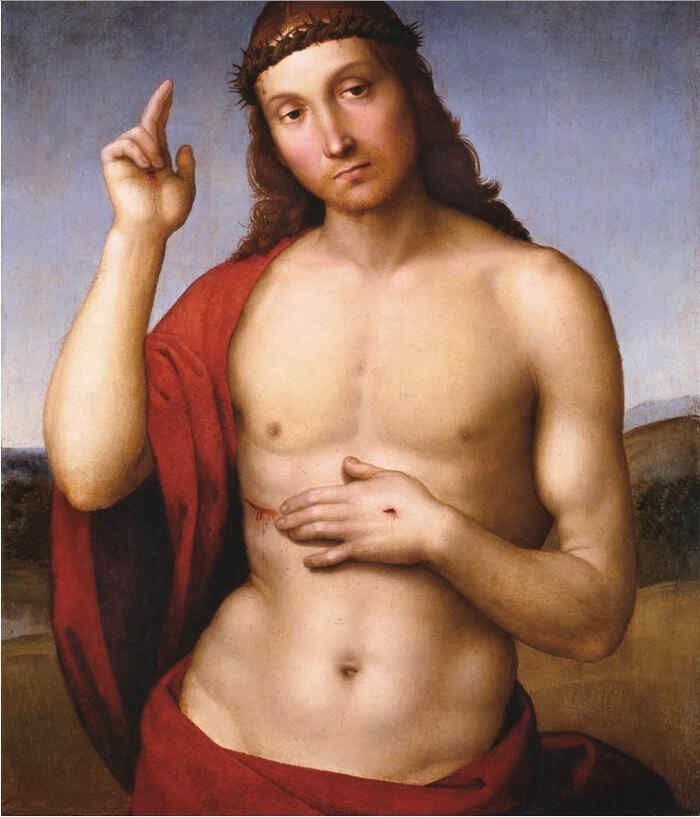
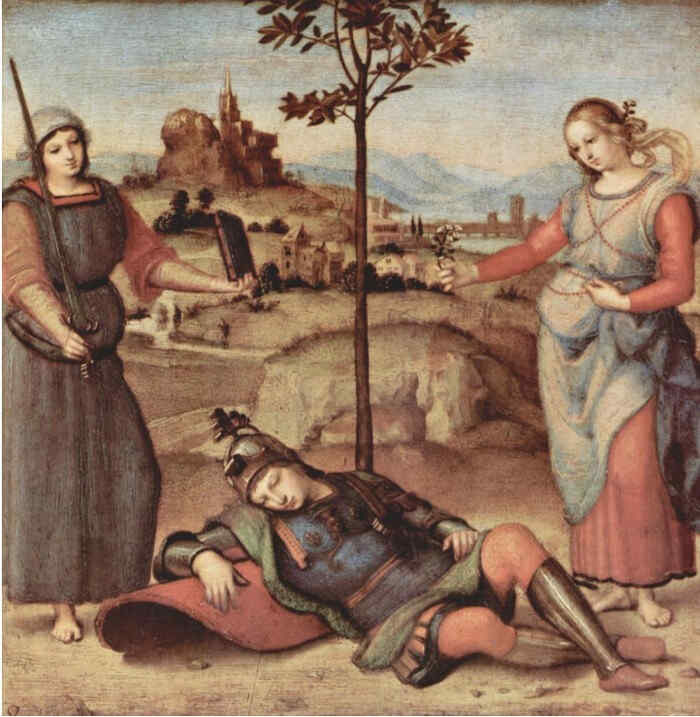
This whole picture is to be conceived of as a world of dream. It is generally known as the “Dream of a Knight.”
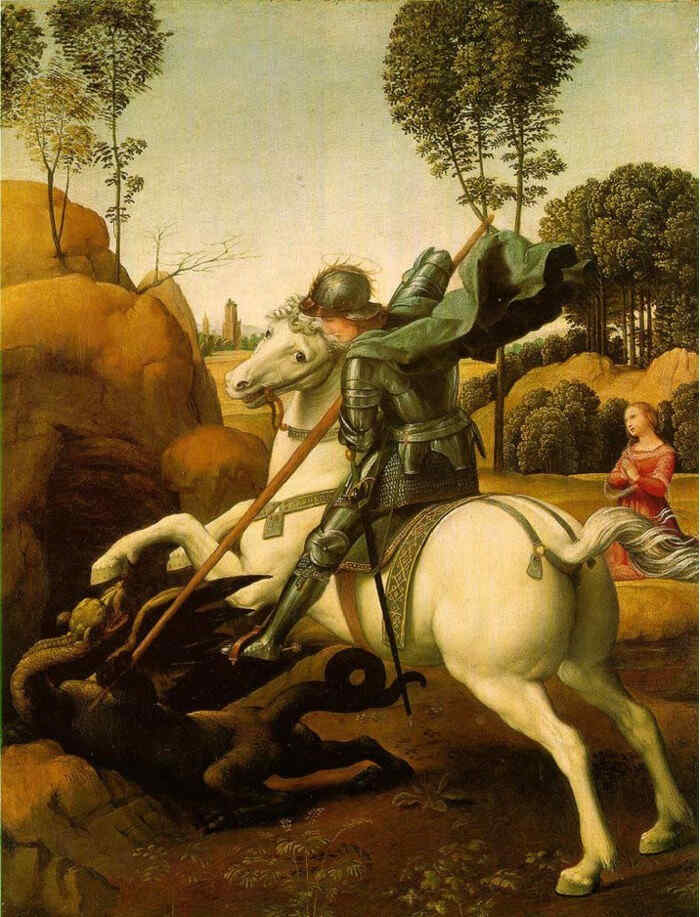
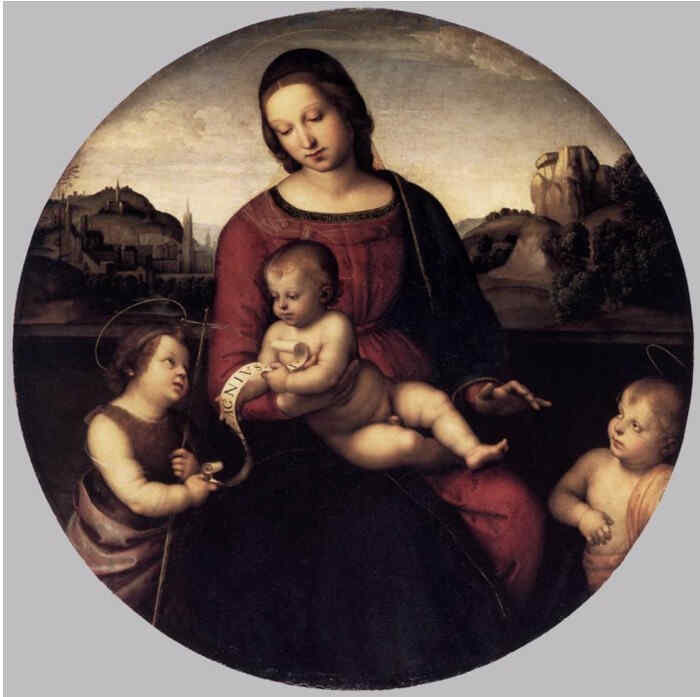
We will now let work upon us a number of Raphael's pictures of the Madonna and of the sacred legend. These—especially the Madonnas—are the works of Raphael which first carried him out into the world.
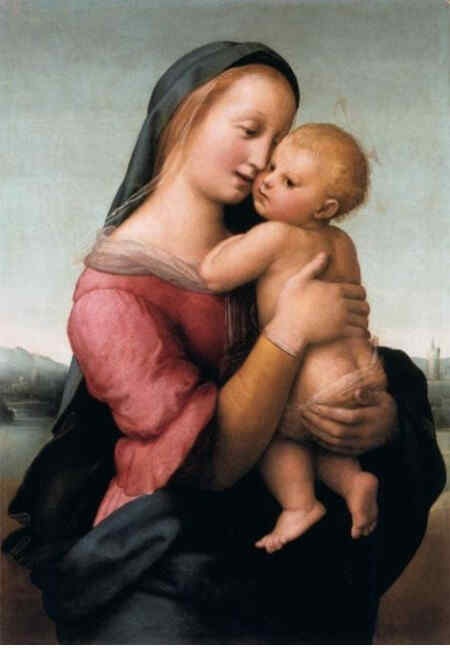
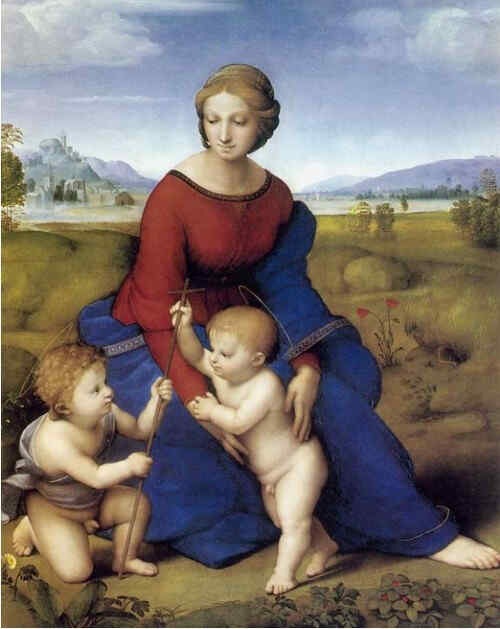
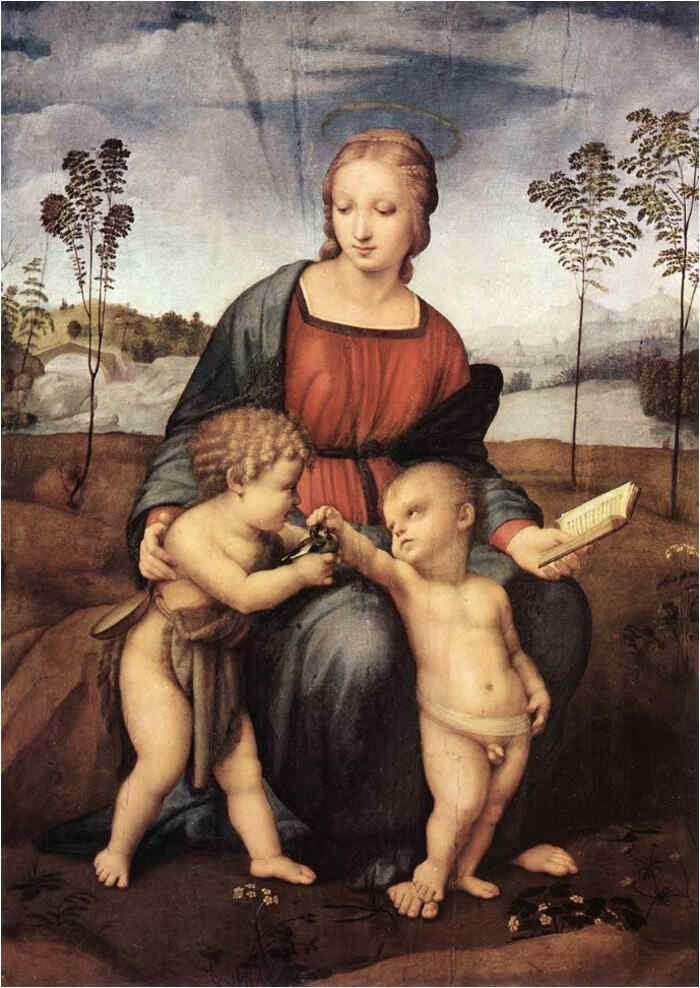
In all these pictures you still have the old, characteristic postures and attitudes which Raphael took with him from his home country.
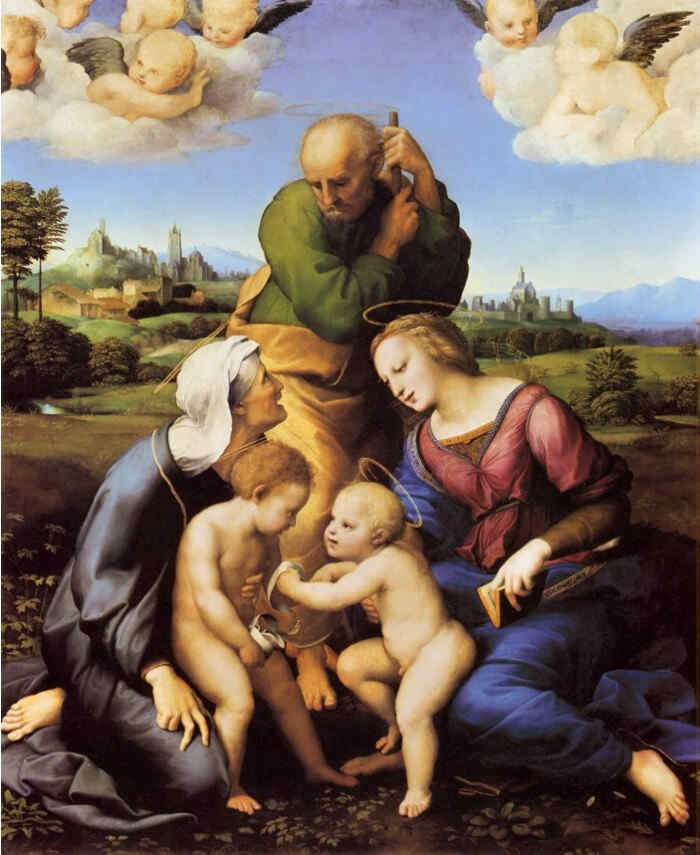
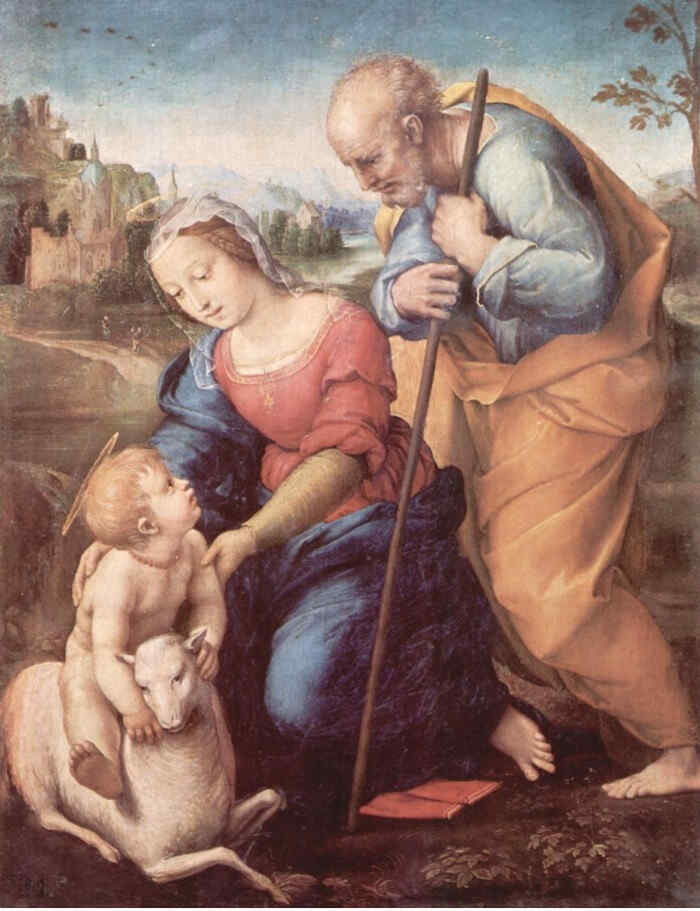
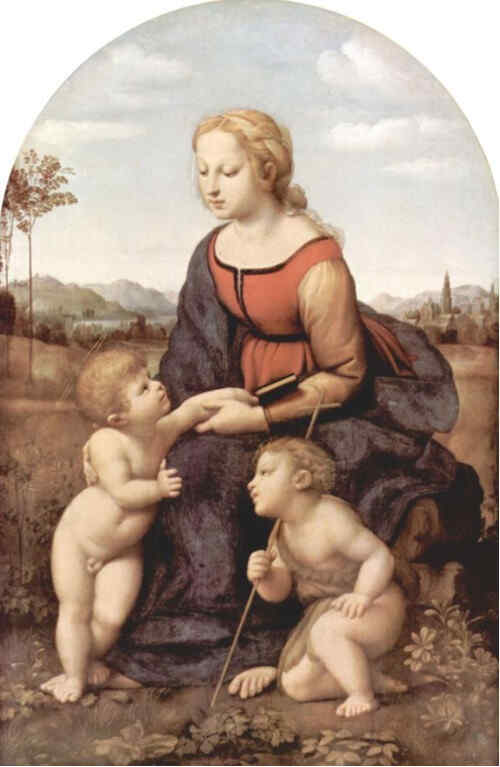
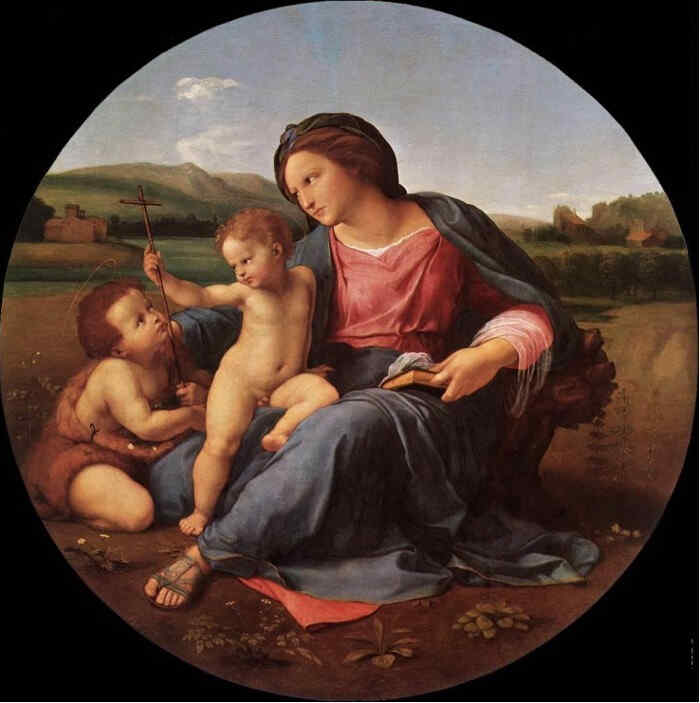
These are the Madonnas which bear witness to the further development of Raphael. Ile follow him now into the time when he went to Rome. It is not known historically exactly when that was. Probability is that he did not simply go there in a given year,—1500 is generally assumed—but that he had been to Rome more than once and gone back again to Florence, and that from 1500 onward he worked in Rome continuously. Now, therefore, we follow him to Rome and come to those pictures which he painted there for Pope Julius.
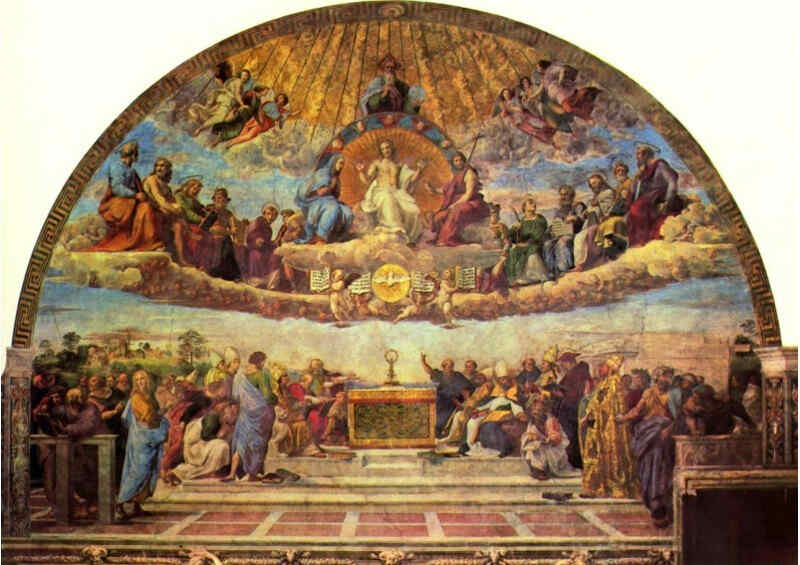
This picture is well-known to you all, and we, too, have spoken of it in former lectures. Many preparatory sketches of it exist. In the form in which you see it here, it was done to the order of the Pope,—the Pope who craved, as I said just now, to make Rome spiritually great.
We must, however, hold fast to one point, which is revealed by the fact that some elements of the motif of this picture appear at a very early stage, even in Perugia, representing this idea, this scene, or, rather, the motif of it.
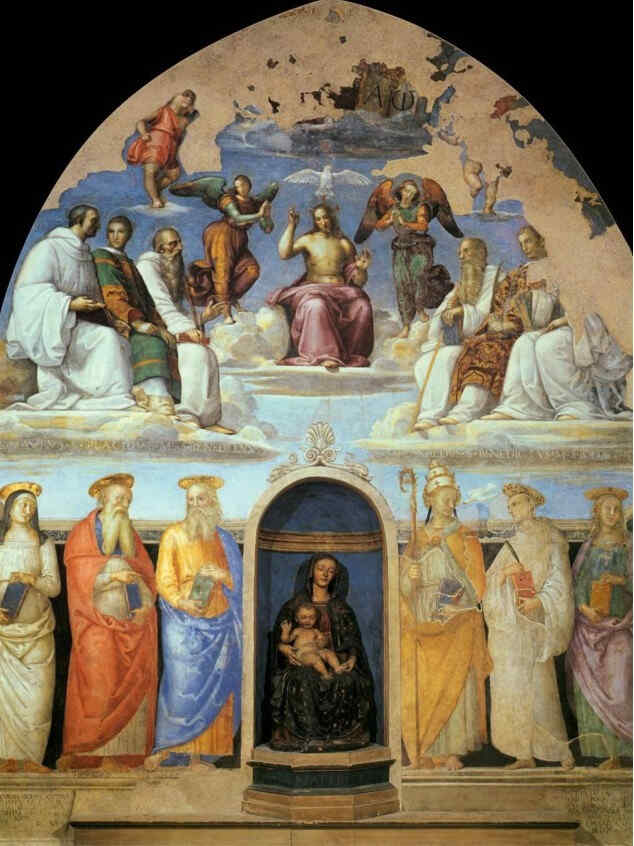
Thus the idea was already living at that early stage, and was able to take shape in this remarkable corner of East-Central Italy.
We must conceive the motif of the picture as living in the very time itself. Below are the human beings—theologians, for the most part. These theologians are well aware that everything which human reason can discover is related to what St. Thomas Aquinas called the “Praeambula Fidei,” and must be permeated by what comes down from Spiritual Worlds as real inspiration, wherein are mingled the attainments of the great Christian and pre-Christian figures of history, and by means of which alone the secret of the Trinity is to be understood. This mystery, we must conceive, bursts down into the midst of the disputations of the theologians below. We may conceive that this picture is painted out of the will to unite the Christian life quite fundamentally with Rome—to make Rome once more the center of Christianity by rebuilding the derelict Church of St. Peter, according to the desires of Pope Julius. Under the influence of the Pope, wishing to achieve a new greatness of Christianity centered in Rome, such ideas are brought together with the fundamental concept; the secret of the Trinity. This fact explains what I may call, perhaps, the outer trimmings of the picture. (Even in the architectural elements which it contains, we see designs which re-occur in St. Peter's.) It is as though this picture were to proclaim: Now once again the secret of the Trinity shall be taught to the whole world by Rome. There are many preliminary sketches showing not only that Raphael only by and by achieved the final composition, but that this whole way of thinking about the inspiration, the Idea of the Trinity had been living in him for a long time. It was certainly not the case that the Pope said: “Paint me such and such a picture.” He rather said, “Tell me of the idea that has been living in you for so long,” and thus together, so to speak, they arrived at the conception which we now see on the wall of the Segnatura.
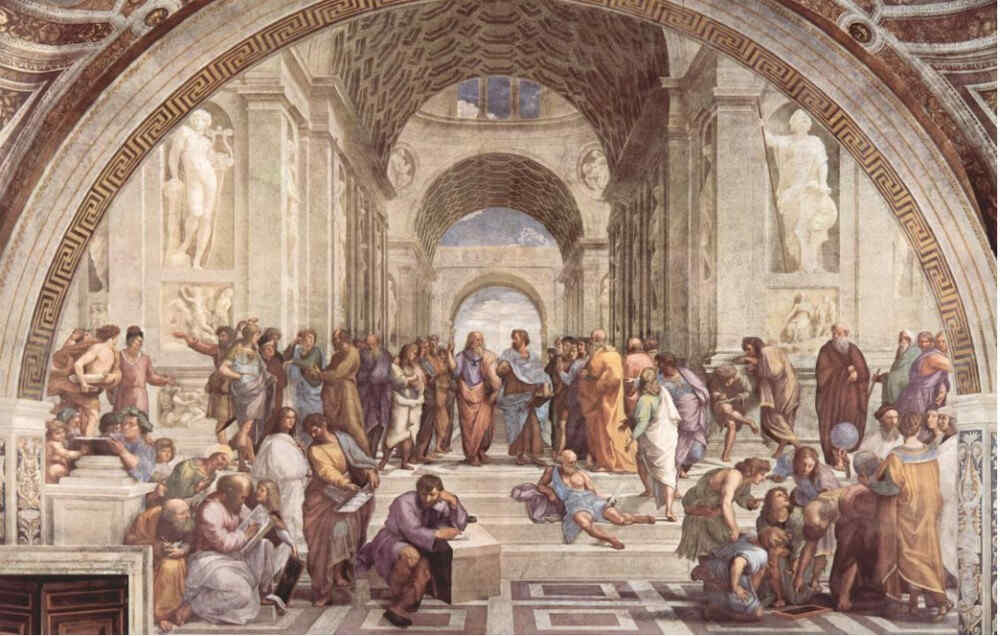
Now we come to the picture which, as you know, is commonly named the School of Athens, chiefly because the two central figures are supposed to be Plato and Aristotle. The one thing certain is that they are not. I will not dwell on other views that have been put forward. I have spoken of this picture, too, on previous occasions. But they are certainly not Plato and Aristotle. True, we may recognise in these figures many an ancient philosopher, but that is not the point of the picture. The real point is, that in contrast to what is called “Inspiration” Raphael also wished to portray what man receives through his intelligence when he directs it to the supersensible and applies it to investigate the causes of things. The various attitudes which man can then assume are expressed in the several figures. No doubt Raphael introduced the traditional figures of ancient philosophers, as, indeed, he always tried to make use of this or that tradition. But that is not his real point; the point was to contrast the supersensible Inspiration, the descent of the super-sensible as an inspiration to man, on the one hand; and on the other hand the attainment of a knowledge of the world of causes through the intelligence of man directed to the Supersensible. In this sense, the two central figures are to be understood as follows: On the one hand we have a man still in the younger years of life, a man with less experience of life, who speaks more as a man who looks around him on the Earth, there to perceive the causes of things. Beside him is the old, old. man who has assimilated very much in life, and knows how to apply what he has seen on Earth to heavenly things. And then there are the other figures who, partly by meditation, partly by arithmetical, geometrical or other exercises, or by the study and interpretation of the Gospels and the sacred writings, seek to discover the causes of things by applying their human intellect. I have already spoken of these things and I believe that Lecture, too, has been made accessible. I think if we take the contrast of the two pictures in this way, we shall not be misled into nonsensical speculations as to whether this one is Pythagoras or the other Plato or Aristotle—which speculations are at all events beside the mark and inartistic. Much ingenuity has been applied in deciphering the several figures: Nothing could be more superfluous in relation to these pictures. Rather should we study to observe the wonderful varieties expressed in the search for all that is attainable by the intelligence of man.
You may also compare the two pictures. In this present picture the whole thing is placed in an architectural setting, whereas in the other, the “Disputa,” the wide World is the setting. It is the difference between Inspiration whose house is the great universal edifice and the quest of the human intelligence which, as you see it here, goes on in an enclosed and human space.
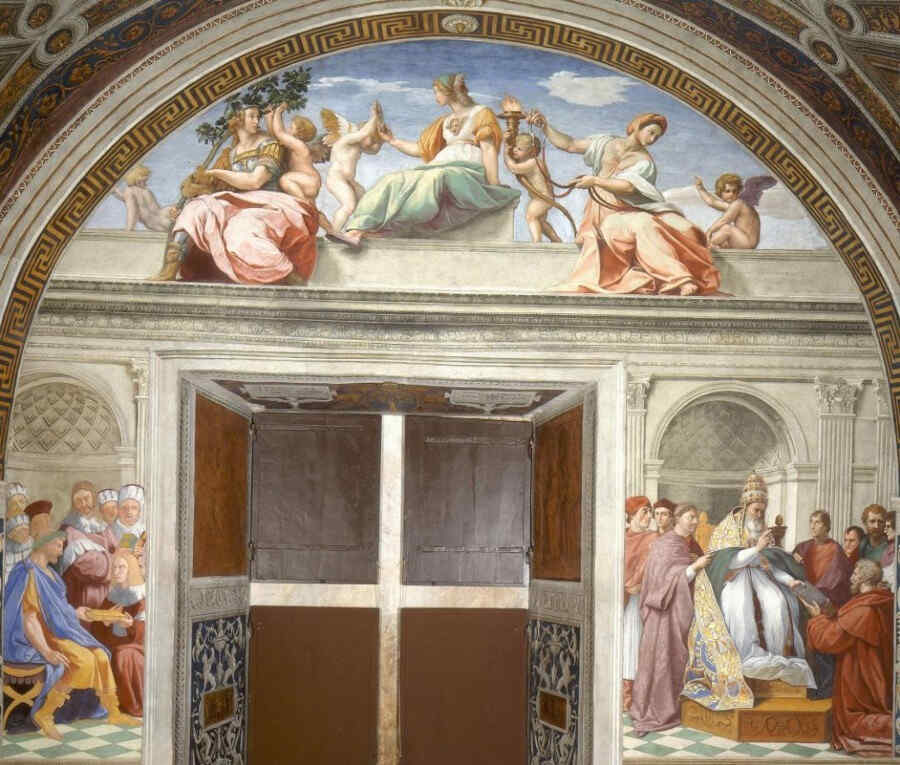
We come to what is attainable in the human sphere, without the latter being influenced out of the supersensible.
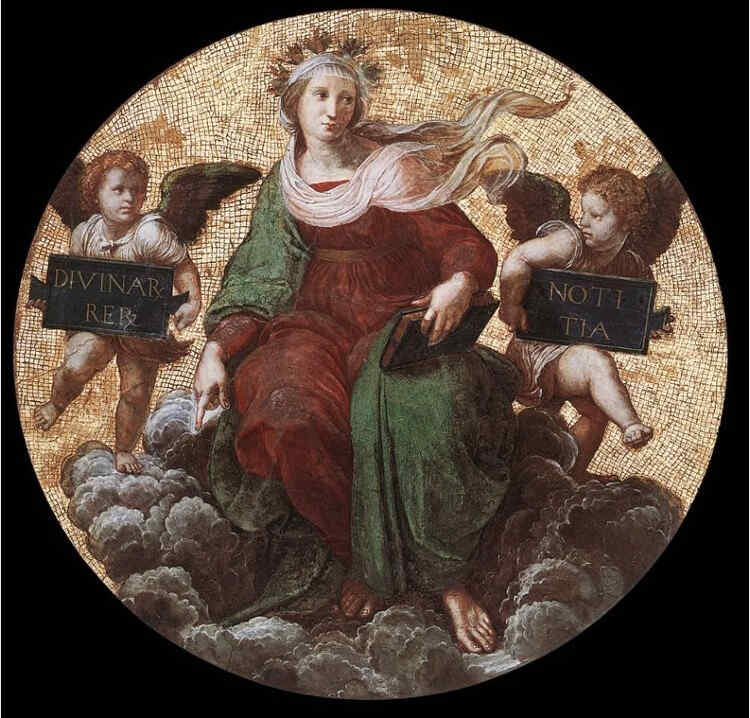
This is like a commentary to the Disputa—the knowledge of the Divine Mysteries represented in a more allegorical figure, and leading on to the Disputa.
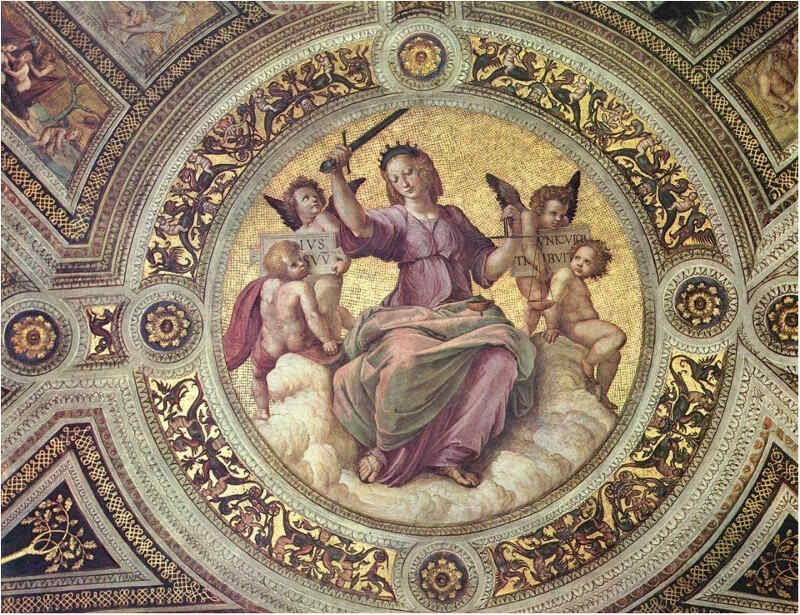
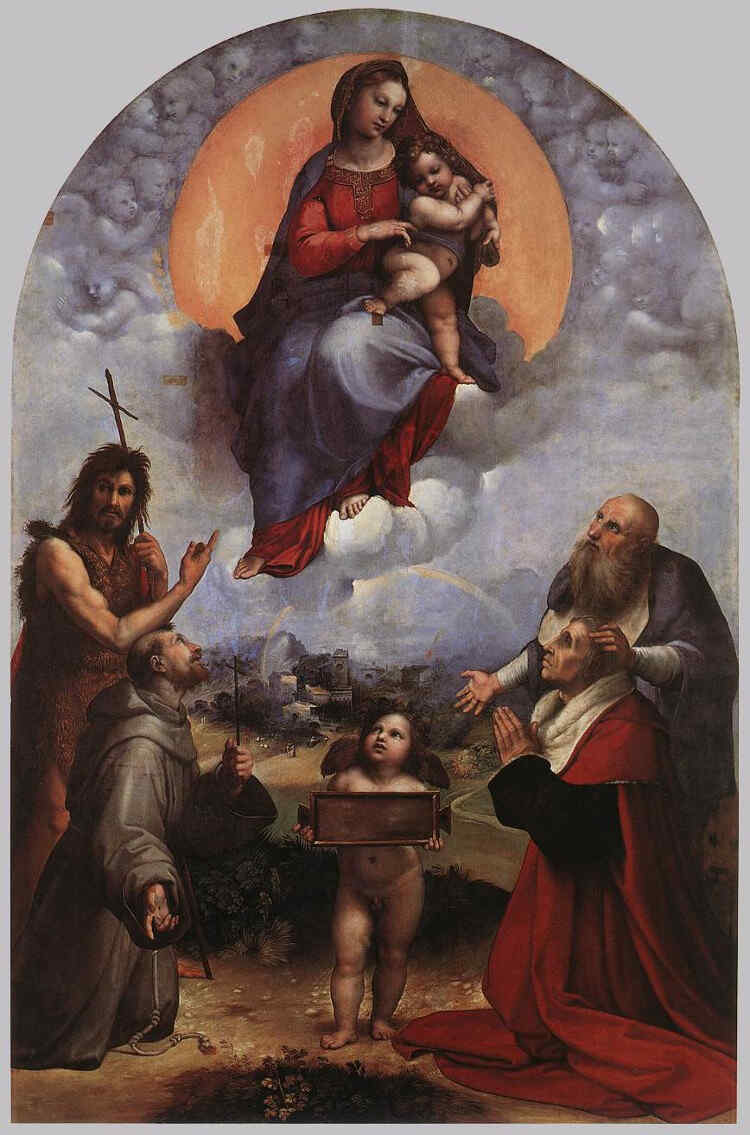
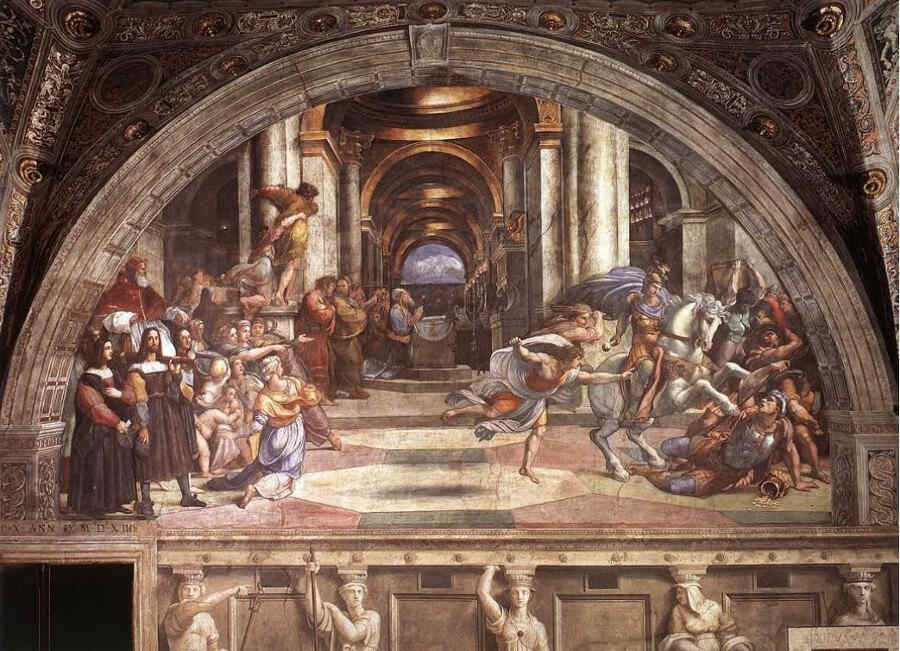
Here we have a picture taken from the whole complex which Raphael did for Pope Julius II in order to inspire the idea that Christianity must gain the victory and all that resists it must be overcome.
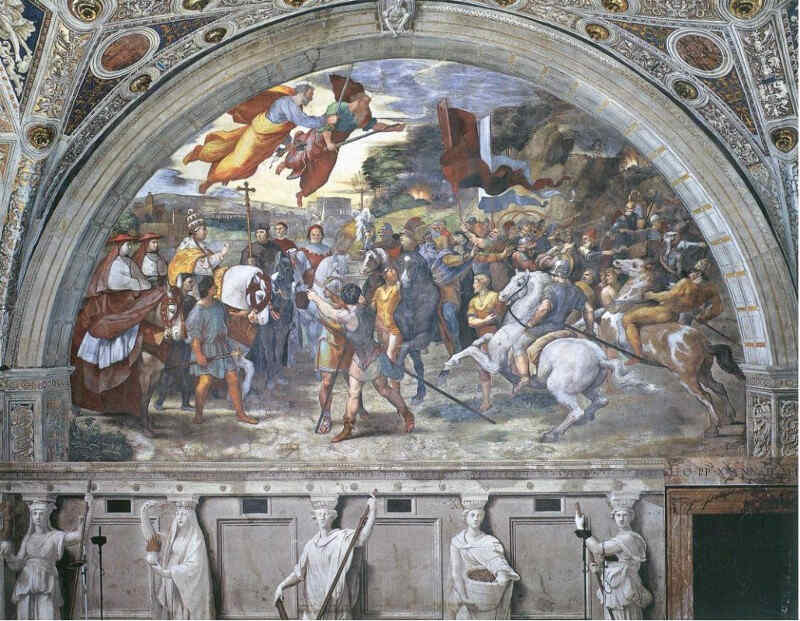
This is only another aspect of the same idea.
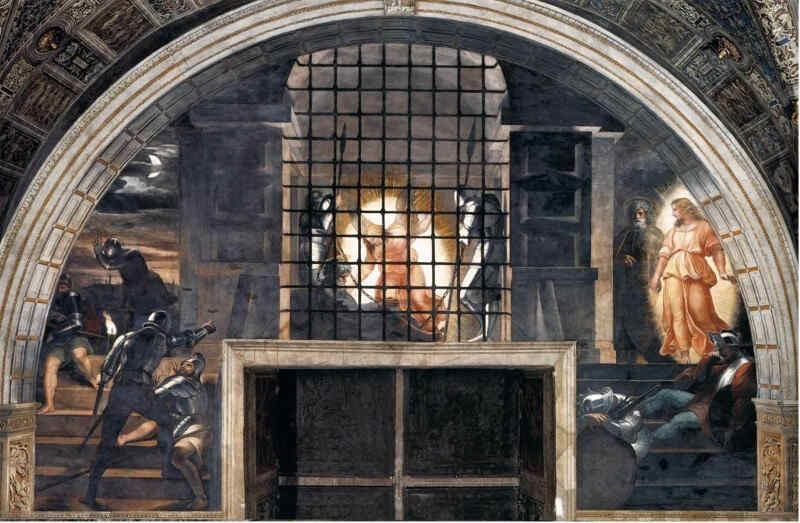
Also belonging to the same group.
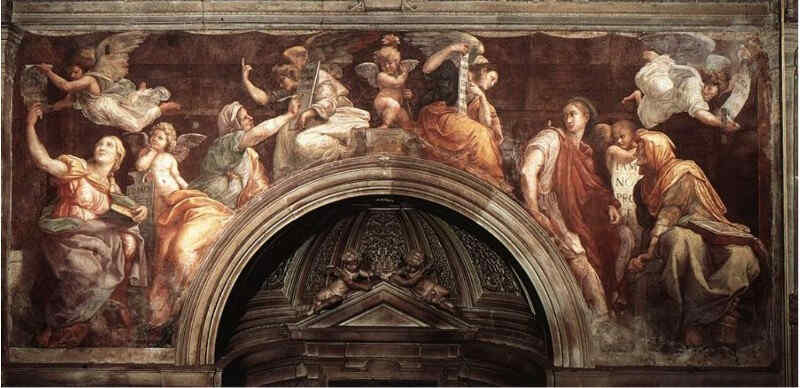
Raphael's Sibyls. If you remember those of Michelangelo, you will observe the immense difference. In the Sibyls of Raphael—I beg you to see it for yourselves—human figures are portrayed, to represent beings standing within the cosmos,—Beings into whom the whole cosmos is working. They themselves are dreaming, as it were, within the cosmos as a very part of it and have not fully come to consciousness. The various supersensible Beings, angelic figures between them, bring them the secrets of the worlds. Thus they are dreamy Beings, living within the universal nexus. Michelangelo, on the other hand, portrays the human and individual in all that his Sibyls are dreaming, or evolving out of their dream-consciousness. Michelangelo has to create out of the individual, nay, we may even say, the personal character of each one. These Sibyls of Raphael, on the other hand, live and move and have their being over and above the individual. Even inasmuch as they are individual, they live and move in a cosmic life.
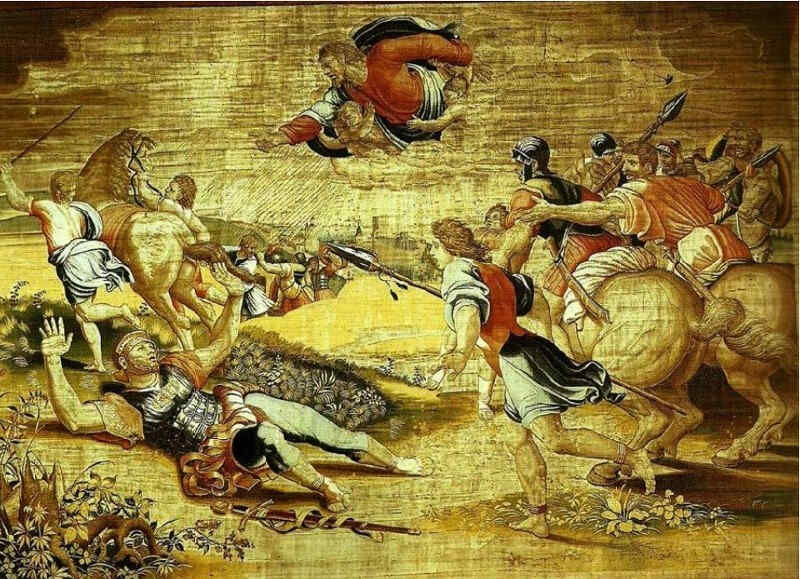
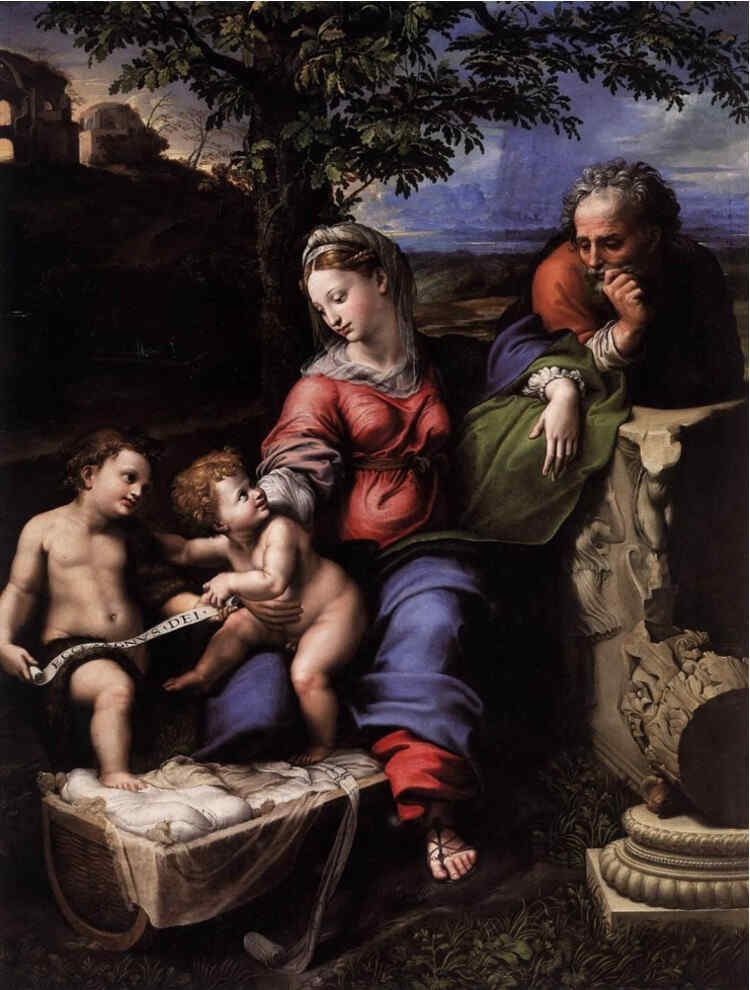
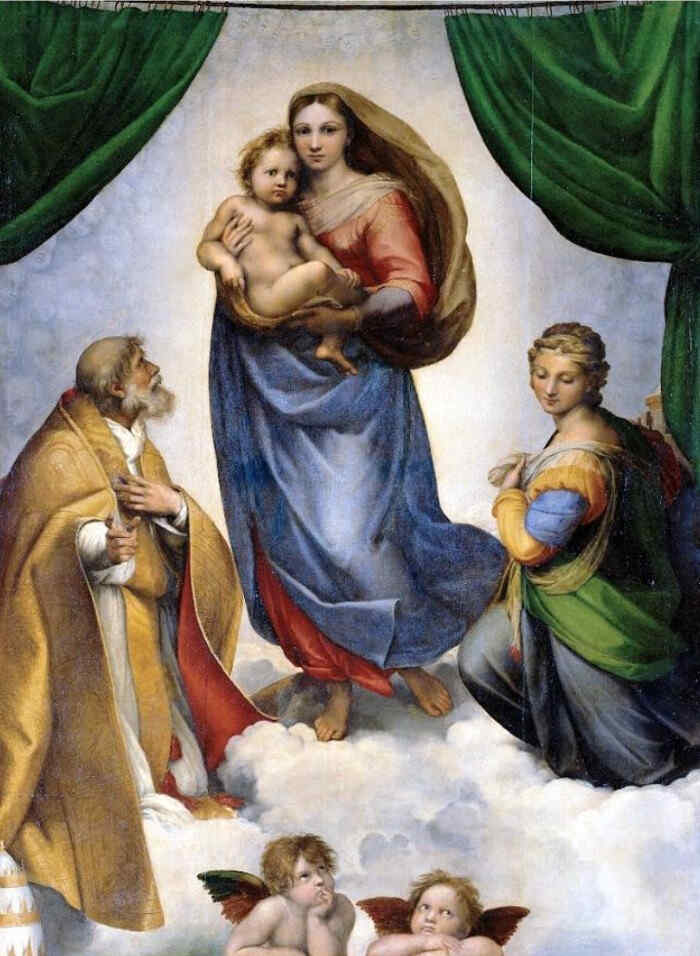
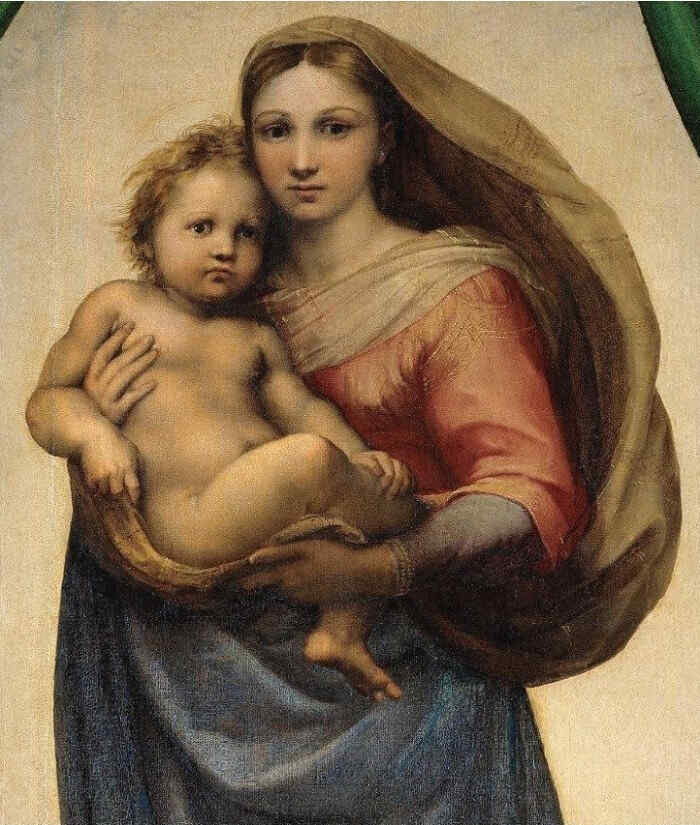
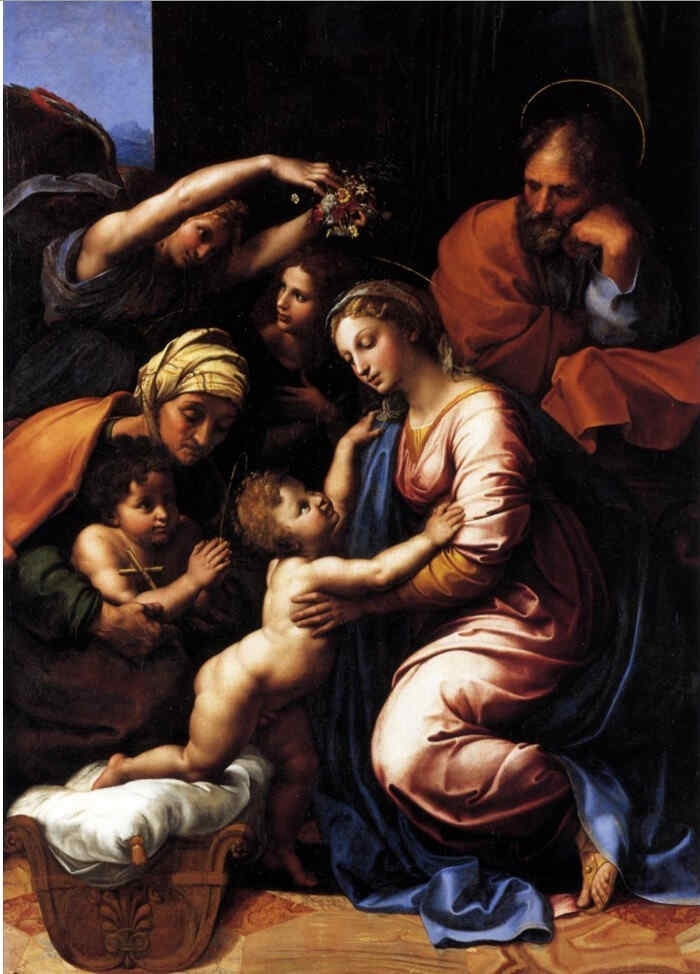
In this room we have the picture of the Transfiguration. (No picture of room available)
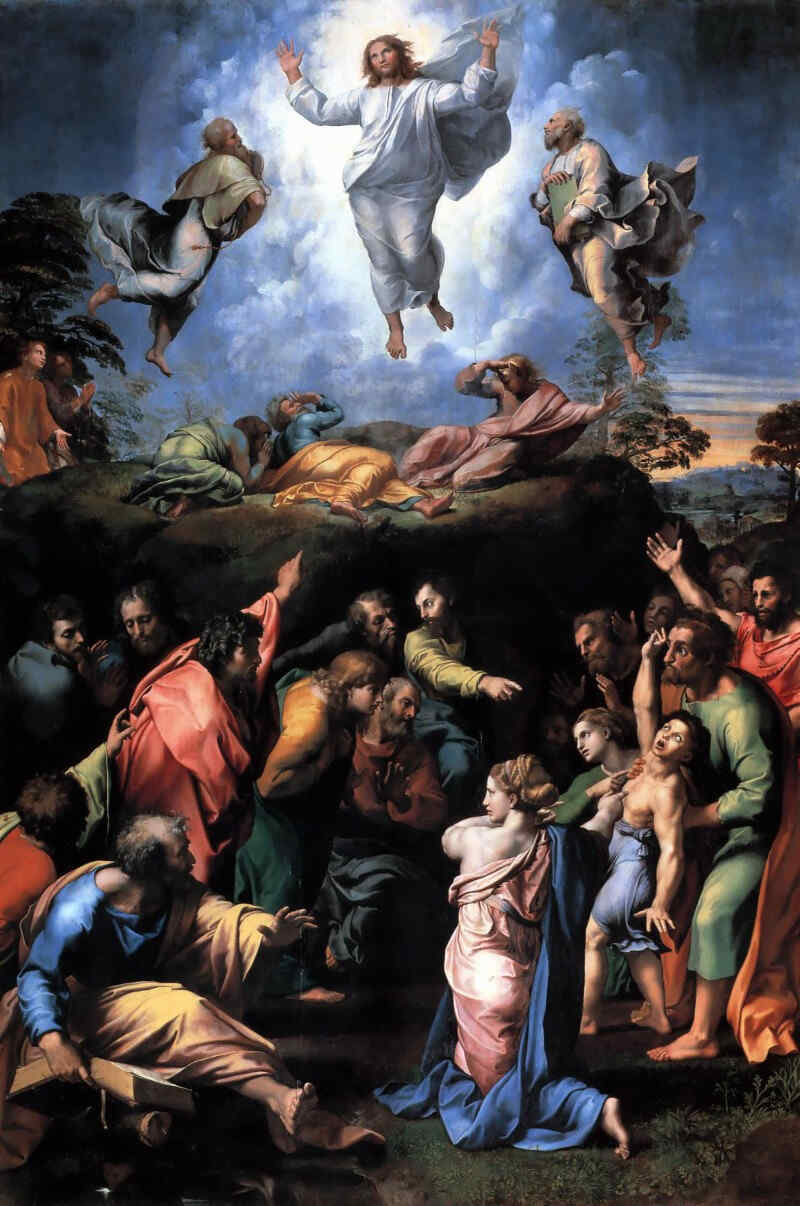
Here is the picture itself. It is even possible that Raphael himself did not complete it, but left it unfinished at his death. Christ is soaring heavenward.
To those who say that Raphael in his latest period painted visionary pictures, we need only reply by pointing to this figure (the figure of the boy). It is portrayed in a perfectly real, Occultly realistic sense, how the figure makes it possible for the scene to become visible to the others. Through what I would call the mediumistic nature of the unconsciousness of madness, this figure influences the others, enabling them to behold such a thing as this.
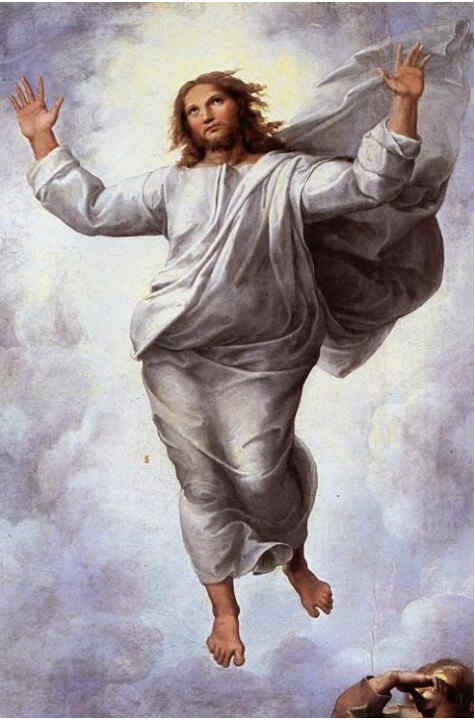
Here we have the figure of the Christ.
And now, my dear friends, think of all that Raphael had painted. All that has passed before you was contained between his twenty-first and his thirty-seventh year, in which he died. In his twenty-first year he painted the first picture which we showed—the Marriage of the Virgin—contrasting it with Perugino's painting. Hermann Grimm worked out in a beautiful way something that bears eloquent witness to Raphael's free and independent evolution, proving even outwardly to some extent what I just said before. Raphael, although he was carried on the waves of time, and learnt, of course, very much from the world, nevertheless took with him into Rome the peculiar nature of that Middle-Eastern part of Italy. In spite of his youth, he created out of his own inmost nature and progressed undisturbed, with perfect regularity in his evolution. Hermann Grimm pointed out that we come to the chief culminating points in Raphael's creative work if, starting from his twenty-first year, we go forward in successive periods of four years. From his twenty-first year we have his Sposalizio; four years later the Entombment, which we have not shown today—an exceedingly characteristic picture, which, especially when we take into account the related sketches and everything connected with it, expresses a certain climax in the work of Raphael. And then, once more, four years later, we have a climax of creative work in the Camera della Segnatura in the Vatican. Progressing thus by stages of four years, we see how Raphael undergoes his evolution. He stands there in the world with absolute individuality, obeying an impulse connected only with his incarnation, which impulse he steadily unfolds and places into the world something that takes its course with perfect regularity, like the evolution of mankind.
And now consider these three figures all together,—standing out as a summit in the life of Art, in the evolution of mankind. It lies in the deep tragedy of human evolution that this supreme attainment is connected with a succession of Popes—Alexander VI, Borgia, Julius II, Leo X,—men who occupy the first position as regards their artistic aims and who were called upon to play their part in human evolution as rulers in high places. And yet they were of such a character as to take with them into these high places the worst extremes which even that age could nroduce by way of murder, misrepresentation, cruelty and poison. And yet, undoubtedly—down to the Medici, who always retained their mercantile spirit,—they were sincere and in earnest where Art was concerned. Julius II was an extraordinary man, inclined to every kind of cruelty, never scrupling to use misrepresentation and even poison as though it were, in a world-historic sense, the best of homely remedies. Yet it was rightly said of this man that he never made a promise that he did not keep. And to the artists, above all, he kept his promise to a high degree; nor did he ever bind or fetter them, so long as they were able to render him the services which he desired, in the work which he intended.
Consider, alongside of this succession of Popes, the great men who created these works—the three great characters who have passed before our souls today. Think how in the one, in Leonardo, there lived much that has not yet been developed further, even today. Think how there lived in Michelangelo the whole great tragedy of his own time, and of his fatherland, both in the narrower and in the wider sense. Think how there lived in Raphael the power to transcend his Age. For while he was most intensely receptive to all the world around that carried him as on the waves of time, nevertheless, he was a self-contained nature. Consider, moreover, how neither Leonardo nor Michelangelo could carry into their time that which could work upon it fully. Michelangelo wrestled to bring forth, to express out of the human individuality itself all that was contained in his time; and yet, after all, he never created anything which the age was fully able to receive. Still less could Leonardo do so, for Leonardo bore within his soul far greater things than his Age could realise. And as to Raphael—he unfolded a human nature which remained for ever young. He was predestined, as it were, by providential guidance to evolve such youthfulness with an intensity which could never grow old. For, in effect, the time itself, into which all that came forth from his inner impulses was born, first had to grow young. Only now there comes the time when men will begin to understand less and less of Raphael. For the time has grown older than that which Raphael could give to it.
In conclusion, we will show a few of Raphael's portraits.
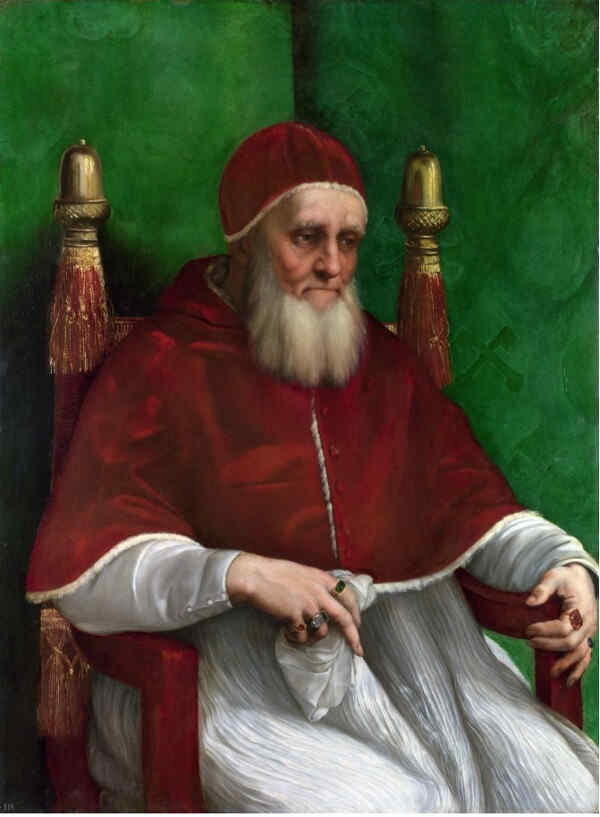
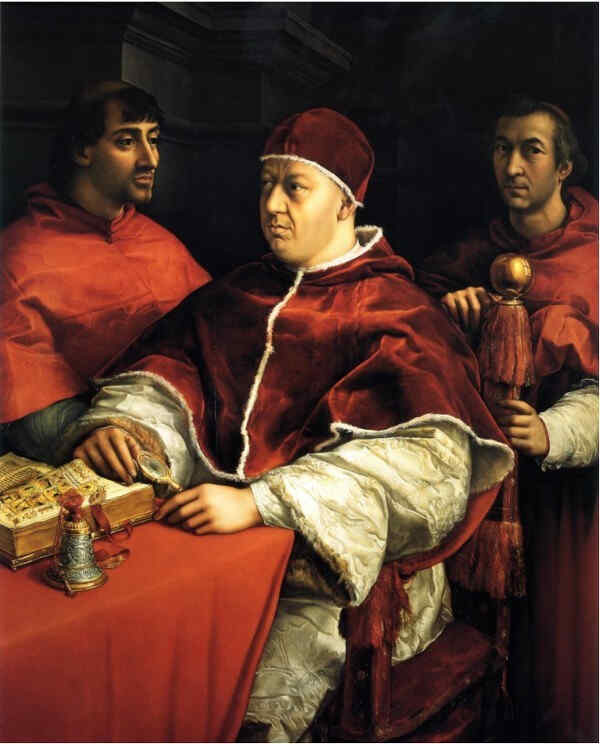
These, then, are the two Popes who were his patrons.
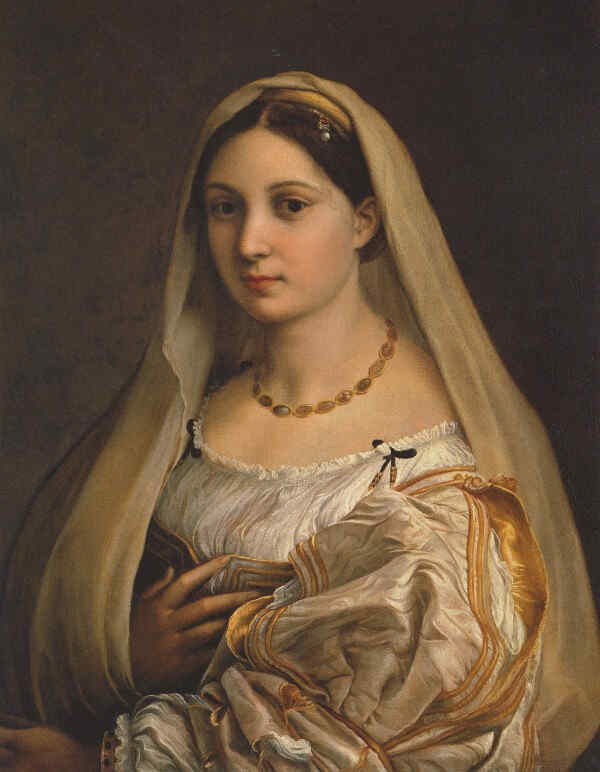
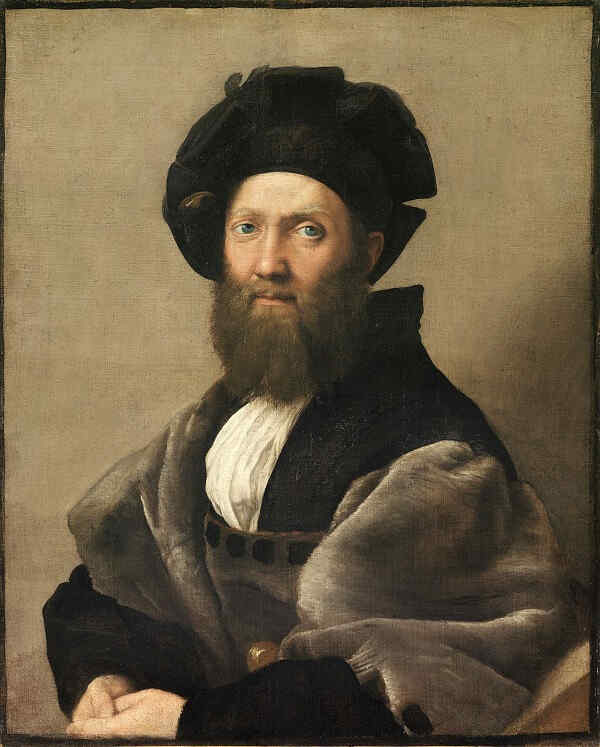
We have come to the end of our pictures.
In the near future, following on the tree great masters of the Renaissance, we shall speak of Holbein, Durer, and the other masters—the parallel phenomena of these developments in Southern Europe.
Today I wanted especially to bring before our souls these three masters of the Renaissance. I have tried to describe a little of what was living in them, and of their stimulus if, starting from any point of their work, you dwell on the historic factors which influenced and entered into them. You will perceive the necessary tragedy of human history, which has to live itself out in one-sidedness. We can learn much for our judgment of all historic things, if we study how the world-historic process played into that Florentine Age whose greatness is identified with Raphael, Michelangelo and Leonardo. Today especially I fancy no one will regret the time he spends in dwelling on a historic moment like the year 1505, when Michelangelo, Leonardo and Raphael were at the same time in Florence—Raphael still as a younger man, learning from the others; and the other two vying with one another, painting battle-pieces, glorifying the deeds that belonged to political history. Especially at the present moment, anyone who has vision for the facts of history in all its domains, and sees the significance of outward political events for the spiritual life, will profit greatly by the study of that time. Consider what was working then:—how the artistic life sought and found its place in the midst of the outer events, and how through these artistic and external events of the time, the greatest impulses of human evolution found their way. See how intimately there were interwoven human brutality and high-mindedness, human tyranny and striving towards freedom. If you let these things work upon you from whatever aspect, you will not regret the loss of time, for you will learn a great deal even for your judgment of this present moment. Above all, you will have cause to rid yourself of the belief that the greatest words necessarily signify that the greatest ideas are behind them, or that those who in our days are speaking most of freedom have any understanding at all of what freedom is. In other directions, too, much can be gained for the sharpening of our judgment in this present time, by studying the events which took place in Florence at the beginning of the 16th century, while under the immediate impression of Savonarola who had just been put to death. We see that Florence in the midst of Italy, at a time when Christianity had assumed a form whereby it slid over on the one hand into the realm of Art, while on the other hand the moral feelings of mankind made vigorous protest against it, was a form fundamentally different from that of Jesuitism which found its way into the political and religious stream immediately afterwards, and played so great a part in the politics of the succeeding centuries down to our day.
Of course, it is not proper at this moment to say any more about these things. Perhaps, however, some of you will guess for yourselves, if you dwell upon the chapter of human evolution whose artistic expression we have today let work upon our

